Tagsys MEDIOL400CHAN2 RFID Device User Manual Medio L400 User Guide V13
Tagsys S.A. RFID Device Medio L400 User Guide V13
Tagsys >
Manual
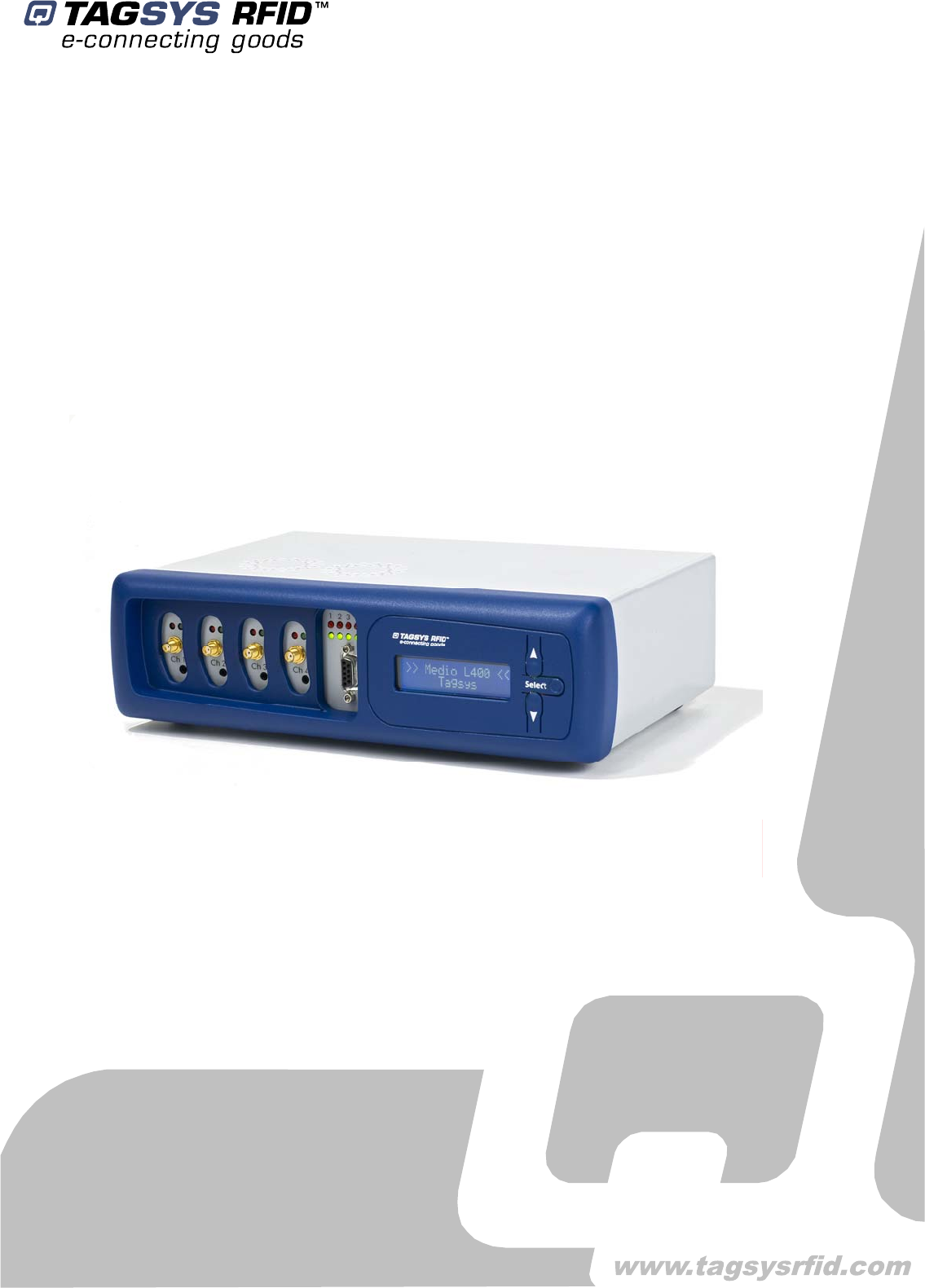
Medio L400
User's Guide
Revision 1.3
February 2008
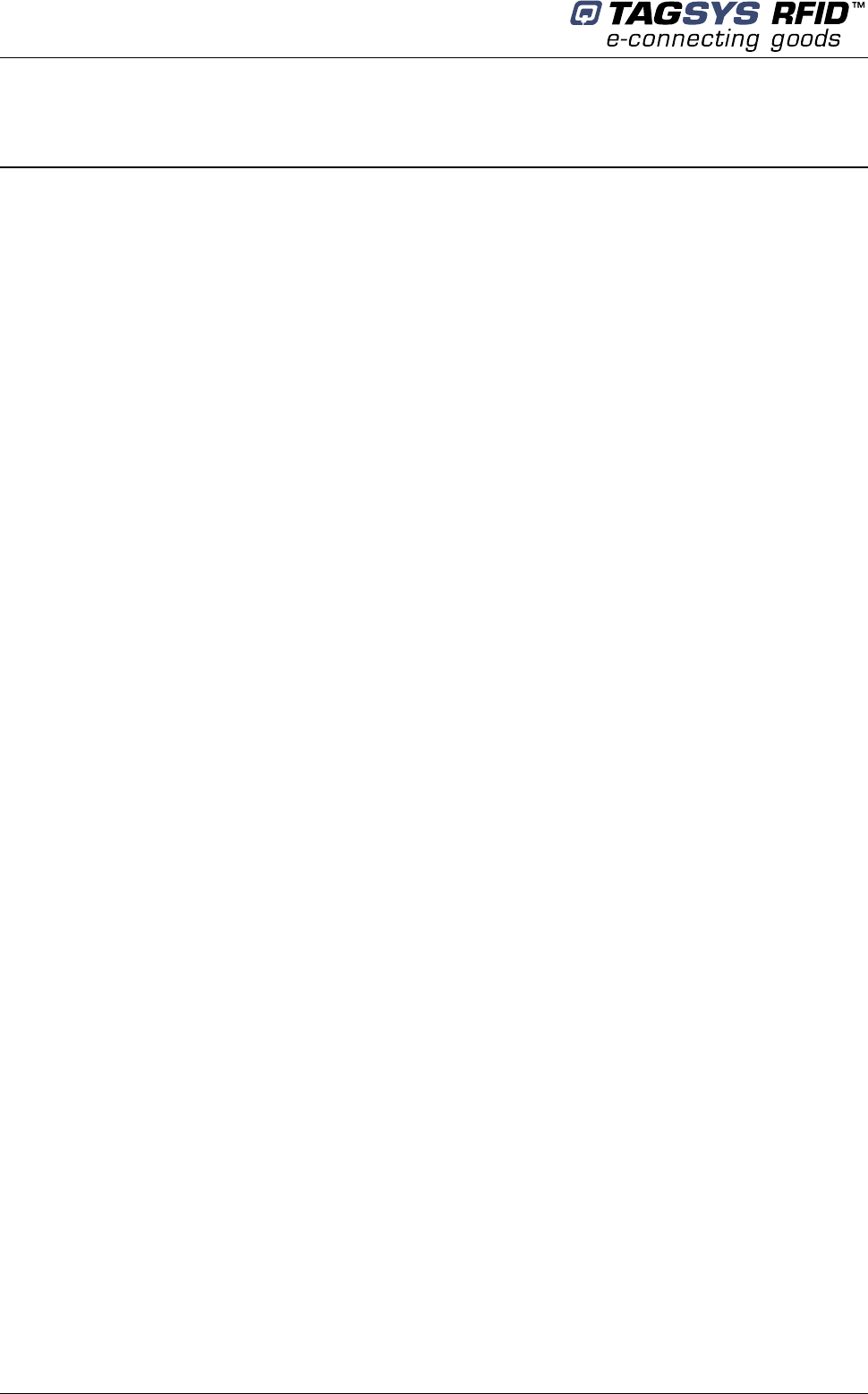
Medio L400
2/50 Revision 1.3 February 2008
Publishing Information
Disclaimer and Limitation of Liability
All information herein is either public information or is the property of and owned solely by TAGSYS who shall have and
keep the sole right to file patent applications or any other kind of intellectual property protection in connection with such
information.
Nothing herein shall be construed as implying or granting to you any rights, by license, grant or otherwise, under any
intellectual and/or industrial property rights of or concerning any of TAGSYS’ information.
This document can be used for informational, non-commercial, internal and personal use only provided that:
The copyright notice below, the confidentiality and proprietary legend and this full warning notice appear in all
copies.
This document shall not be posted on any network computer or broadcast in any media and no modification of any
part of this document shall be made.
Use for any other purpose is expressly prohibited and may result in severe civil and criminal liabilities.
The information contained in this document is provided “AS IS” without any warranty of any kind. Unless otherwise
expressly agreed in writing, TAGSYS makes no warranty as to the value or accuracy of information contained herein.
The document could include technical inaccuracies or typographical errors. Changes are periodically added to the
information herein. Furthermore, TAGSYS reserves the right to make any change or improvement in the specifications
data, information, and the like described herein, at any time.
Therefore TAGSYS assumes no liability and is not responsible for customer applications or product or software which
includes TAGSYS products.
TAGSYS HEREBY DISCLAIMS ALL WARRANTIES AND CONDITIONS WITH REGARD TO THE INFORMATION
CONTAINED HEREIN, INCLUDING ALL IMPLIED WARRANTIES OF MERCHANTABILITY, FITNESS FOR A
PARTICULAR PURPOSE, TITLE AND NON-INFRINGEMENT. IN NO EVENT SHALL TAGSYS BE LIABLE, WHETHER
IN CONTRACT, TORT OR OTHERWISE, FOR ANY INDIRECT, SPECIAL OR CONSEQUENTIAL DAMAGES OR ANY
DAMAGES WHATSOEVER INCLUDING BUT NOT LIMITED TO DAMAGES RESULTING FROM LOSS OF USE,
DATA, PROFITS, REVENUES, OR CUSTOMERS, ARISING OUT OF OR IN CONNECTION WITH THE USE OR
PERFORMANCE OF INFORMATION CONTAINED IN THIS DOCUMENT.
TAGSYS does not and shall not warrant that this product/system/equipment will be resistant to all possible attacks, and
shall not incur, and disclaims, any liability in this respect. Even if each product is compliant with current security
standards in force on the date of their design, security mechanisms' resistance necessarily evolves according to the
state-of-the-art in security and notably under the emergence of new attacks. Under no circumstances shall TAGSYS be
held liable for any third party actions, and in particular in case of any successful attack against systems or equipment
incorporating TAGSYS products.
TAGSYS disclaims any liability with respect to security for direct, indirect, incidental or consequential damages that result
from any use of its products. It is further stressed that independent testing and verification by the person using the
product is particularly encouraged, especially in any application in which defective, incorrect, or insecure functioning
could result in damage to persons or property, denial of service, or loss of privacy.
© 2000-2008 TAGSYS. All rights reserved.
Microsoft, Visual C++, Windows, and Windows NT are either registered trademarks or trademarks of Microsoft
Corporation in the U.S.A. and/or other countries.
I-Code is a registered trademark of Philips.
Tag-It is a registered trademark of Texas Instruments.
TAGSYS and E-connectware are registered trademarks of TAGSYS
Printed in France.
TAGSYS – 180 Chemin de St Lambert, 13821 LA PENNE SUR HUVEAUNE, France.
Tel: +33 (0)4.91.27.57.00 / Fax: +33 (0)4.91.27.57.01
Document Reference: DOC12451A3
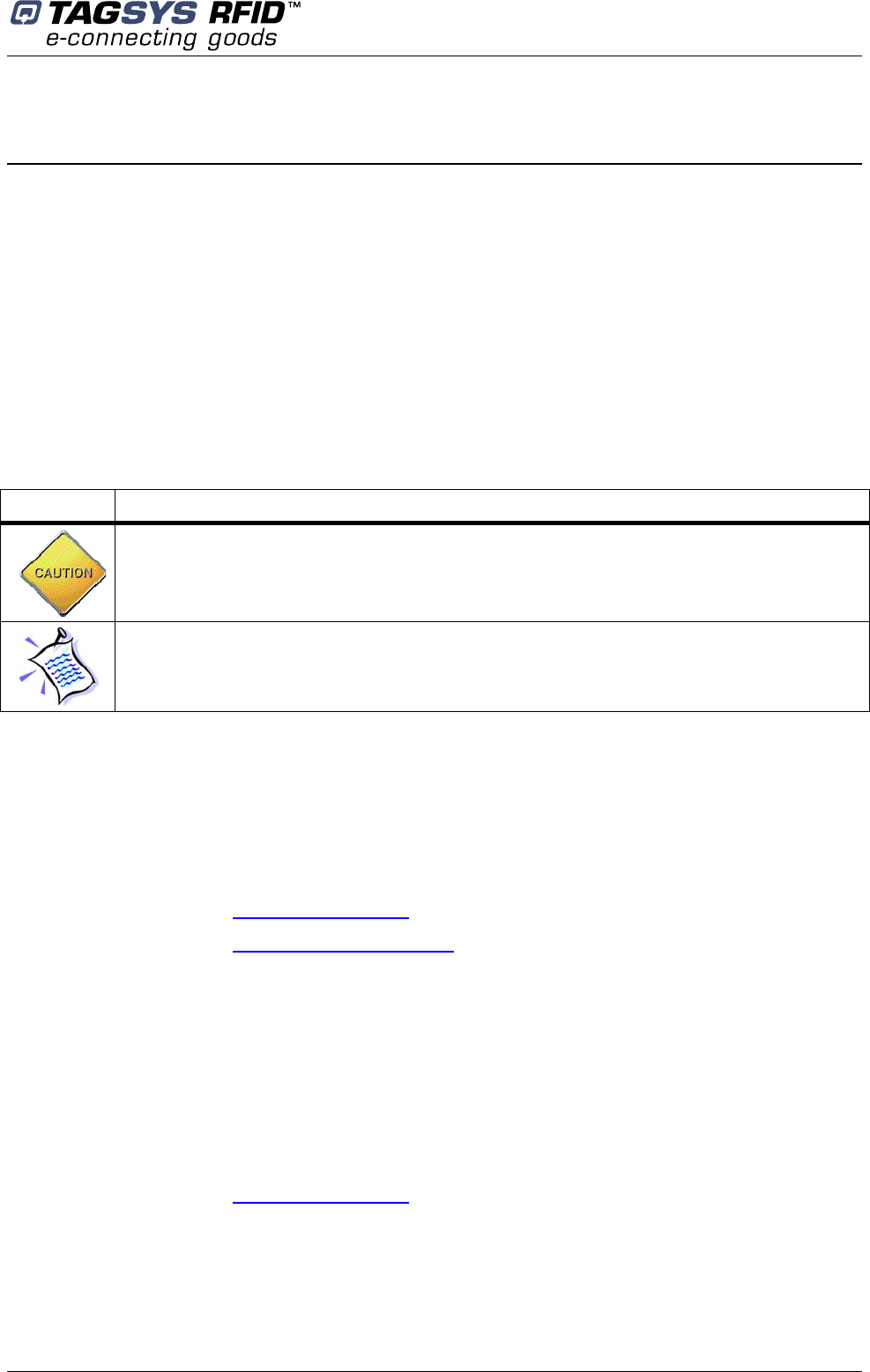
Read This First
February 2008 Revision 1.3 3/50
Read This First
Welcome to the TAGSYS range of products operating at the 13.56 MHz frequency. This range of
products is used to implement high-quality RFID systems for demanding applications.
This document provides information about how to install and use the Medio L400 reader.
Audience
This document requires familiarity with RFID technology. It is intended for people in charge of
installing and using the product.
Conventions
Symbol Meaning
CAUTION: A note that advises users that a specific action could result in the loss of data or
damage the hardware.
WARNING: A note that advises users that a specific action may result in physical harm.
A note that provides additional information that helps the user performs a task or obtains the
best performance from the product.
If you need assistance
Please contact your nearest TAGSYS sales representative or the TAGSYS welcome desk at:
Telephone: +33 (0)4 91 27 57 00
Fax: +33 (0)4 91 27 57 01
E-Mail: info@tagsysrfid.com
Website: http://www.tagsysrfid.com
Contact for Comments
We welcome your feedback to help us provide high quality documentation.
For technical comments, please contact our welcome desk:
Telephone: +33 (0)4 91 27 57 00
Fax: +33 (0)4 91 27 57 01
E-Mail: info@tagsysrfid.com
Please remember to quote the Document Reference Number DOC12451A3, your job title and your
company.

Medio L400
4/50 Revision 1.3 February 2008
Quality Issues
TAGSYS implements stringent quality controls at all stages of its manufacturing process. However,
should you find a defect with this product, please notify your TAGSYS Quality Service
representative using the dedicated Product Return Form.
Telephone: +33 (0)4 91 27 57 36
Fax: +33 (0)4 91 27 57 02
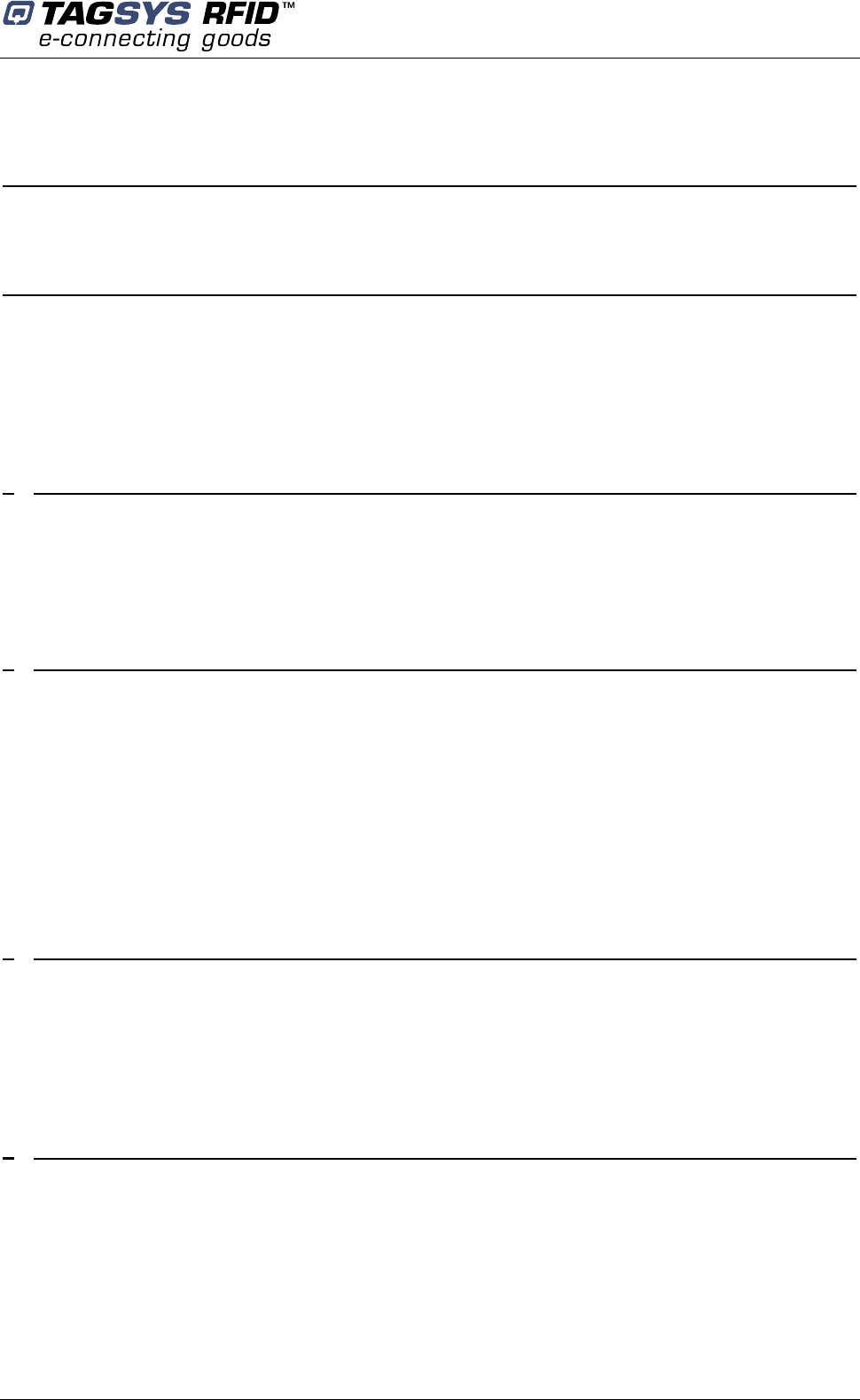
Read This First
February 2008 Revision 1.3 5/50
Table of Contents
PUBLISHING INFORMATION __________________________________________________________ 2
DISCLAIMER AND LIMITATION OF LIABILITY___________________________________________________ 2
READ THIS FIRST ____________________________________________________________________ 3
AUDIENCE_____________________________________________________________________________ 3
CONVENTIONS _________________________________________________________________________ 3
IF YOU NEED ASSISTANCE ________________________________________________________________ 3
CONTACT FOR COMMENTS _______________________________________________________________ 3
QUALITY ISSUES _______________________________________________________________________ 4
1 FOR YOUR SAFETY _______________________________________________________________ 7
1.1 GENERAL USE ____________________________________________________________________ 7
1.2 CARE AND MAINTENANCE ___________________________________________________________ 7
1.3 IMPORTANT SAFETY INFORMATION ____________________________________________________ 8
1.3.1 OPERATING ENVIRONMENT ________________________________________________________ 8
2 CERTIFICATION___________________________________________________________________ 9
2.1 OCCUPATIONAL HEALTH AND SAFETY NOTICES _________________________________________ 9
2.2 REGULATORY NOTICES _____________________________________________________________ 9
2.2.1 IN EUROPE (CE AND RTTE DIRECTIVES)_____________________________________________ 9
2.2.2 FCC ID CROSS REFERENCE TABLE ________________________________________________ 10
2.2.3 IN USA (FCC DIRECTIVE)________________________________________________________ 12
2.2.4 IN CANADA_____________________________________________________________________ 13
2.3 ROHS AND WEEE DIRECTIVES _____________________________________________________ 13
2.3.1 ROHS (RESTRICTION OF THE USES OF CERTAIN HAZARDOUS SUBSTANCES)_______________ 13
2.3.2 WEEE (WASTE ELECTRICAL AND ELECTRONIC EQUIPMENT)____________________________ 13
3 OVERVIEW ______________________________________________________________________ 14
3.1 KEY FEATURES ___________________________________________________________________ 15
3.2 DELIVERY _______________________________________________________________________ 15
3.3 PHYSICAL DESCRIPTION ___________________________________________________________ 16
3.3.1 FRONT PANEL __________________________________________________________________ 16
3.3.2 REAR PANEL ___________________________________________________________________ 20
4 INSTALLATION __________________________________________________________________ 21
4.1 MECHANICAL ASPECTS ____________________________________________________________ 21
4.2 CABLING REQUIREMENTS __________________________________________________________ 21
4.3 USING USB INTERFACE ____________________________________________________________ 22
4.3.1 INSTALLING USB DRIVERS________________________________________________________ 22
4.3.2 USING THE USB INTERFACE ______________________________________________________ 22
4.4 USING RS-232 INTERFACE _________________________________________________________ 22
4.5 USING 10/100 ETHERNET INTERFACE ________________________________________________ 22
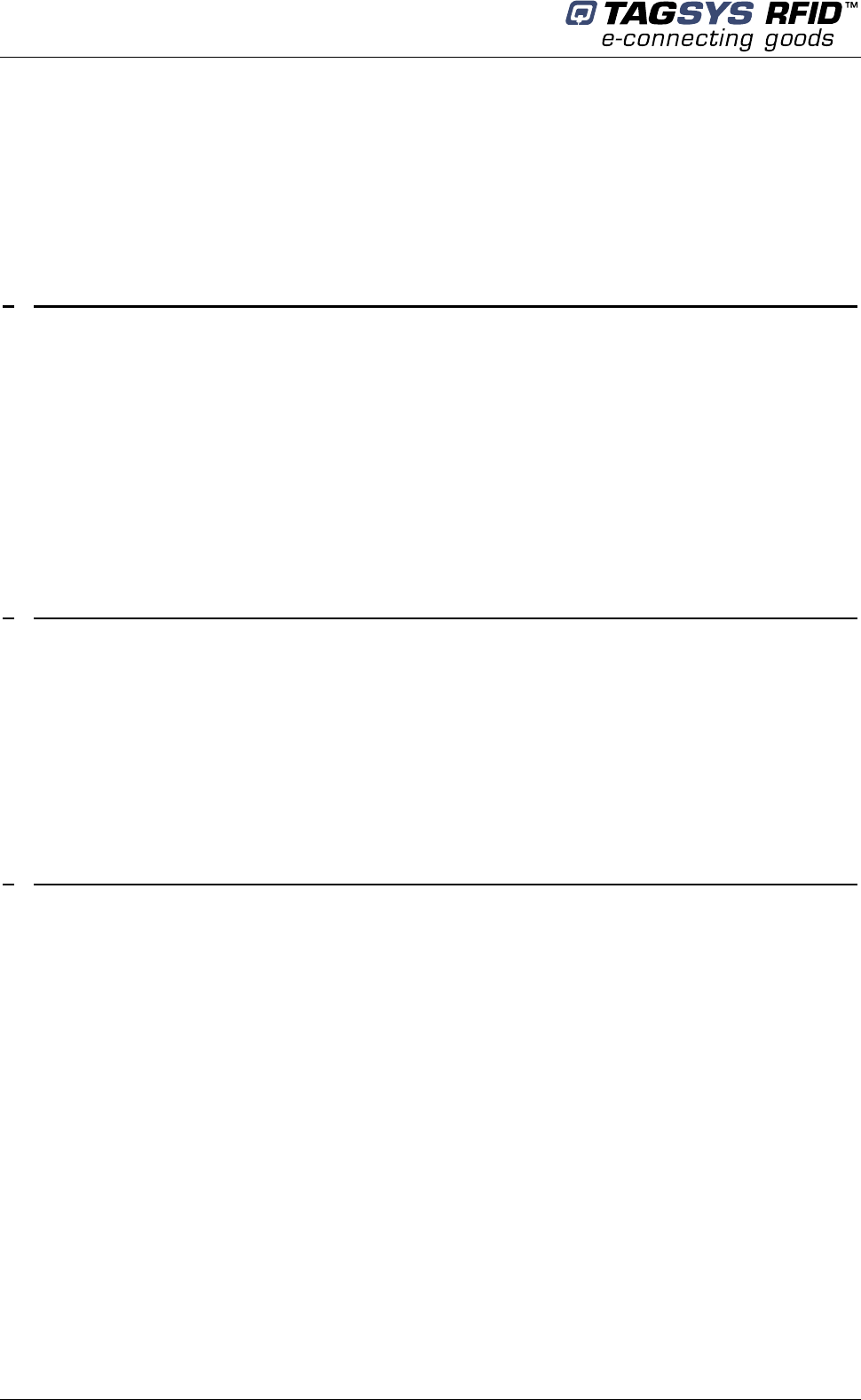
Medio L400
6/50 Revision 1.3 February 2008
4.6 RESTORING FACTORY CONFIGURATION _______________________________________________ 23
4.7 RUNNING TAGSYS EXPLORER FOR THE FIRST TIME _____________________________________ 23
4.7.1 INSTALLING TAGSYS EXPLORER ___________________________________________________ 23
4.7.2 CONNECTING TO A DEVICE USING TAGSYS EXPLORER WIZARD __________________________ 25
4.7.3 READING THE UID OF ISO 15693 TAGS _____________________________________________ 31
4.7.4 READING AND WRITING ISO 15693 TAG MEMORY _____________________________________ 32
4.7.5 UPGRADING SYSTEM OR RADIO FIRMWARE __________________________________________ 33
5 ADVANCED NOTIONS ____________________________________________________________ 36
5.1 READER ARCHITECTURE ___________________________________________________________ 36
5.2 READER TO HOST PROTOCOLS______________________________________________________ 37
5.2.1 TAGSYS STXNG _______________________________________________________________ 37
5.2.2 HEARTBEAT____________________________________________________________________ 37
5.2.3 TELNET________________________________________________________________________ 38
5.2.4 SERIAL CONSOLE _______________________________________________________________ 38
5.2.5 STANDALONE MODE _____________________________________________________________ 39
5.3 READER OPERATION PRINCIPLES ____________________________________________________ 39
5.3.1 NOTION OF READ MODES _________________________________________________________ 39
5.3.2 NOTION OF EVENTS______________________________________________________________ 40
6 TECHNICAL SPECIFICATIONS ____________________________________________________ 42
6.1 TECHNICAL DATA _________________________________________________________________ 42
6.2 MECHANICAL DATA________________________________________________________________ 43
6.3 RS232 CONNECTOR ______________________________________________________________ 44
6.4 GPIO CONNECTOR _______________________________________________________________ 45
6.4.1 PIN ASSIGNMENT________________________________________________________________ 45
6.4.2 ELECTRICAL CHARACTERISTICS ___________________________________________________ 45
6.4.3 USING INPUTS __________________________________________________________________ 45
6.4.4 USING OUTPUTS ________________________________________________________________ 47
7 WARRANTY CONDITIONS ________________________________________________________ 48
7.1 WARRANTY ______________________________________________________________________ 48
7.2 WARRANTY EXCLUSIONS ___________________________________________________________ 48
7.2.1 GENERAL PROVISIONS ___________________________________________________________ 49
7.2.2 HOW TO RETURN DEFECTIVE PRODUCTS ____________________________________________ 49
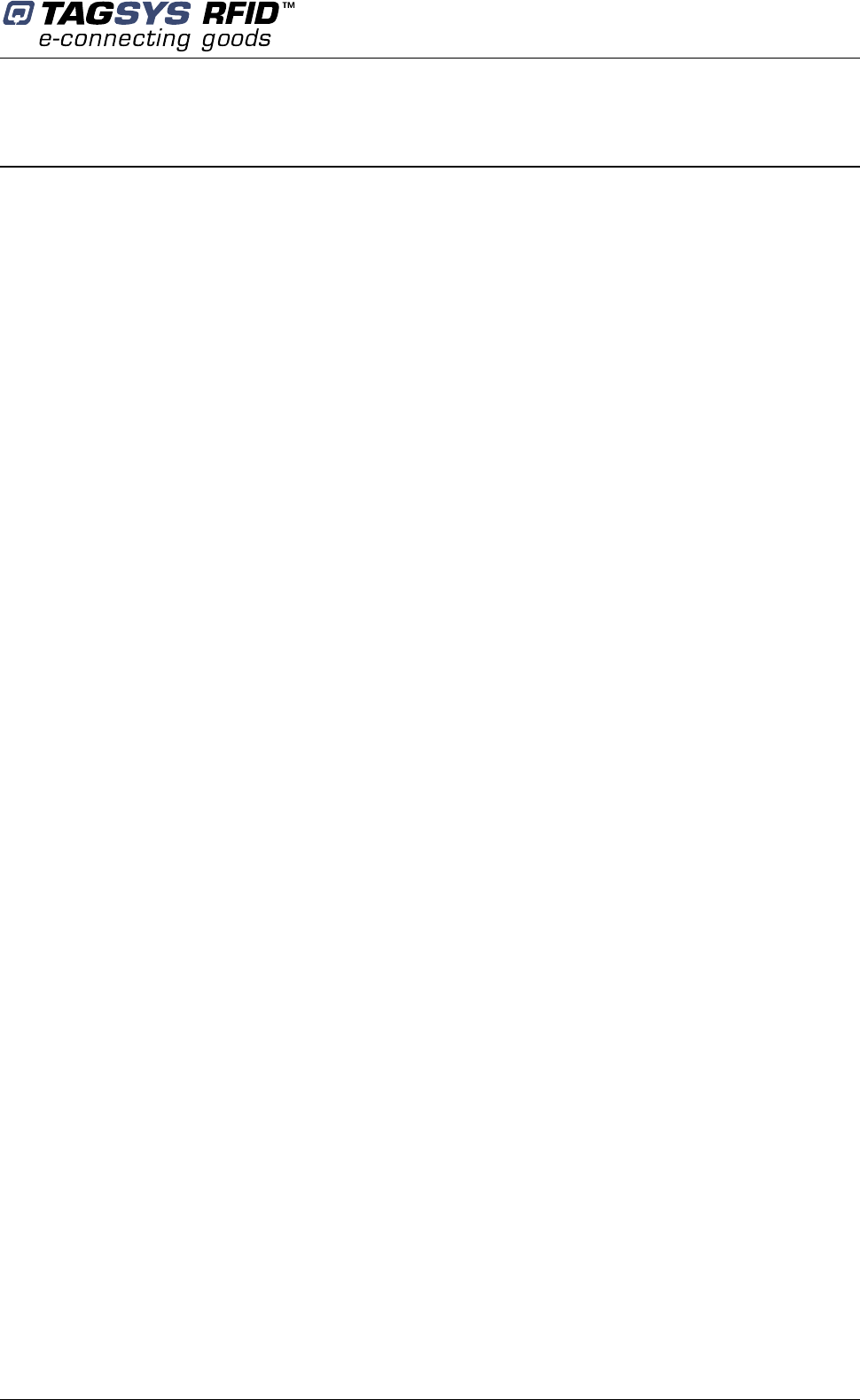
For Your Safety
February 2008 Revision 1.3 7/50
1 For Your Safety
1.1 General Use
The Medio L400 reader is designed to be reliable and to provide continuous, trouble-free service.
Please observe the following general tips:
Take care not to scratch the device. Keep the device clean. When working with the device,
use only TAGSYS-approved accessories.
This device is not waterproof and should not be exposed to rain or moisture. Under extreme
conditions, water may enter the circuitry.
Protect the device from extreme temperatures. For example, do not place the device in a
windowed area where the sun may cause extreme temperatures, and keep it away from
heaters and other heat sources.
Do not store or use the device in any location that is extremely dusty, damp, or wet.
Use a soft, damp cloth to clean the device. If the surface of the device becomes soiled,
clean it with a soft cloth moistened with a diluted window-cleaning solution.
1.2 Care and Maintenance
This device should be handled with care. The suggestions below will increase the lifetime of this
device.
• Keep the device and all parts and accessories out of the reach of small children.
• Keep the device dry. Precipitation, humidity and liquids contain minerals that will corrode
electronic circuits.
• Do not use or store the device in dusty, dirty areas. Its moving parts can be damaged.
• Do not store in hot areas. High temperatures can shorten the life of electronic devices,
damage batteries and warp or melt certain plastics.
• Do not store in cold areas. When the device warms up (to its normal temperature), moisture
can form inside the device, which may damage electronic circuit boards.
• Do not attempt to open the device. Non-professional handling of the device may damage it
and will void the TAGSYS warranty.
• Handle the device with care. Shock and vibration may break internal circuit boards.
• Do not clean the device with harsh chemicals, cleaning solvents or strong detergents.
Gently wipe the device with a soft cloth slightly dampened in a mild soap-and-water
solution.
• Do not paint the device. Paint may clog the device’s moving parts and prevent proper
operation. Paint with metallic contents may limit device performances.
• If the device or any accessory are not working properly, take it to your nearest qualified
TAGSYS representative.

Medio L400
8/50 Revision 1.3 February 2008
1.3 Important Safety Information
1.3.1 Operating Environment
When connecting the device or any accessory to another device, read its user’s guide for detailed
safety instructions. Do not connect incompatible products.
As with all RF equipment, users are advised that the equipment should only be used in its normal
operating mode described in this document.
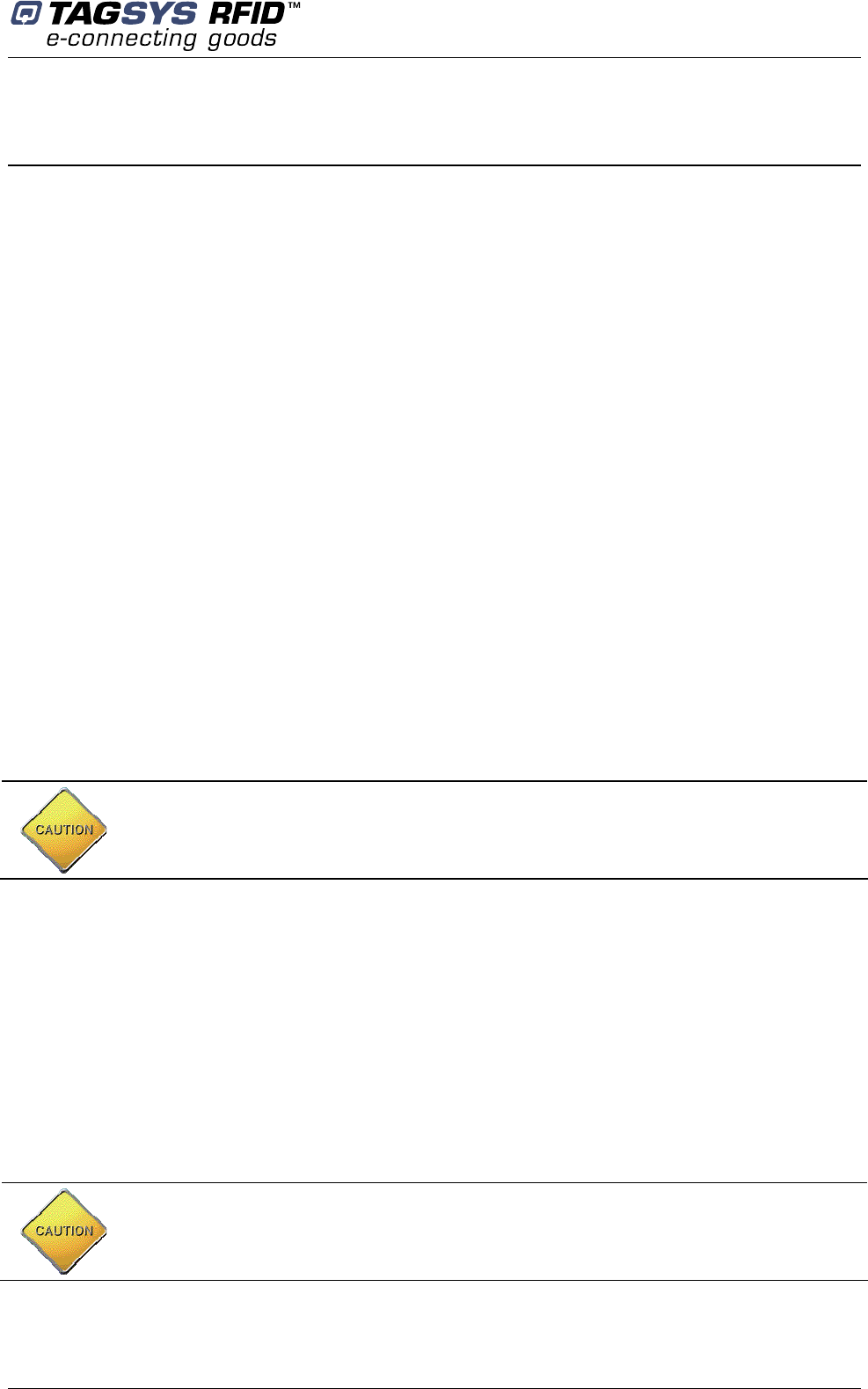
Certification
February 2008 Revision 1.3 9/50
2 Certification
2.1 Occupational Health and Safety Notices
TAGSYS Products have been designed not to exceed the limits given in the European Standard
EN 50364 “Limitation of human exposure to electromagnetic fields from devices used in Electronic
Article Surveillance (EAS), Radio Frequency Identification (RFID) and similar applications” in
conjunction with the European Standard EN 50357 describing how to evaluate the exposure level.
It is the responsibility of the TAGSYS Partner to install the Medio L400 as described in TAGSYS
Documentation and with the appropriate antennas.
Modification of any TAGSYS System is prohibited without the written consent of TAGSYS.
Unauthorized modifications may void the conformity of the equipment to safety standards and will
void the TAGSYS warranty.
An RF fields survey has been carried out on all the TAGSYS System components, in accordance
with AS/NZS 2771.1: Radio Frequency Radiation, Part 1. According to this standard the maximum
allowable RF exposure levels (non-occupational) at 3 kHz to 300 GHz are 200 µW/cm2.
2.2 Regulatory Notices
An RFID system typically composed of an RF emission device such as the Medio L400 is subject
to national regulations that may differ by country.
One important item to consider is the maximum permissible magnetic field intensity at a distance of
10 meters from the antenna that must not exceed 42 dBµA/m in Europe and 38 dBµA/m in US.
The Medio L400 meets these limits.
2.2.1 In Europe (CE and RTTE Directives)
The Medio L400 complies (CE Declaration of Conformity granted) with the European EMC
directive.
The Medio L400 complies with the requirements of the Telecommunication Terminal Equipment
Act (FTEG) and the RTTE Directive 1995/5/EC.
It is the responsibility of the TAGSYS Reseller to install the Medio L400 as described in this
Reference guide or TAGSYS Documentation.
Any modification of the Medio L400 is prohibited without the written consent of TAGSYS.
Unauthorized modifications may void the conformity of the equipment to CE and RTTE Directives
and will void the TAGSYS warranty.
It is the responsibility of the TAGSYS Partner to install the Medio L400 as described in this
User’s Guide or in TAGSYS Documentation.
If a Medio L400 is further integrated in a different product, it is the responsibility of the
manufacturer of this complementary product to obtain the required approvals for this product.
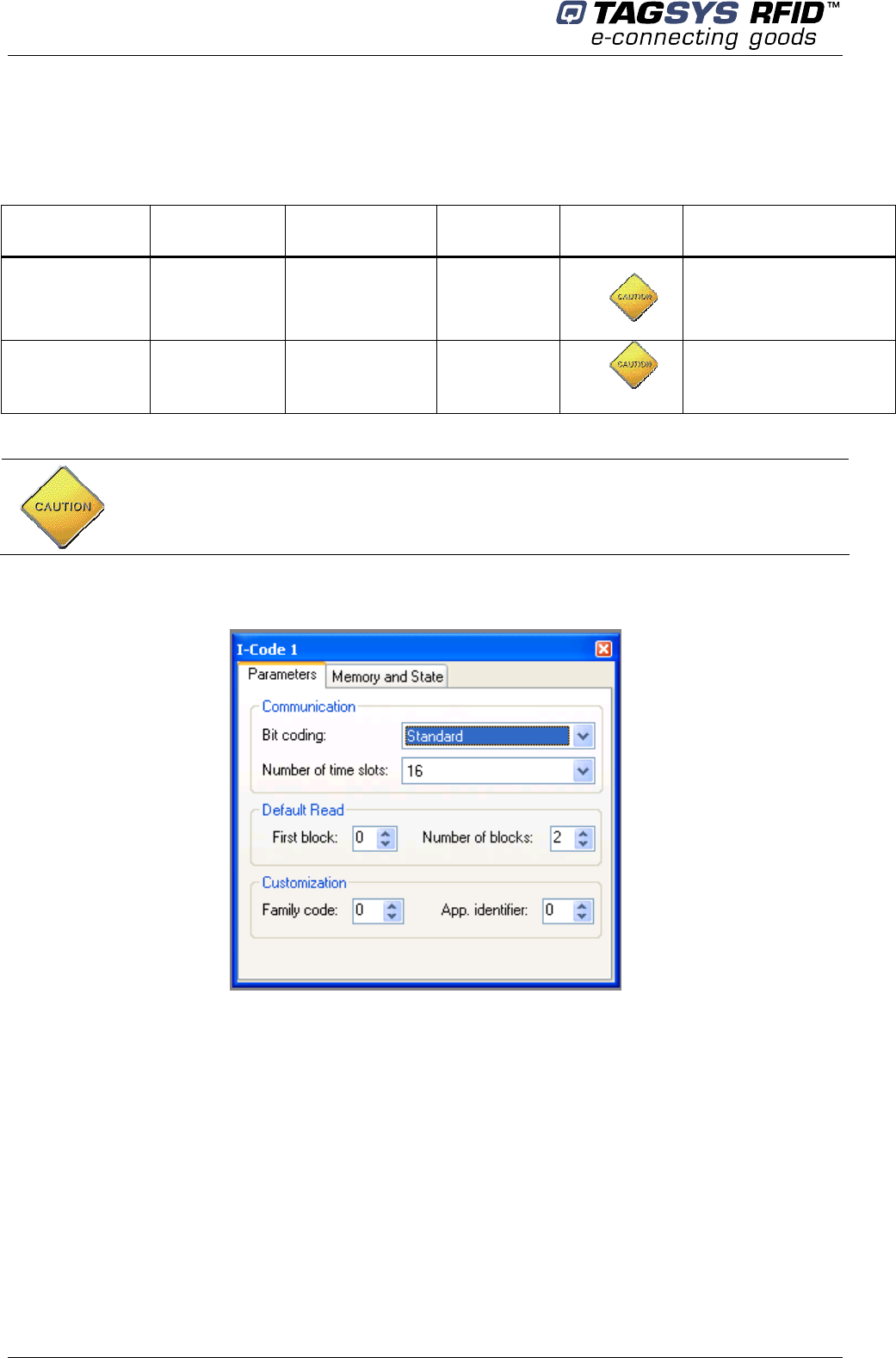
Medio L400
10/50 Revision 1.3 February 2008
2.2.2 FCC ID Cross Reference Table
It is the responsibility of the TAGSYS Partner to install the Medio L400 as described in the table
below, taking care of only installing the right antenna configuration with the right power settings.
Antenna
Configuration Outside
Dimension Channel Setting Multiplexing Max. Output
Power FCC ID
Aero LB
Antenna 250X250 Single Channel No 4W
QHKMEDIOL400CHAN2
Aero LC
Antenna 400X500 Single Channel No 2W QHKMEDIOL400CHAN2
In I-Code 1 (C270) parameters window set the uplink parameters as follow:
Bit Coding: “Standard” (1 out of 256 pulse)
To comply with band edge regulation, when used in vertical upright position the Aero LB and
Aero LC antennas can read tags in the following RFID uplink protocols configurations
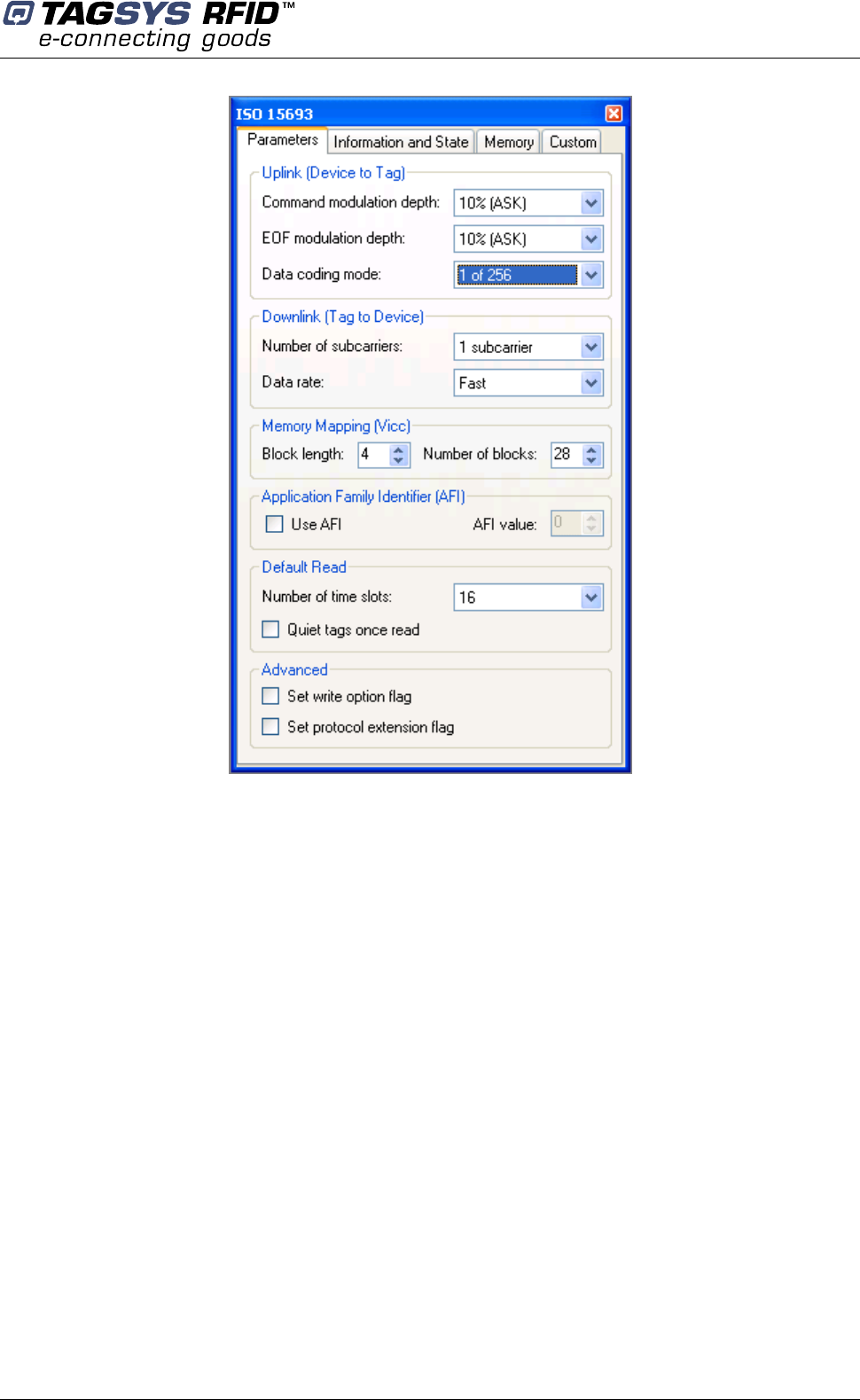
Certification
February 2008 Revision 1.3 11/50
In ISO15693 Parameters window set the uplink parameters as follow:
Command modulation depth: 10% (ASK)
EOF modulation depth: 10% (ASK)
Data coding mode: 1 of 256
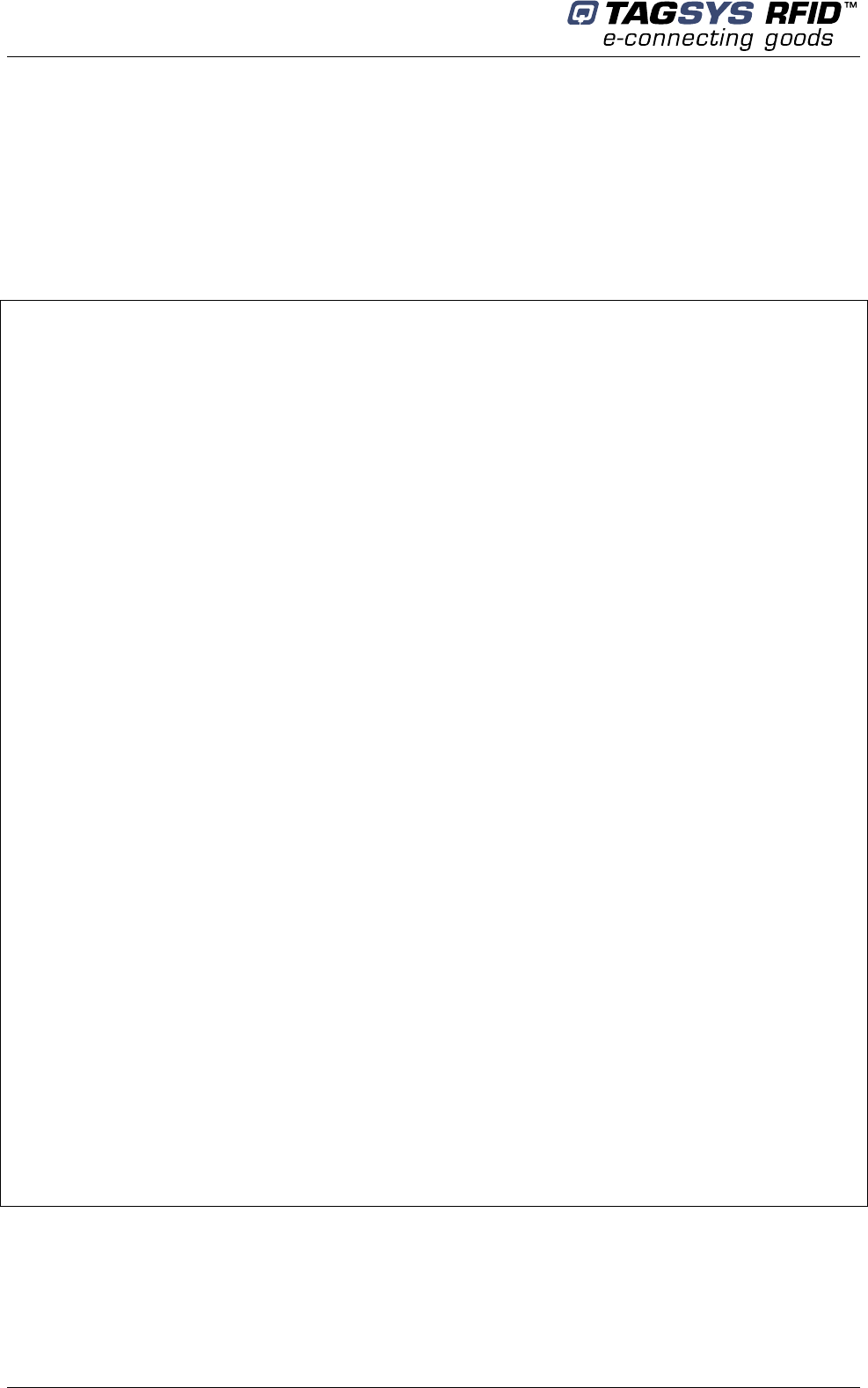
Medio L400
12/50 Revision 1.3 February 2008
2.2.3 In USA (FCC Directive)
The Medio L400 has been designed to comply with Part 15 of the FCC Rules. Furthermore typical
configurations based on the use of Single Antenna like Aero LB at 4W and Aero LC at 2 Watts,
have been successfully tested with Part 15 of the FCC rules (FCC ID Numbers are listed on all
system-mounted TAGSYS Antennas).
Medio L400-2
WARNING TO USERS IN THE UNITED STATES
FEDERAL COMMUNCIATIONS COMMISSION (FCC) RADIO
INTERFERENCE STATEMENT 47 CFR Section 15.105(b)
This equipment has been tested and found to comply with the limits for a Class B digital device,
pursuant to Part 15 of the FCC Rules. These limits are designed to provide reasonable protection
against harmful interference in a residential installation. This equipment generates, uses and can
radiate radio frequency energy and if not installed and used in accordance with the instructions
may cause harmful interference to radio communications. However, there is no guarantee that
interference will not occur in a particular installation. If this equipment does cause harmful
interference to radio or television reception, which can be determined by turning the equipment off
and on, the user is encouraged to try to correct the interference by one or more of the following
measures:
▪ Reorient or relocate the receiving antenna.
▪ Increase the separation between the equipment and receiver.
▪ Connect the equipment into an outlet on a circuit different to that to which the receiver is
connected.
▪ Consult the dealer or an experienced radio/TV technician for help.
NO UNAUTHORIZED MODIFICATIONS
47 CFR Section 15.21
CAUTION: This equipment may not be modified, altered, or changed in any way without signed
written permission from TAGSYS SA. Unauthorized modification may void the equipment
authorization from the FCC and will void the TAGSYS warranty.
ANTENNA REQUIREMENT
47 CFR Section 15.203
CAUTION: This equipment must be professionally installed. The installer shall be responsible for
ensuring that the proper antenna is employed so that the limits in this part are not exceeded. Non-
professional installation or installation of the equipment with an improper antenna may void the
equipment authorization from the FCC and will void the TAGSYS warranty.
Operation is subject to the following two conditions: (1) The system devices may not cause harmful
interference, and (2) The system devices must accept any interference received, including
interference that may cause undesired operation.
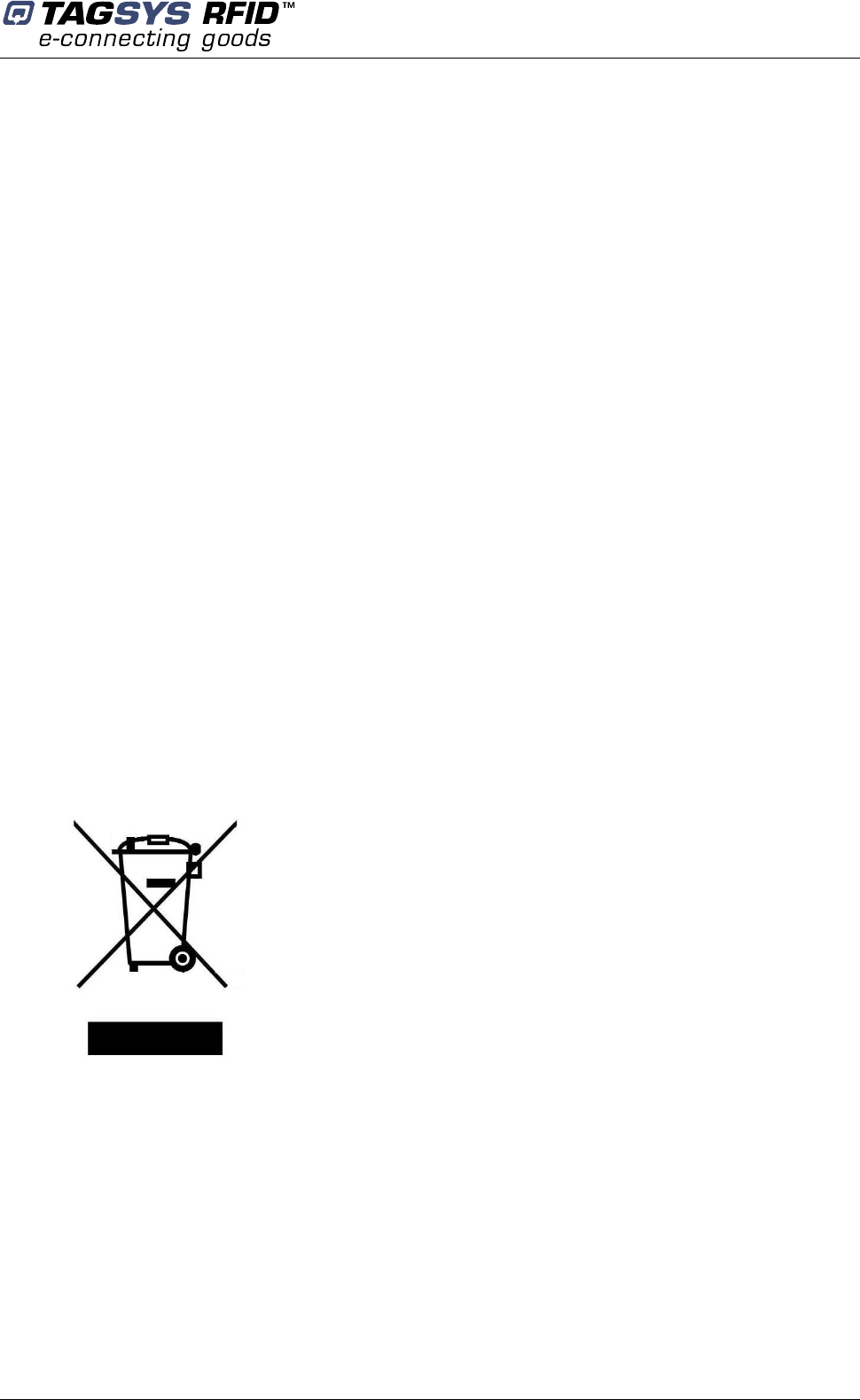
Certification
February 2008 Revision 1.3 13/50
2.2.4 In Canada
Cet appareil numérique de la classe B respecte toutes les exigences du Règlement sur le matériel
brouilleur du Canada.
This Class B digital apparatus meets all requirements of the Canadian Interference-Causing
Equipment Regulations.
2.3 RoHS and WEEE Directives
2.3.1 RoHS (Restriction of the uses of certain Hazardous Substances)
TAGSYS certifies that this product is compliant with the European Directive 2002/95/EC for the
restriction in Electric and Electronic Equipments (RoHS) of the use of the following hazardous
substances:
• Lead
• Mercury
• Cadmium
• Hexavalent Chromium
• Polybrominated biphenyl flame retardants
• Polybrominated diphenyl ether flame retardants
This declaration is based on information provided by our suppliers and subcontractors.
2.3.2 WEEE (Waste Electrical and Electronic Equipment)
This product bears the selective sorting symbol for waste electrical and
electronic equipment (WEEE)
This means that this product must be handled pursuant to European
Directive 2002/96/EC in order to be recycled or dismantled to minimize
its impact on the environment.
For further information, please contact your local or regional authorities.
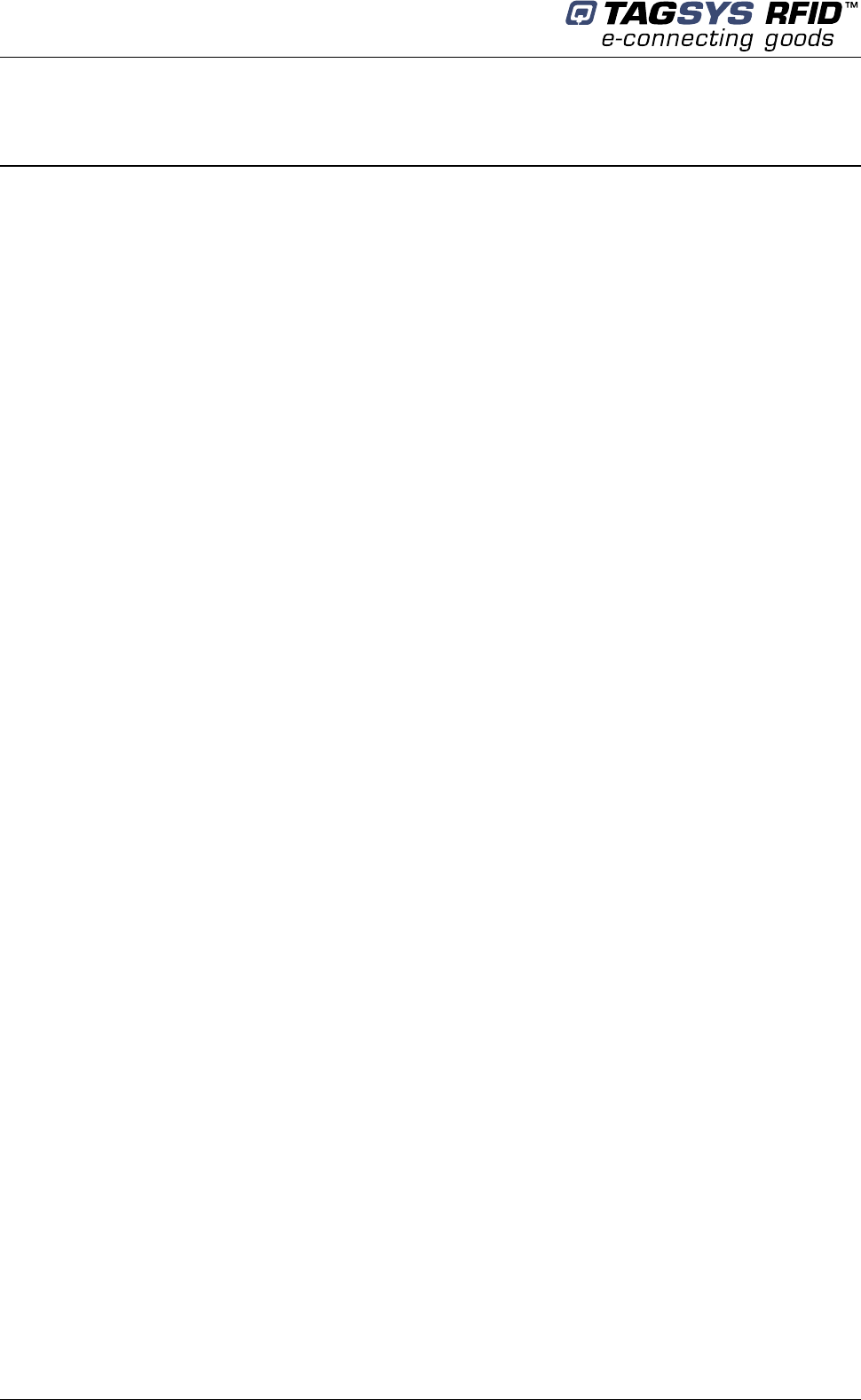
Medio L400
14/50 Revision 1.3 February 2008
3 Overview
The Medio L400 is a long-range 13.56MHz RFID reader intended for RFID applications requiring a
high performance, long range RFID infrastructure.
The L400 uses advances in Digital Signal Processing (DSP) and RF Front End technology to
achieve breakthrough performance in read range and read speed with industry leading signal to
noise ratio. The L400 has been specifically designed to operate in noisy environments such as
manufacturing plants and distribution facilities while maintaining the highest levels of data integrity
for item level track and trace, inventory management and security. Designed as a network device,
the L400 conserves critical network bandwidth by filtering tag data to remove redundancies before
transmitting to enterprise systems.
With breakthrough sensor technology and self diagnostic capability, the L400 is the industry’s first
self-correcting intelligent RFID reader. The L400 can be remotely managed and administered to
ensure you get the highest levels of performance from your RFID infrastructure. The L400 and e-
connectware, TAGSYS’ comprehensive set of management and administrative tools, create an
intelligent platform to allow you to manage your RFID infrastructure just as you do a voice or data
network to enable scalable, secure and persistent RFID Quality of Service.
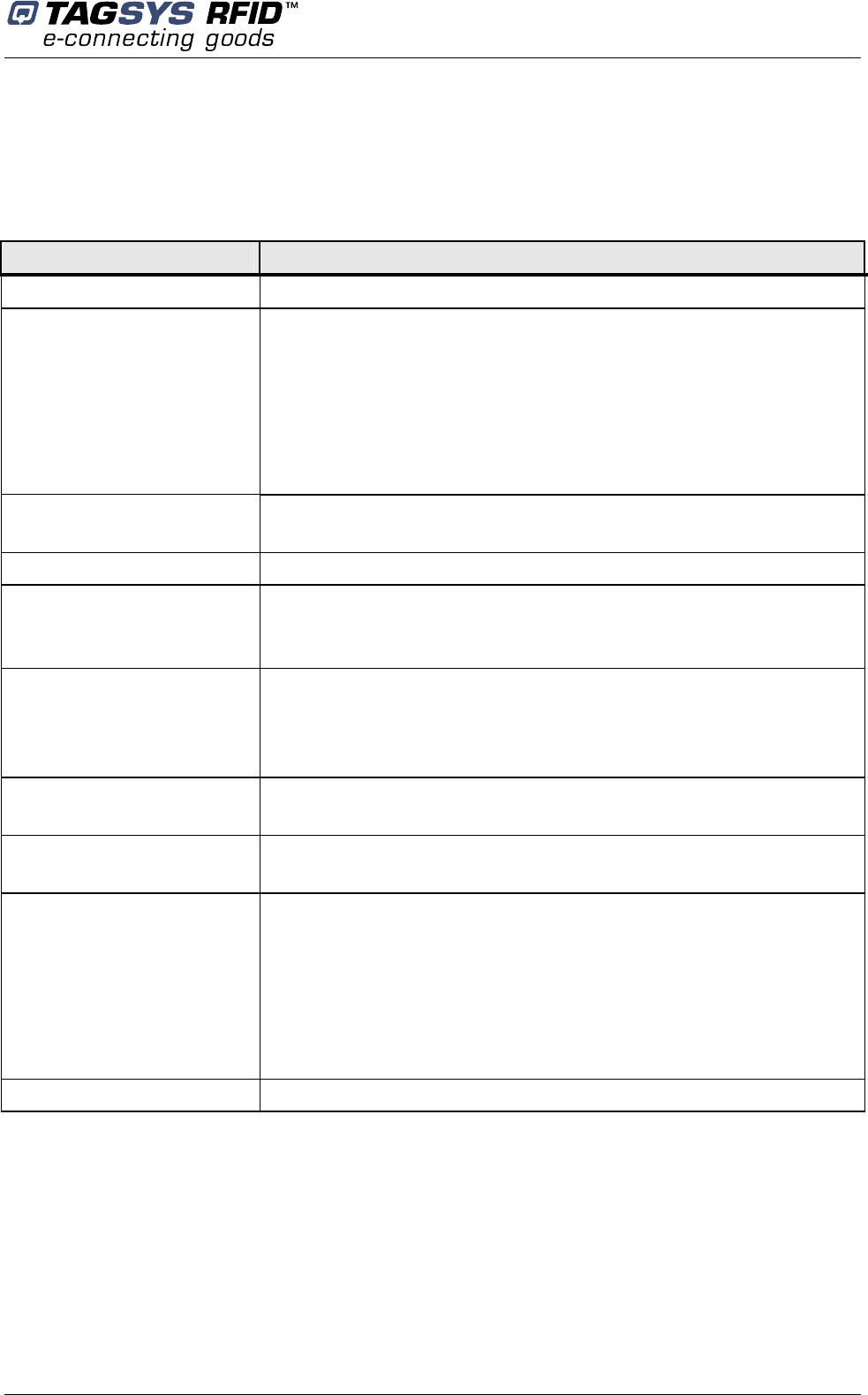
Overview
February 2008 Revision 1.3 15/50
3.1 Key Features
Table 1: Medio L400 Key Features
Description Medio L400
Operating Frequency 13.56 MHz
Chip Compatibility ISO15693
ISO18000-3 Mode 1
C370(I-Code SLI)
C270 (I-Code 1)
I-Code ePC
I-Code UID
Upgradable to the anticipated EPCglobal HF Gen2 Standard
Number of channels 2 (Medio L400-2)
4 (Medio L400-4)
RF Output Power 500mW to 5W (+/- 10%)
Communication Interfaces RS232 (up to 115200 bauds)
USB 1.1
10/100 Ethernet
Communication Protocols TAGSYS StxNG
Telnet & Serial Console
Standalone Mode
Heartbeat
I/O Ports (GPIO) 4 Inputs
4 Outputs
User Interface LCD Screen With Backlight (2x16 Characters)
Keypad (Up, Down, Select)
Remote Monitoring Many health indicators are remotely accessible, such as :
. System uptime
. Read/Write count (per channel)
. RF power amplifiers consumption
. RF power amplifiers operating temperature
. Antennas tuning status,
. Real-time Raw signal capture, …
Firmware Remotely upgradeable
3.2 Delivery
The Medio L400 reader kit contains the following items:
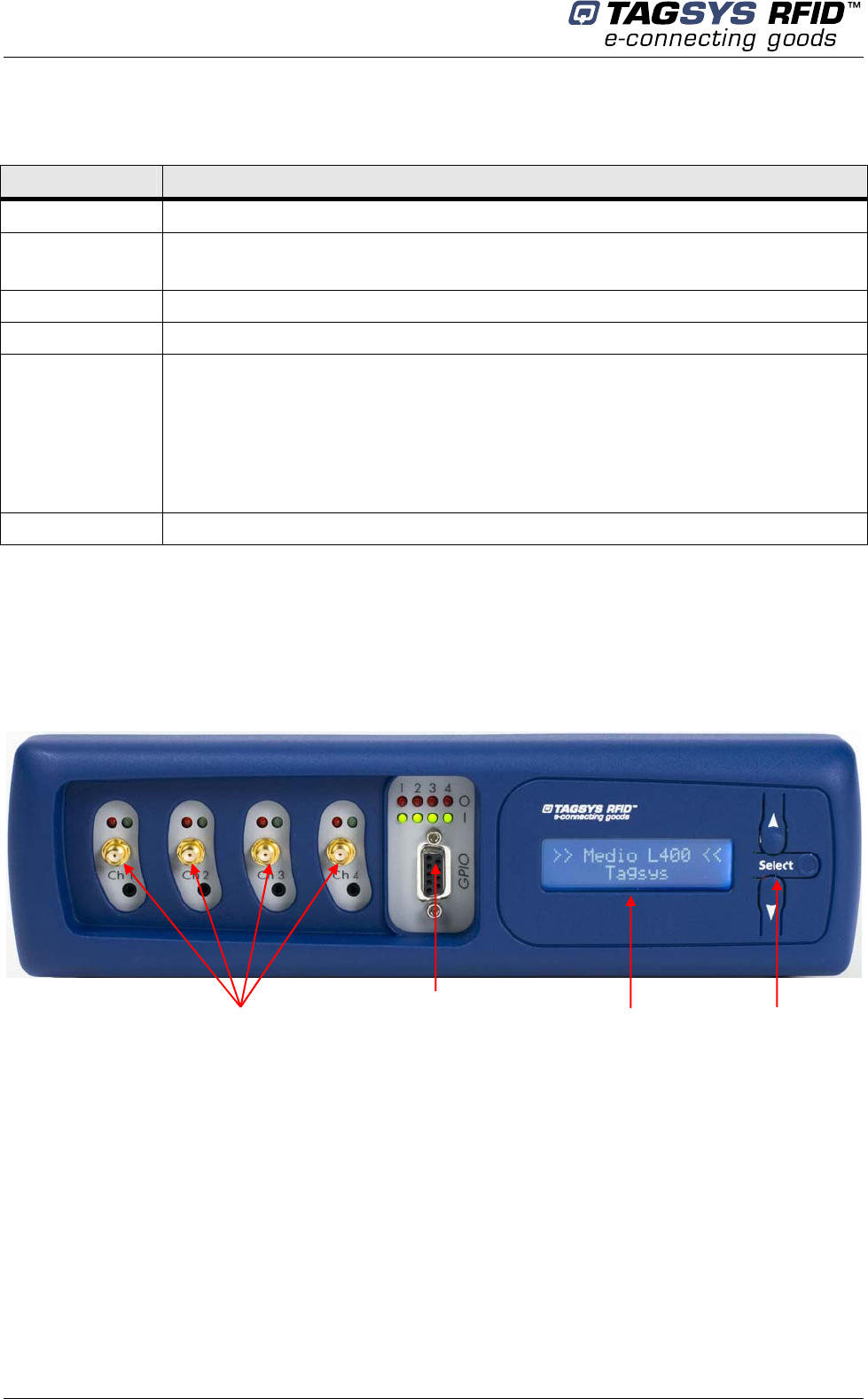
Medio L400
16/50 Revision 1.3 February 2008
Table 2: Package Contents
Quantity Item
1 Medio L400-2 or Medio L400-4 reader
2 (Medio L400-2)
4 (Medio L400-4)
SMA/BNC adapter
1 USB cable
1 24 V power supply
2 CD-ROMs including:
• Medio L400 User’s Guide & Designer’s guide
• USB Drivers for Windows® 2000, 2003, XP & Vista
• Tagsys Explorer software (reader configuration and upgrade on Windows® 9x,
NT®, 2000, XP & Vista platforms)
1 Welcome Letter / Product Return Form
3.3 Physical Description
3.3.1 Front Panel
The front panel is dedicated to RF & I/O connectors as well as a LCD & Keypad.
Figure 1: Front panel
• RF connectors and status LEDs :
The medio L400 can handle up to 2 (Medio L400-2) or 4 (Medio L400-4) antennas. The connectors
provided are SMA (SMA/BNC adapters are supplied with the reader). RF output power is software
selectable from 500mW to 5W (+/- 10%) in 250mW increments.
Two LEDs indicate current RF channel status (see Table 3)
GPIO Connector
& IO State LEDs
RF Connectors
& RF Status LEDs
LCD Screen Keypad
(
U
p,
Down
,
Select
)
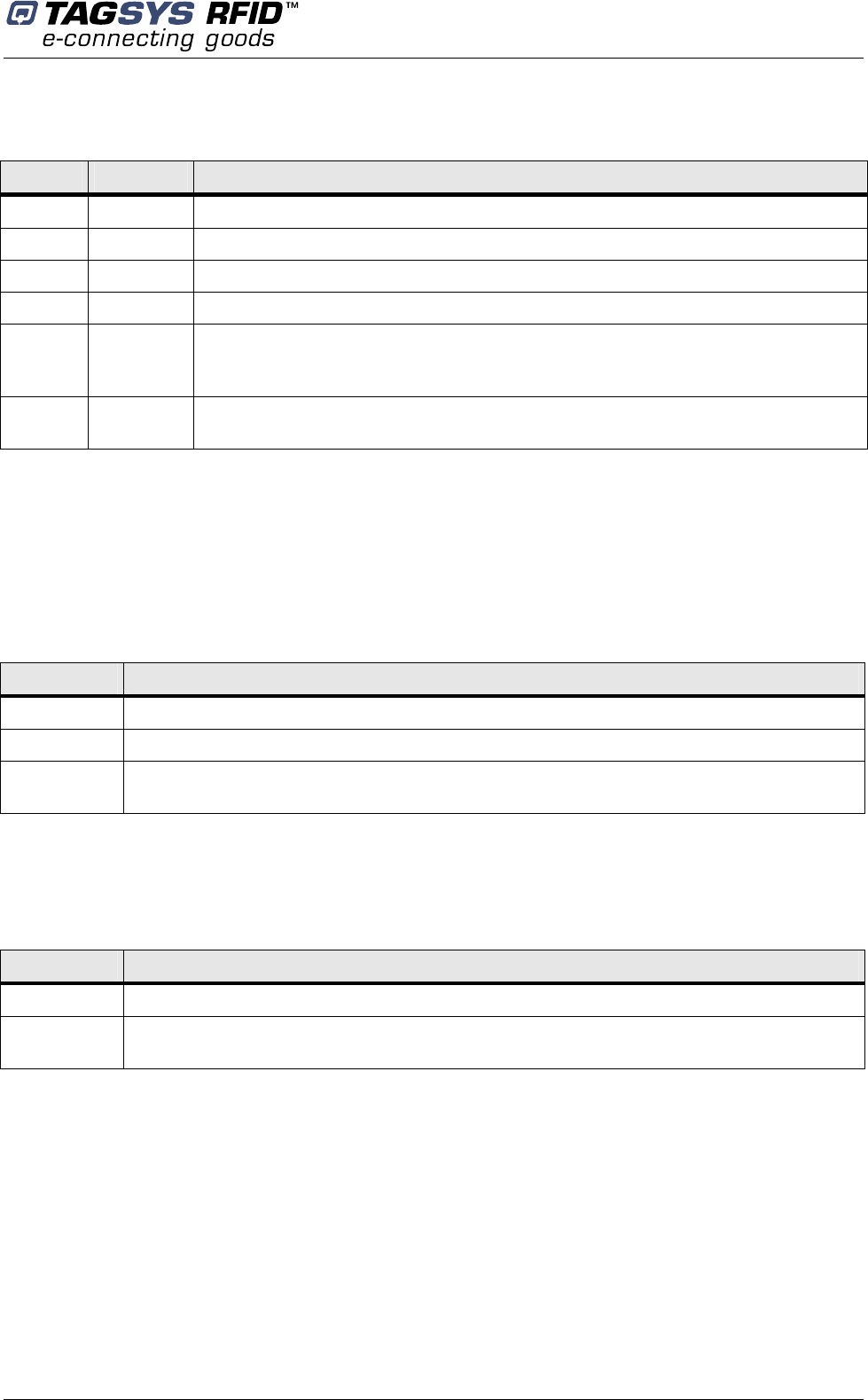
Overview
February 2008 Revision 1.3 17/50
Table 3: RF Status LEDs Description
Green Red Description
OFF OFF RF field is OFF.
ON OFF RF field is ON and channel antenna tuning and operating temperature are correct.
ON BLINKING RF field is ON but channel is close to maximum operating temperature.
ON ON RF field is ON but channel antenna tuning is incorrect. Check antenna.
OFF ON
RF field was ON but was automatically turned OFF to protect reader’s hardware
because a major antenna failure was detected (such as open-circuit or short
circuit).
OFF BLINKING
RF field was ON but was automatically turned OFF to protect reader’s hardware
because channel exceeded maximum operating temperature.
• GPIO connector and status LEDs :
A Female DB-9 connector on the reader’s front panel implements 4 digital inputs and 4 digital
outputs (N-Channel Open Drain). Please see Technical Specifications section for more details.
Four red LEDs (one for each output) indicate the current outputs state, see Table 4
Table 4: Outputs State LEDs description
Red Description
OFF Corresponding output is OFF.
ON Corresponding output is ON and properly operating.
BLINKING Corresponding output was ON but was automatically turned OFF to protect the reader’s
hardware because an overload condition was detected.
Four green LEDs (one for each input) indicate current inputs state (see Table 5)
Table 5: Inputs State LEDs description
Green Description
OFF Corresponding input is OFF (low level).
ON Corresponding input is ON (high level). This is default state when nothing is connected to
the inputs (inputs have internal 3.3V pull-up resistors).
• LCD and Keypad :
A LCD and Keypad are available on the reader’s front panel. They can be used to display reader
status information (status mode) or display custom user messages sent by the host system (user
message mode).
In “user message mode”, the host system controls the LCD and keypad and can display custom
messages or read keypad state by sending specific commands to the reader.
In “status mode”, the reader controls the LCD and keypad and displays various reader state
information (see Table 6). Information is organized in pages. Pressing the “Up” key jumps to the

Medio L400
18/50 Revision 1.3 February 2008
previous information page, pressing the “Down” key jumps to next information page, Holding the
“Select” key displays more information (if available).
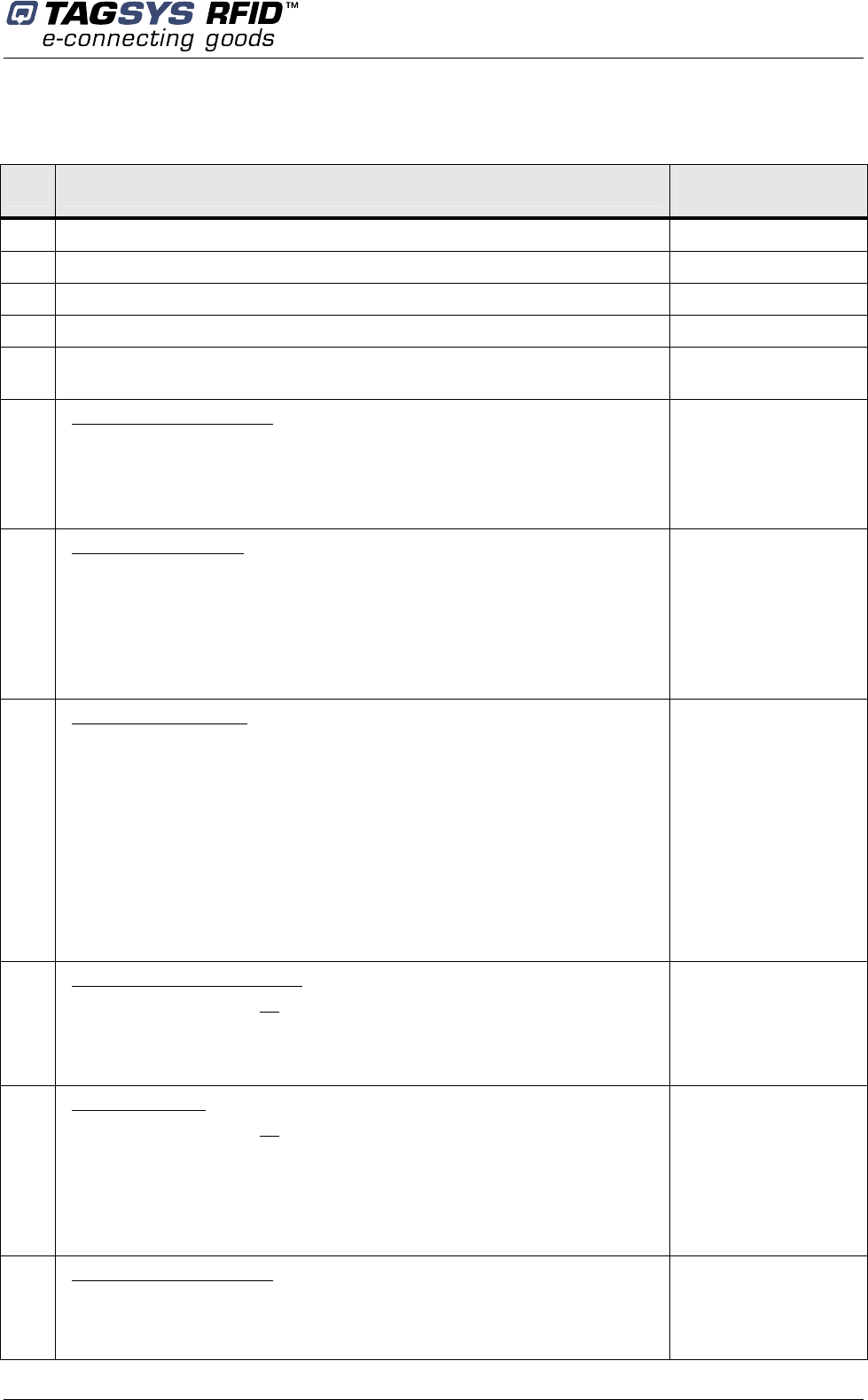
Overview
February 2008 Revision 1.3 19/50
Table 6: LCD Screen Pages description
Page Description (“Select” key not pressed) Description (“Select”
key pressed)
1 Product name N/A
2 Operating system version N/A
3 Radio firmware version N/A
4 Date and Time N/A
5 Current Ethernet IP address, or “Interface down” if ethernet interface is not
active (for example because cable is not connected)
Ethernet MAC
address
6
Heartbeat service status :
. “Running…” indicates heartbeat is enabled
. “Inactive” indicates heartbeat is disabled
. “Interface down” indicates ethernet interface is not active (for example
because the Ethernet cable is not connected).
N/A
7
Telnet service status :
. “Connected” indicates a host is currently connected to the reader using
the telnet protocol.
. “Waiting…” indicates telnet service is running and ready to accept
incoming connections
. “Interface down” indicates Ethernet interface is not active (for example
because the Ethernet cable is not connected).
N/A
8
StxNG service status :
. “Connected (P)” indicates a host is currently connected to the reader
using TAGSYS StxNG protocol on primary TCP port.
. “Connected (S)” indicates a host is currently connected to the reader
using TAGSYS StxNG protocol on secondary TCP port.
. “Connected (P+S)” indicates 2 hosts are currently connected to the reader
using TAGSYS StxNG protocol on both primary and secondary TCP ports.
. “Waiting…” indicates StxNG service is running and ready to accept
incoming connections on either primary or secondary TCP ports.
. “Interface down” indicates Ethernet interface is not active (for example
because the Ethernet cable is not connected).
N/A
9
Serial port status and speed :
. “Waiting…” indicates no host is currently communicating with the reader
using serial port.
. “Connected” indicates a host is currently communicating with the reader
using serial port (either console or StxNG protocol)
N/A
10
USB port status :
. “Waiting…” indicates no host is currently communicating with the reader
using USB l port.
. “Connected” indicates a host is currently communicating with the reader
using USB port (either console or StxNG protocol)
. “Interface down” indicates USB interface is not active (for example
because the USB cable is not connected).
N/A
11
Standalone mode status :
. “Inactive” indicates standalone mode is not active
. “Running…” indicates standalone mode is currently active and reader
automatically reports tag reads through its serial port.
The total number of
tag reading events
since standalone
mode activation.
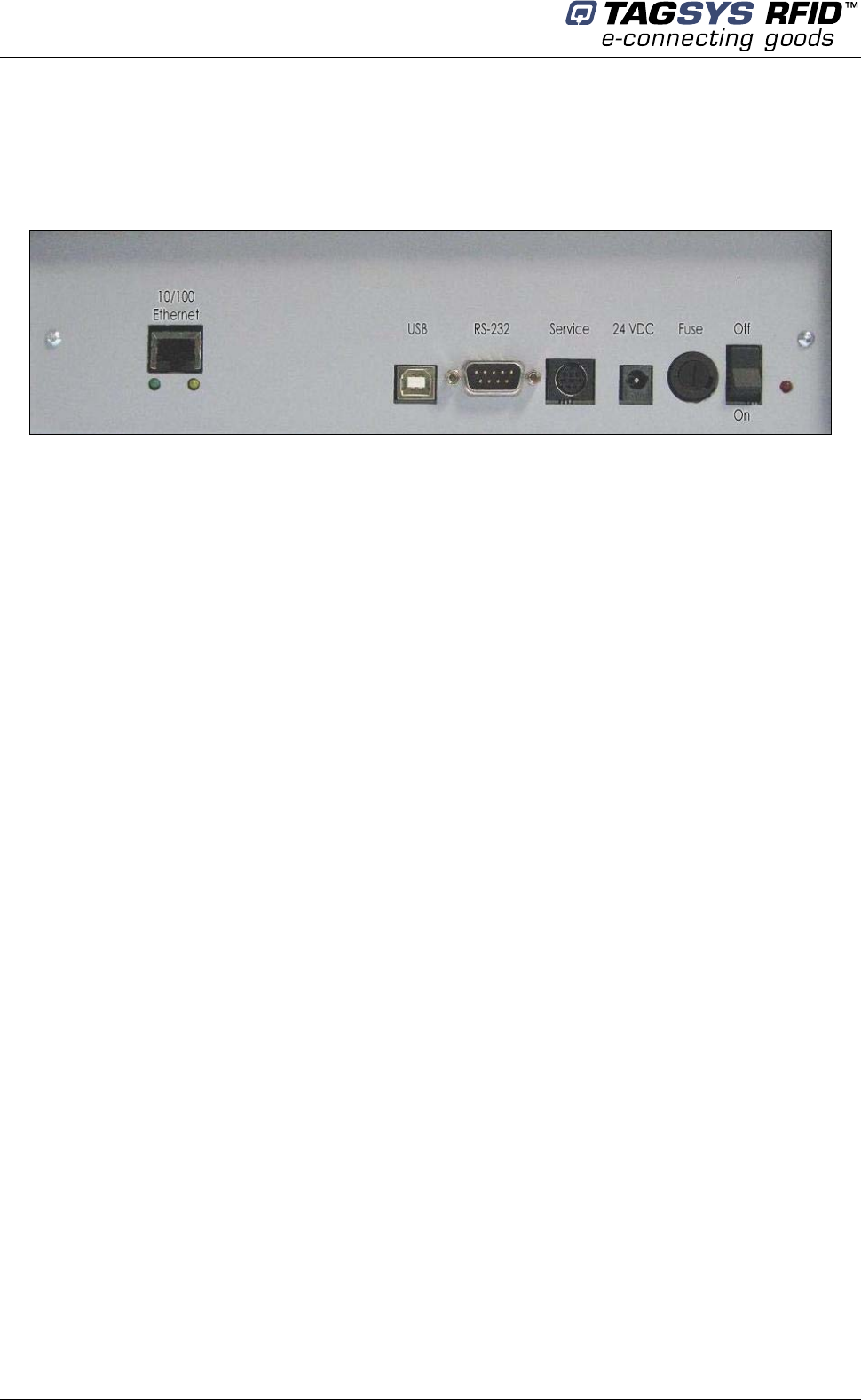
Medio L400
20/50 Revision 1.3 February 2008
3.3.2 Rear Panel
The rear panel is dedicated to the power supply and communication connectors.
Figure 2: Rear panel
10/ 100 Ethernet Connector
RJ 45 connector (Please refer to the Ethernet network cabling rules).
USB Connector
USB connector type B. Use standard A/B cable to connect to the host.
RS-232 Connector
Male DB-9 connector. Use a standard crossed RS-232 cable (NULL-MODEM) to connect to the
host. Please see Technical Specifications section for more details.
Service Connector
For TAGSYS internal use only. Do not connect any cables here.
24VDC Connector
A power supply bayonet connector. Only connect the provided power supply here.
Fuse holder
Fuse holder. Use only T2.5A, timelag rated fuses (24VDC minimum)
Off / On Switch
Power on/off switch.
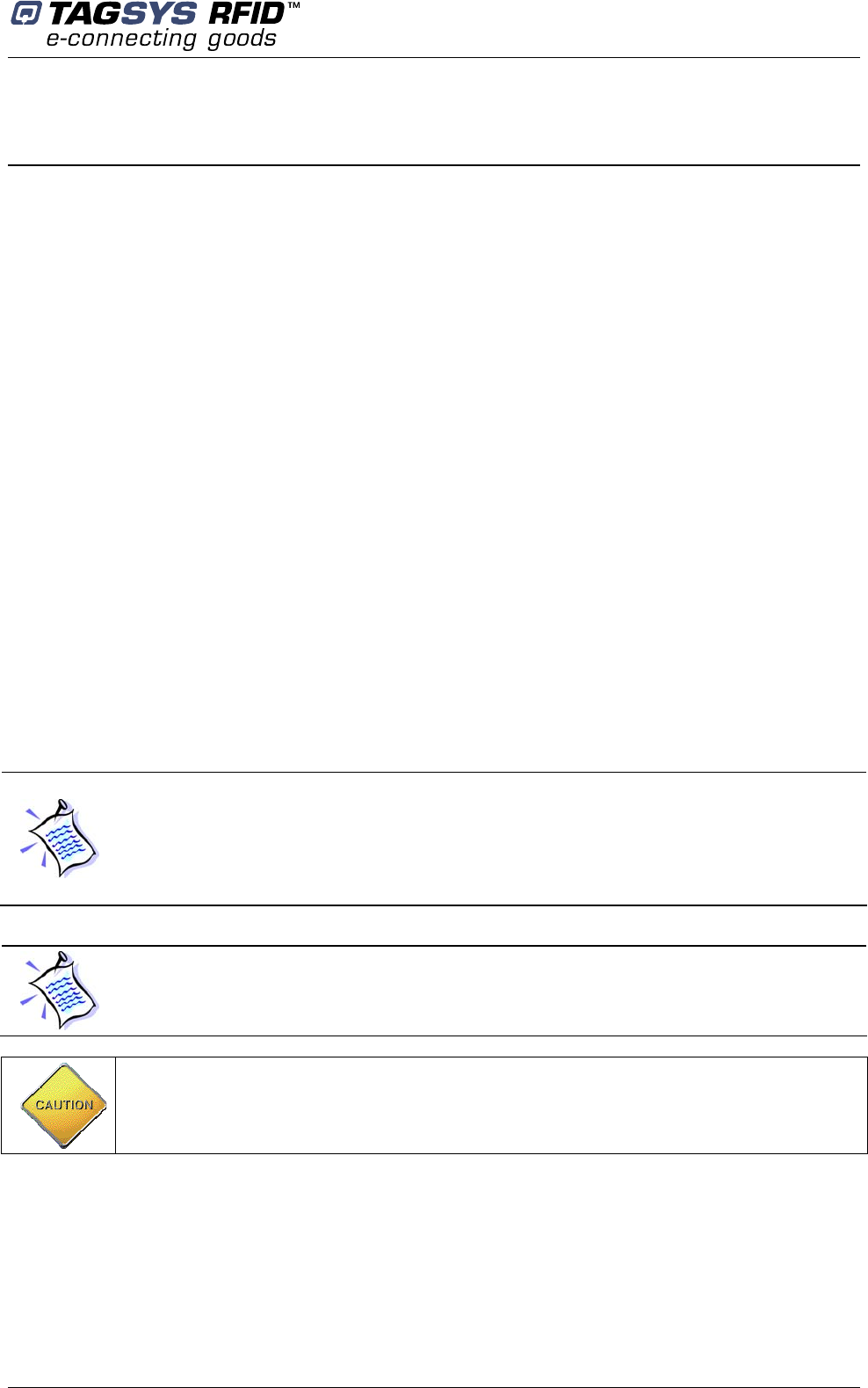
Installation
February 2008 Revision 1.3 21/50
4 Installation
This section describes how to install the Medio L400 reader.
4.1 Mechanical Aspects
The Medio L400 is delivered with four rubber pads on the bottom of the package for installation on
a table or desktop. The rubber pads can be removed to access the screw cutting hole that can be
used to mount the unit in various positions. Please see Technical Specifications section for
more details.
4.2 Cabling Requirements
Ensure product is turned off (power switch in upper position).
Connect the provided power supply bayonet connector to the connector on the product (to
connect the power bayonet connector to the product, push it carefully then turn it 90
clockwise to lock it),
Connect the power supply to the mains supply.
Connect the reader to the host system using one of the available interfaces (USB, RS-232
or Ethernet),
Connect one or several antennas to reader channels.
Power-up reader (power switch in on position).
Only provided power supply which includes a ferrite core installed on the DC side, 3
inches (76mm) away from DC connector (Switchbox FDF0453-A) shall be used when
installing Medio L400 reader !
All cables must be correctly shielded. The shielding effectiveness of the material used should
be of good performance (60 dB minimum), especially in the frequency range of 10 to 60
MHz. The addition of ferrite clamps near the reader unit will increase common mode
rejection. TAGSYS antenna products are delivered with good performance shielded coaxial
cables with 6 ferrite beads already mounted to increase shielding effectiveness at low
frequencies.
Power cable must be purchased separately in accordance with local requirements.
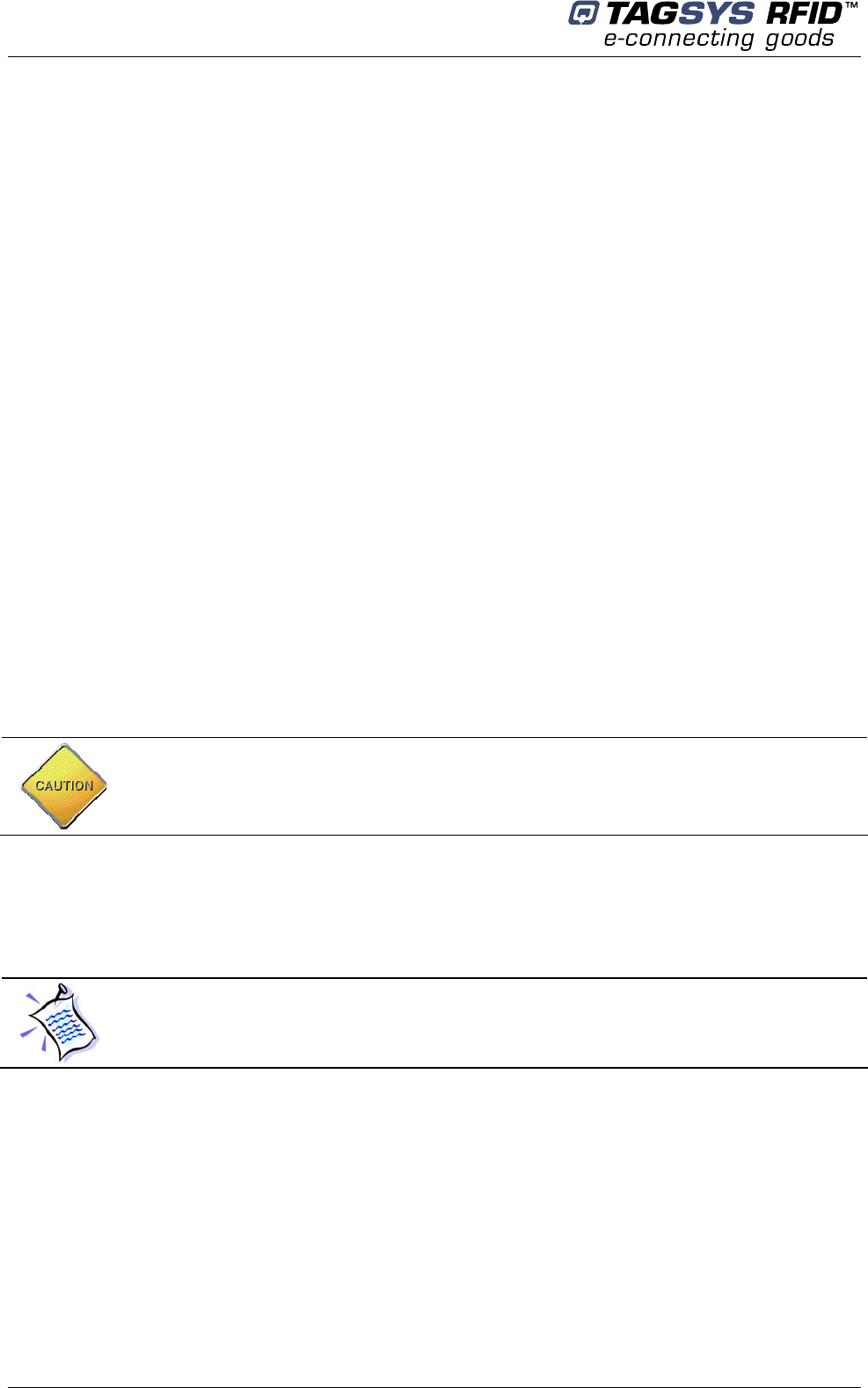
Medio L400
22/50 Revision 1.3 February 2008
4.3 Using USB Interface
4.3.1 Installing USB Drivers
At first connection to the PC USB port, Windows® will detect the TAGSYS Medio L400 reader and
will ask to install a driver. The USB drivers are located into the USB Drivers folder on the product
CD-ROM.
Two drivers will be installed:
- The USB device driver.
- The virtual COM port (VCP) driver. The VCP driver emulates a standard PC COM port.
After installation of the drivers, power up and connect your Medio L400 to a spare USB port on
your PC to launch the Windows Found New hardware Wizard
Select “No, not this time” and click next to proceed with the installation.
Select “Install from a list or specific location (Advanced)” and then click “Next”.
Select “Search for the best driver in these locations” and click the Browse button to select
the TAGSYS USB Drivers folder on the Product CR-Rom. Then click “Next” to proceed.
Windows should then display a message indicating that the installation was successful.
Click Finish to complete the installation.
Repeat the procedure above when Windows® asks for drivers again (virtual com port).
To confirm that the installation has completed successfully, open the Device Manager and select
“View > Devices by type”. The TAGSYS Medio L400 reader now appears as an additional COM
port.
4.3.2 Using the USB interface
Once the USB drivers are properly installed, the reader appears as a new COM port. Simply
connect to this COM port at 115200 Bauds to access the reader.
4.4 Using RS-232 Interface
RS-232 interface does not require specific drivers’ installation. Default RS-232 speed is 115200
bauds, and can be modified by software. Supported baud rates are 4800 bauds, 9600 bauds,
19200 bauds, 38400 bauds, 57600 bauds and 115200 bauds.
4.5 Using 10/100 Ethernet Interface
10/100 Ethernet interface does not require specific drivers installation. Default TCP/IP
configuration is the following:
Drivers for Windows 98 are not provided. They are available upon request (please contact
TAGSYS).
Virtual COM port speed is always 115200 Bauds and can not be changed.
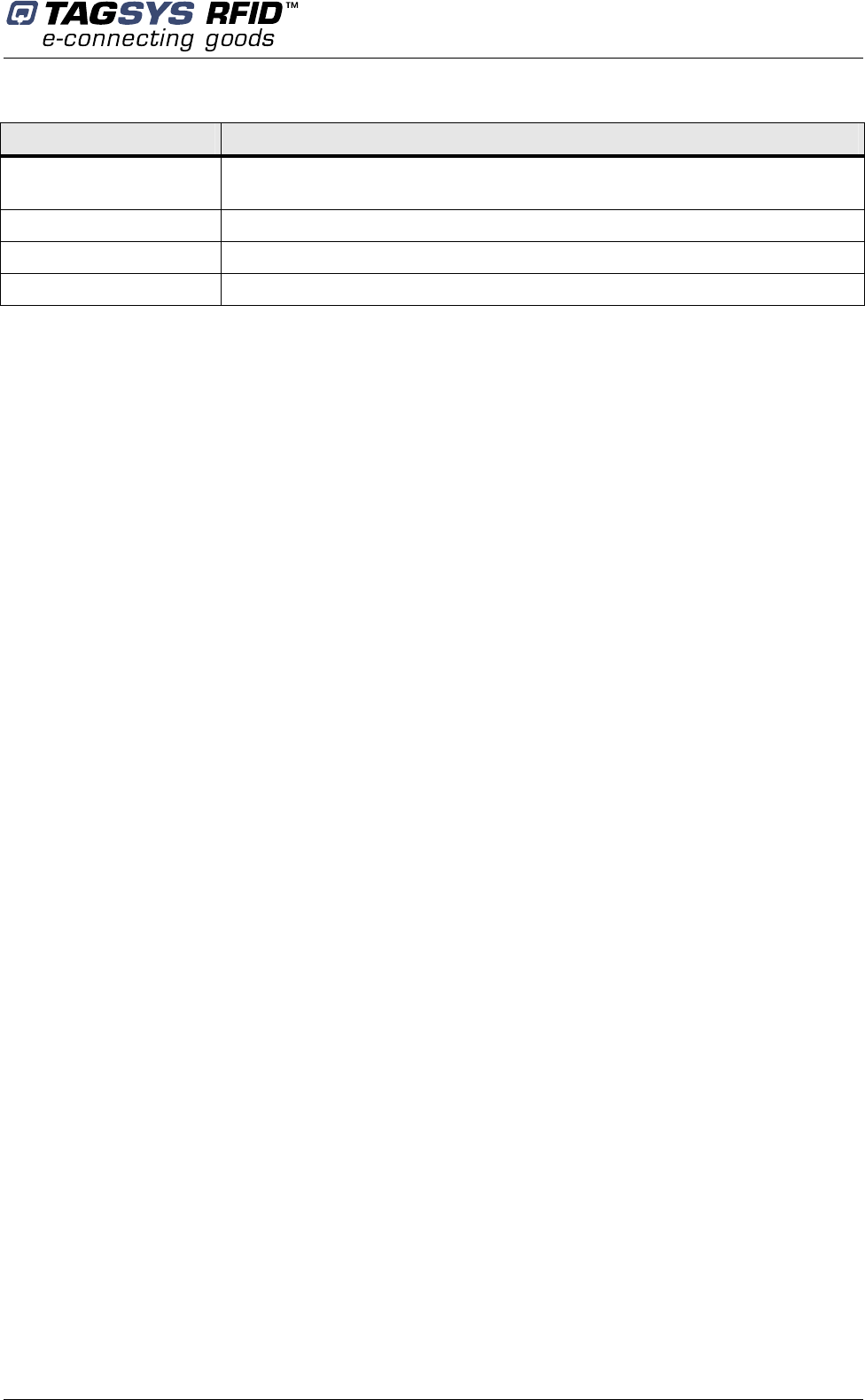
Installation
February 2008 Revision 1.3 23/50
Table 7: Default TCP/IP configuration
Parameter Value
DHCP Active (The reader will try to automatically configure using DHCP. If it fails, the
reader will use the following fallback configuration)
Fallback IP Address 169.254.0.100
Fallback Netmask 255.255.0.0
Fallback Gateway 169.254.0.1
4.6 Restoring Factory Configuration
To restore factory configuration, please follow these steps:
Turn reader off.
Press and hold simultaneously the “Up”, “Down” and “Select”.
Turn reader on.
After 3 seconds, the reader displays a message asking for confirmation. Press “Select” to
confirm, or any other key to cancel.
Default configuration is now restored.
4.7 Running Tagsys Explorer for the First Time
The Medio L400 reader is delivered with the Tagsys Explorer software tool intended to easily setup
the reader, test it and perform RFID reading and writing operations. In addition, the L400 Explorer
can be used to display additional information about the reader (Firmware and hardware versions
and revisions) as well as to upgrade reader firmware. This section describes how to start with L400
Explorer.
4.7.1 Installing Tagsys Explorer
Tagsys Explorer is based Microsoft’s .NET technology and requires the following minimum system
configuration:
• IBM-PC compatible computer with a 400 MHz or higher processor (1 GHz recommended) ;
• Microsoft® Windows 2000 SP 3, Windows Server 2003, Windows XP SP 2 or Windows
Vista operating system recommended. Microsoft® Windows 98, Windows 98 SE, Windows
ME legacy operating systems are supported but not recommended ;
• Microsoft® .NET Framework version 2.0 or 3.0 ;
• 128 megabytes (MB) of RAM (256 MB recommended) ;
• 300 MB of free hard disk space. This includes .NET Framework requirements ;
• 1024x768 16-bits (1280x1024, 32-bits recommended) ;
• CD-ROM drive ;
• 1 serial port and/or 1USB port and/or 1 Ethernet port.
To install the Tagsys Explorer software on your PC:
1. Insert the product CD-ROM into the disk drive on your PC.
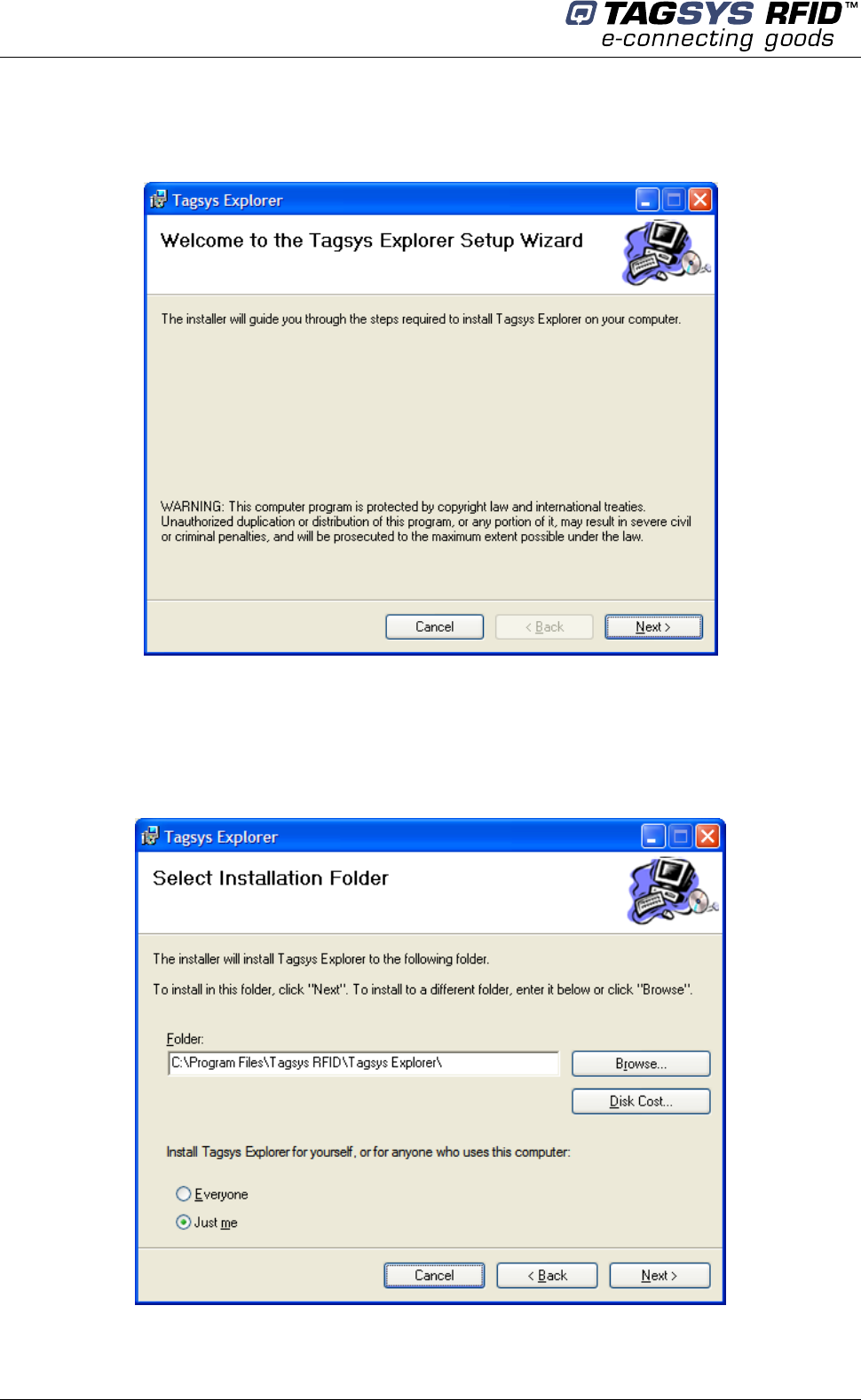
Medio L400
24/50 Revision 1.3 February 2008
2. In Windows Explorer, open the CD-ROM drive window and run “Tagsys Explorer
Installer.msi” in “Tagsys Explorer” folder.
Figure 3: Setup Welcome window
3. Click Next to view the license agreement, then click Next again if you agree with the terms.
4. The Destination Location window is displayed. Select the folder where Tagsys Explorer will
be installed.
Figure 4: Select Installation Folder window
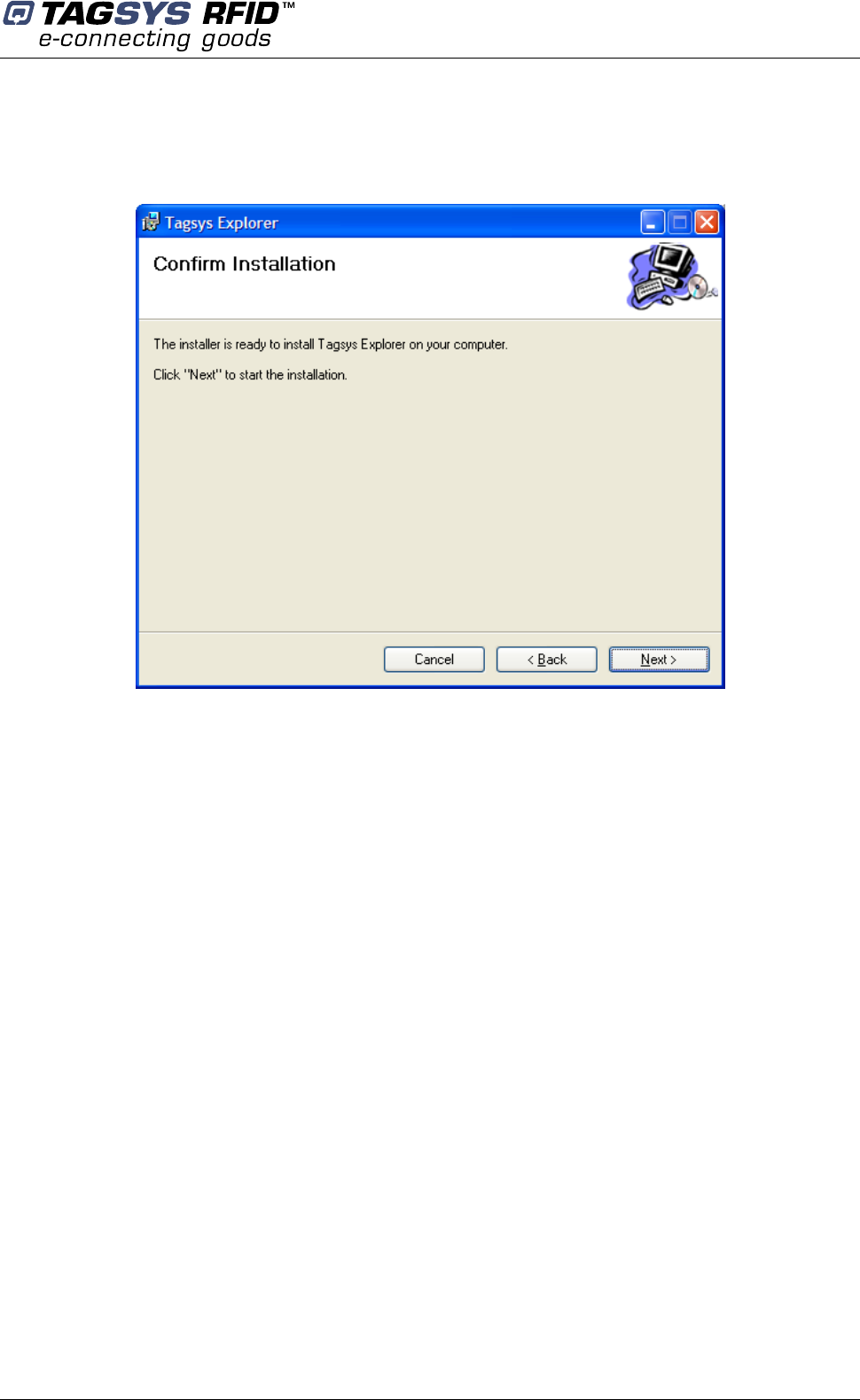
Installation
February 2008 Revision 1.3 25/50
5. Once the correct folder is selected, click Next.
Figure 5: Confirm Installation window
6. Click Next to start the installation process. A shortcut will be created on your desktop and a
program group will be created in the start menu.
4.7.2 Connecting to a device using Tagsys Explorer Wizard
This section describes how to get started using the Tagsys Explorer software and configure it.
Before running Tagsys Explorer, connect your RFID reader to the serial/USB port of the PC or to
your TCP/IP network. Connect an antenna to the reader (Channel 1) and turn reader on.
Once the reader is ready, run the Tagsys Explorer program and the main window will be displayed.
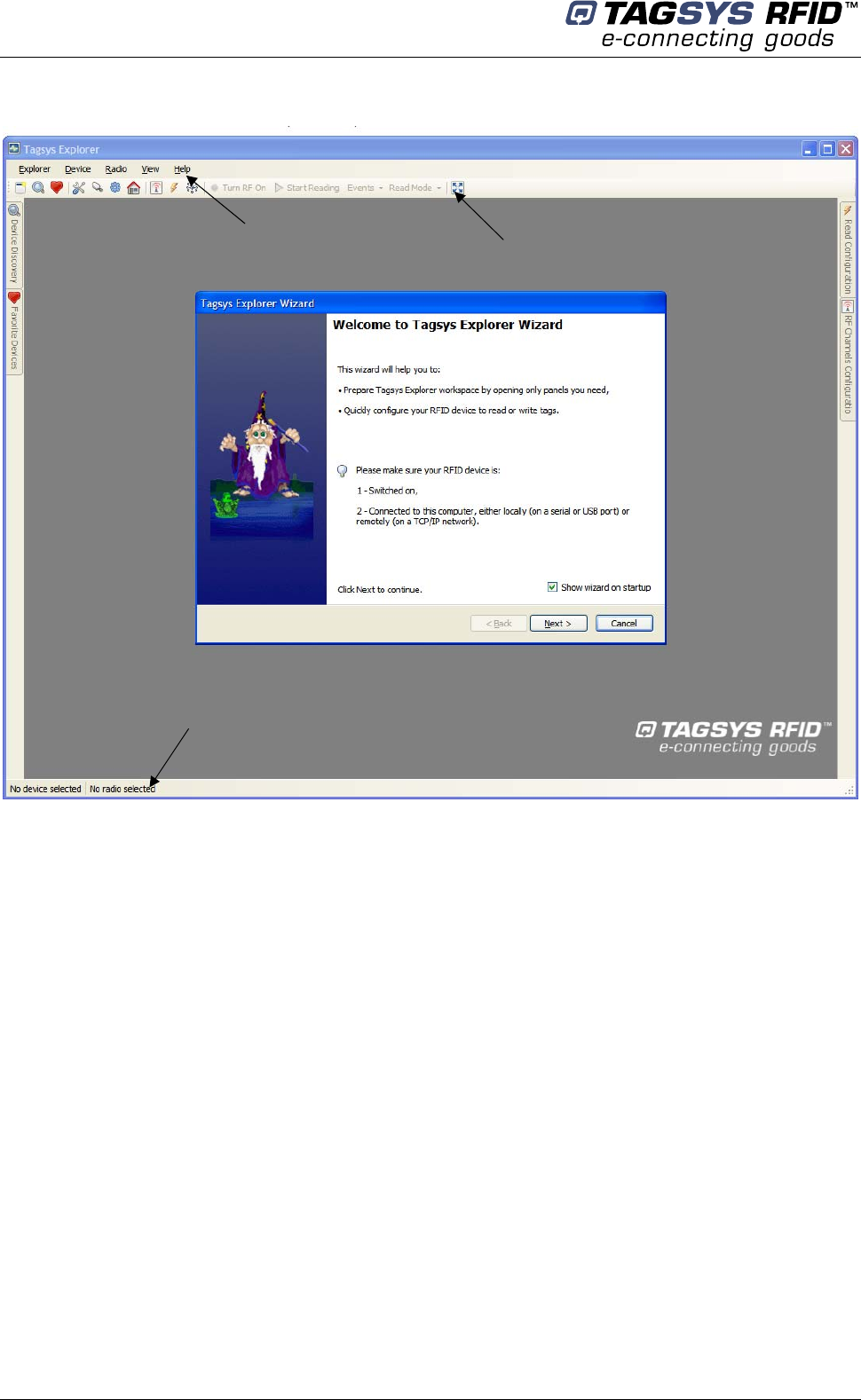
Medio L400
26/50 Revision 1.3 February 2008
Figure 6: Tagsys Explorer window
The “Tagsys Explorer Wizard” opens automatically when Tagsys Explorer is started for the first
time. This wizard allows you to quickly set up the Tagsys Explorer to perform basic tasks such as
configuring your RFID device and read or write tags.
Toolbar
Menu bar
Status ba
r
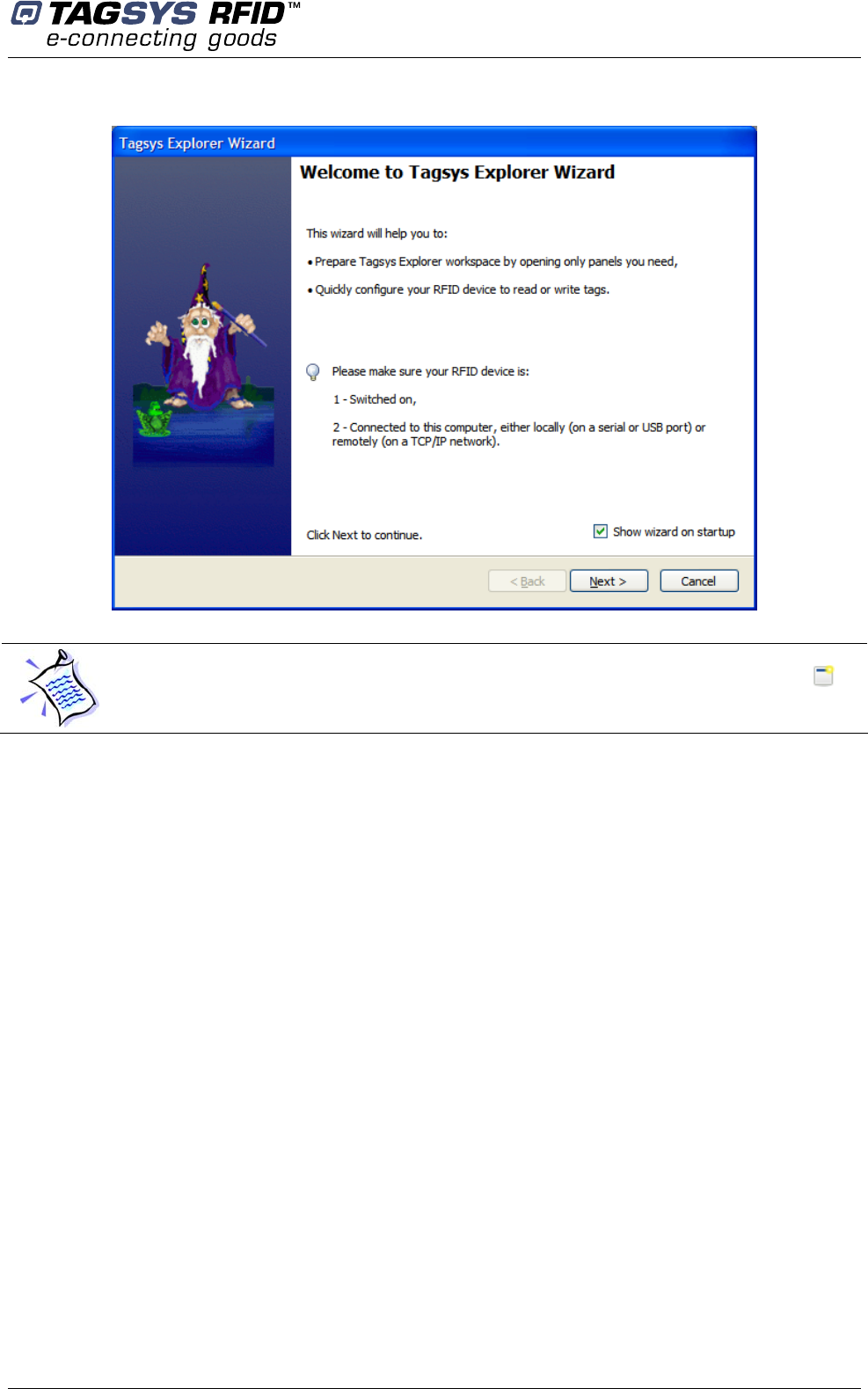
Installation
February 2008 Revision 1.3 27/50
Figure 7: Tagsys Explorer Wizard
If the “Tagsys Explorer Wizard” does not open automatically, click on the “Wizard” icon in
the toolbar or choose “Wizard…” in the “Explorer” menu.
Read the instructions given by the wizard and click “Next >” to continue.
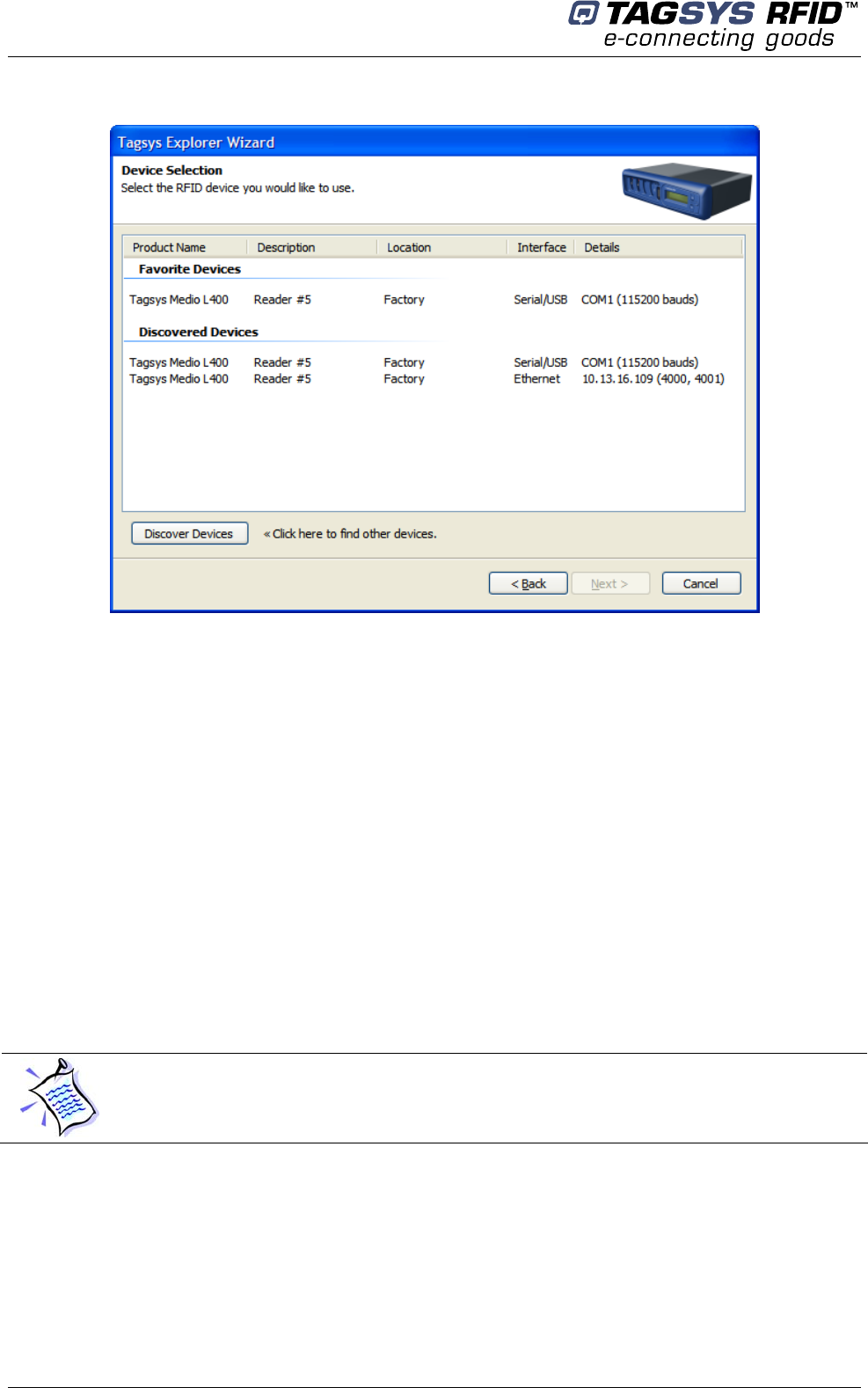
Medio L400
28/50 Revision 1.3 February 2008
Figure 8: Device Selection page
The Tagsys Explorer Wizard can automatically discover and display RFID devices plugged into
your computer’s serial or USB ports or connected on a TCP/IP network.
Discovered devices are displayed under the “Discovered Devices” group. The same device can be
displayed one or more times depending on the number of communication interfaces (Serial/USB,
Ethernet) this device is connected to. The preferred connection is the “Ethernet” interface when
available as it is the fastest communication interface.
You can restart a discovery at any time by clicking “Discover Devices”.
Devices that have been previously registered in Tagsys Explorer will appear under the “Favorite
Devices” group. Favorite Devices are shortcuts to devices you are working with often and can be
managed using the “Favorite Devices” panel. See Tagsys Explorer User’s Guide for more
information.
To continue, choose the device you would like to use and click “Next >”. If necessary, this device
will be automatically added to your “Favorite Devices”.
If a device with the same interface details appears both in “Favorite Devices” and in
“Discovered Devices” groups, it does not matter in which group you select this device.
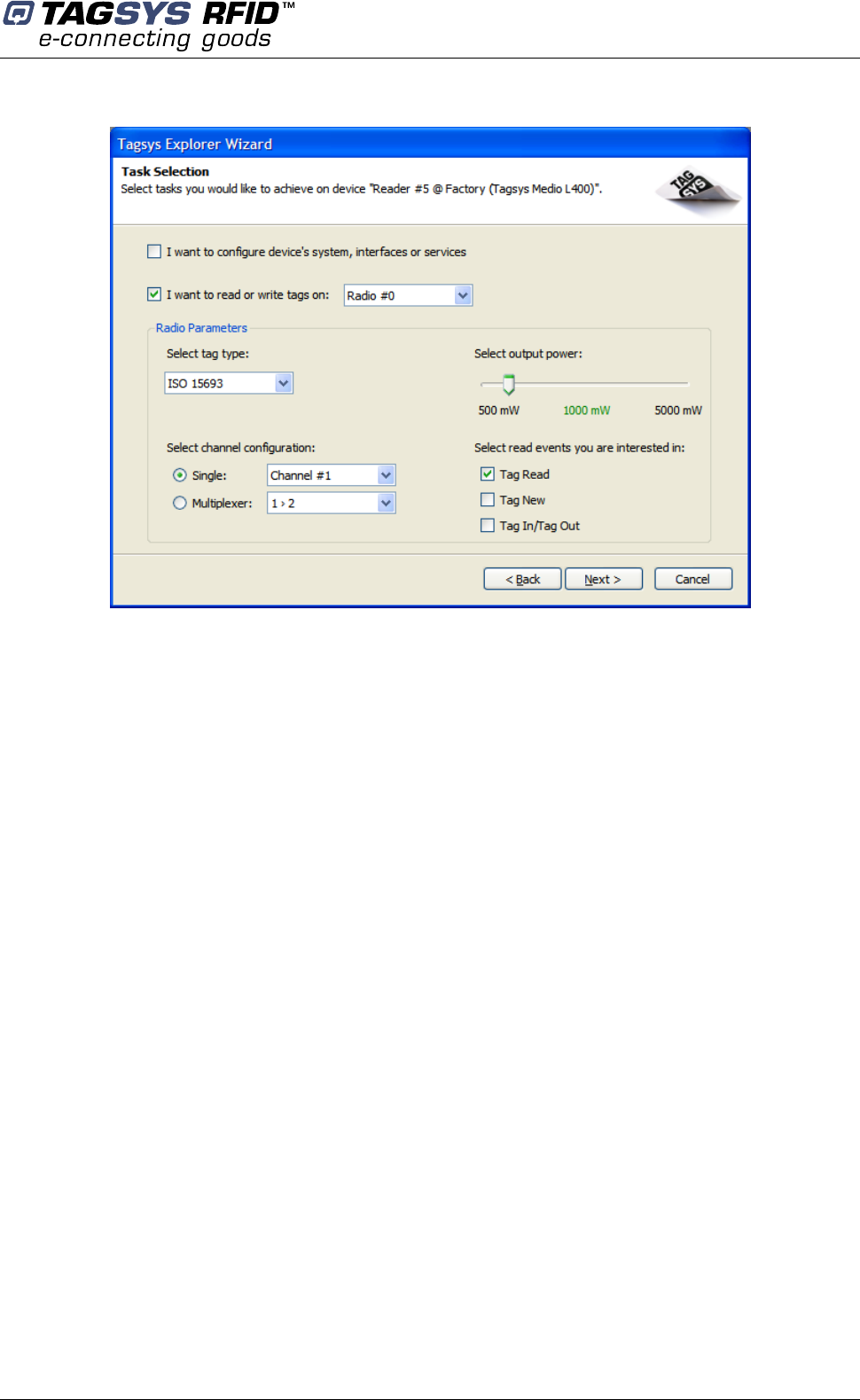
Installation
February 2008 Revision 1.3 29/50
Figure 9: Task Selection page
If you want to set up your device parameters, such as changing its description or its interfaces
settings, check “I want to configure device’s system, interfaces or services”.
If you want to read tags, write their memory or send specific tag commands, check “I want to read
or write tags on:” You can then choose the radio that should be used for emitting and receiving.
Medio L400 only supports one radio (Radio #0).
In the “Radio Parameters” section, choose the settings you would like to use.
For demonstration purposes, please select the same settings as shown in previous figure. Then,
click “Next >” to continue.
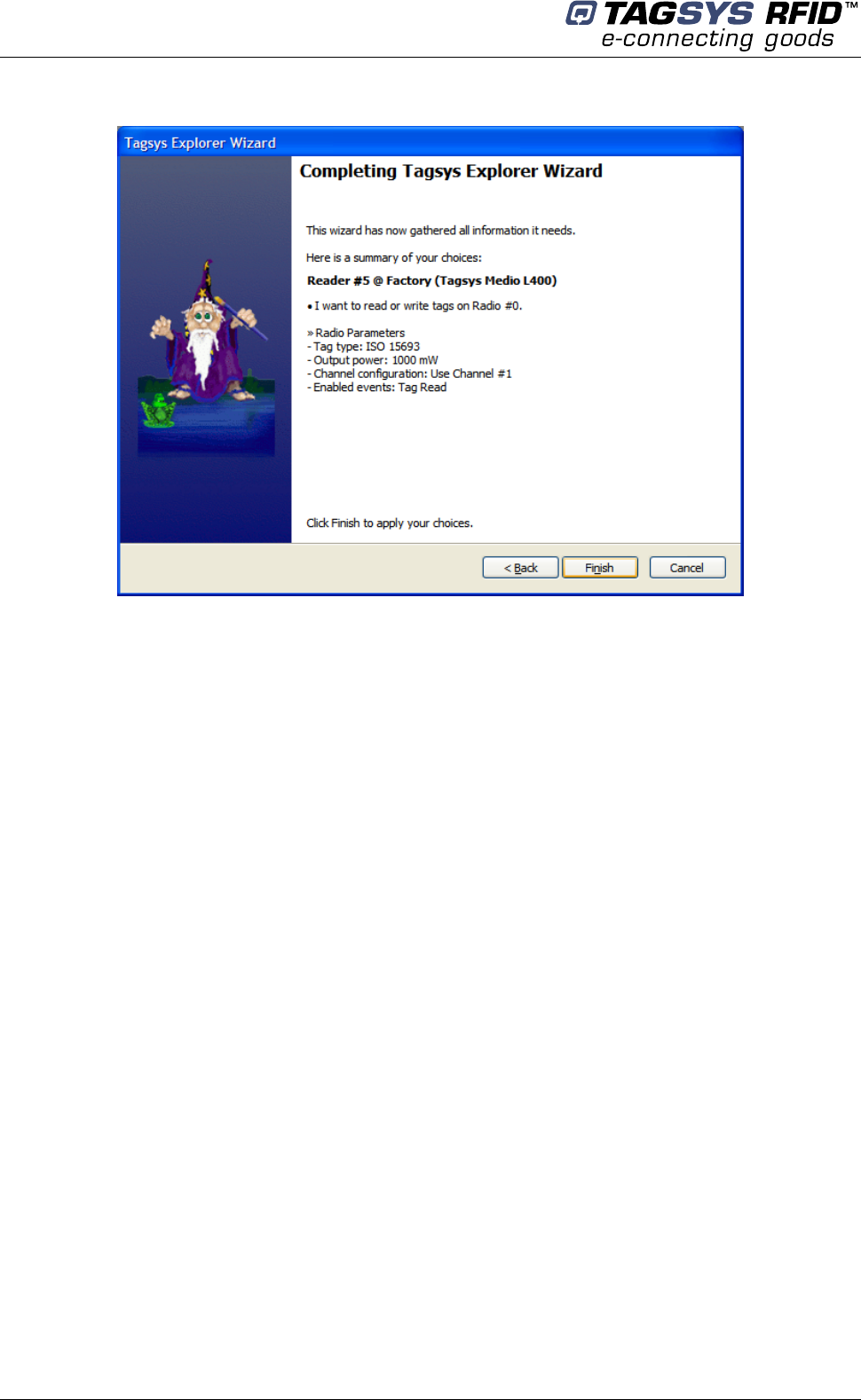
Medio L400
30/50 Revision 1.3 February 2008
Figure 10: Wizard Summary page
Verify the summary of all selected parameters chosen and click “Finish” to confirm. Tagsys
Explorer will then automatically open the panels you need and apply the radio configuration you
have chosen. The following screen appears:
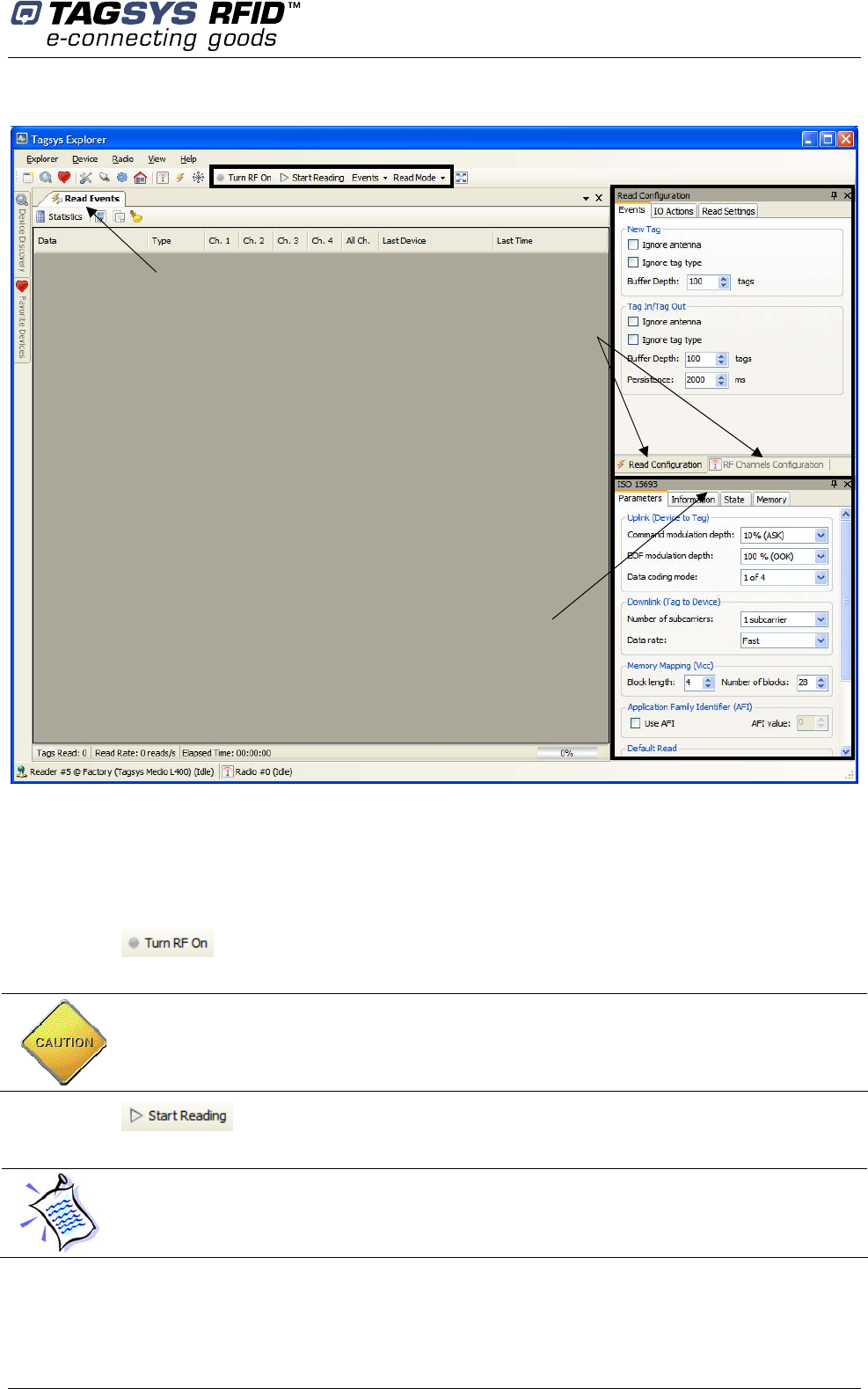
Installation
February 2008 Revision 1.3 31/50
Figure 11: Tagsys Explorer workspace configured
4.7.3 Reading the UID of ISO 15693 tags
If you have not configured your device using the Tagsys Explorer wizard as explained in section
Installing Tagsys Explorer, please do so before proceeding.
To start reading using the configuration the wizard has applied:
1. Click button in the tool bar to turn the radio field on.
CAUTION: Make sure an antenna is plugged in the channel that will be used for reading
before turning the radio field on. Turning on the radio field on a channel without an antenna
reduces the lifetime of the reader.
2. Click button in the tool bar to start reading tags.
If the radio field is not turned on, Tagsys Explorer will request your permission to turn it on;
click “OK” to accept. Again, make sure an antenna is plugged in to the channel before
accepting.
3. Place ISO 15693 tags in the radio field of channel #1 antenna.
Tags appear in the “Read Events” panel as they are read. A counter indicates how many
times they have been read on each device’s channel since the read session beginning.
RF/Reading controls
Read Events panel
Read and RF Channels
Configuration panels
ISO15693 Parameters
and Commands panel
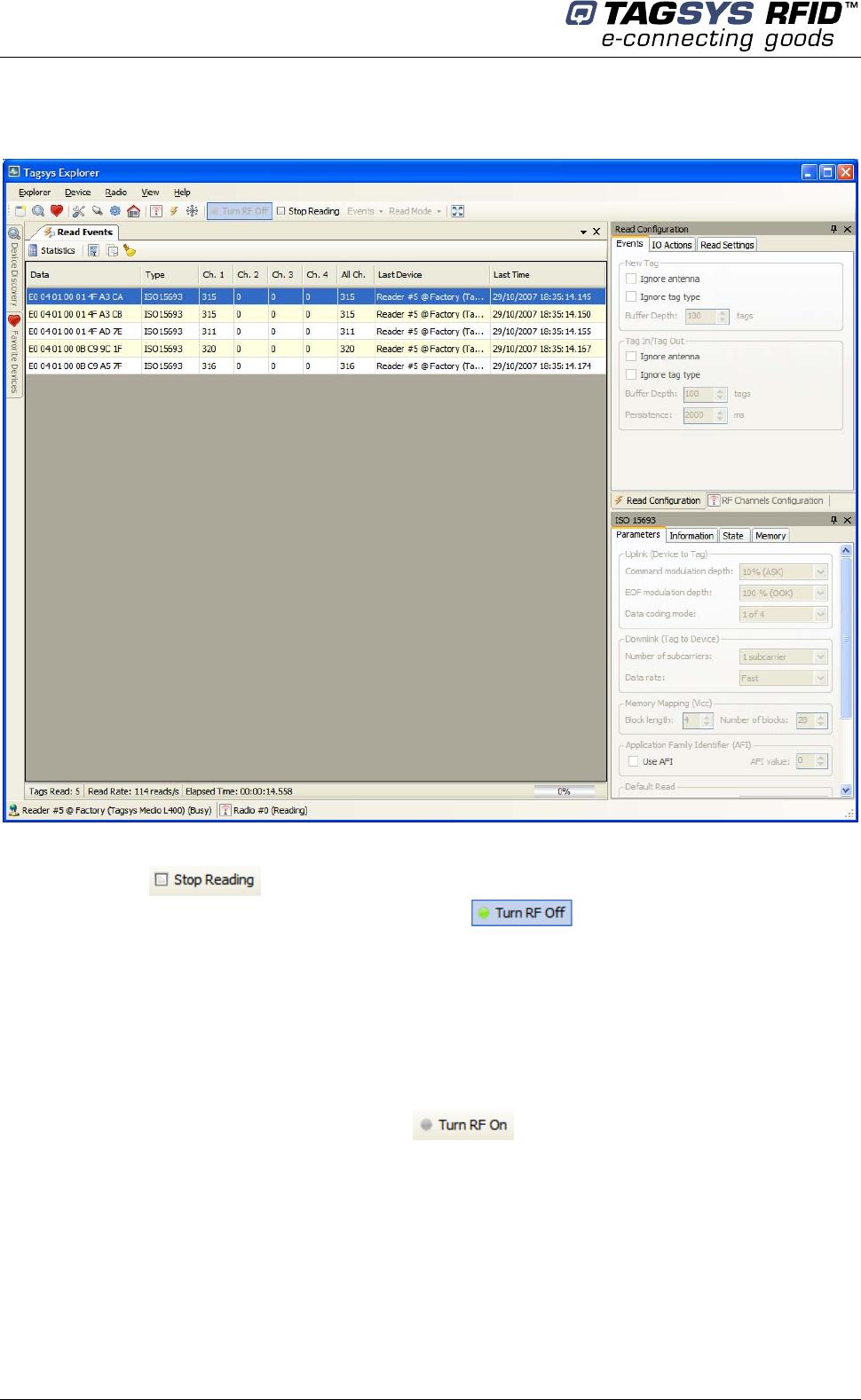
Medio L400
32/50 Revision 1.3 February 2008
Figure 12: Tagsys Explorer reading ISO 15693 tags
4. Click the button in the tool bar when you are finished reading. You may want
to turn the radio field off as well by clicking the button.
4.7.4 Reading and Writing ISO 15693 tag memory
If you have not configured your device using Tagsys Explorer wizard as explained in section 4.7.2,
please do so before proceeding.
This section shows how to read and write ISO15693 tag memory.
1. Radio field must be turned on. Click the button in the toolbar to turn the radio
field on.
2. Click the “Memory” tab of the ISO15693 panel. This tab contains all memory-related
commands.
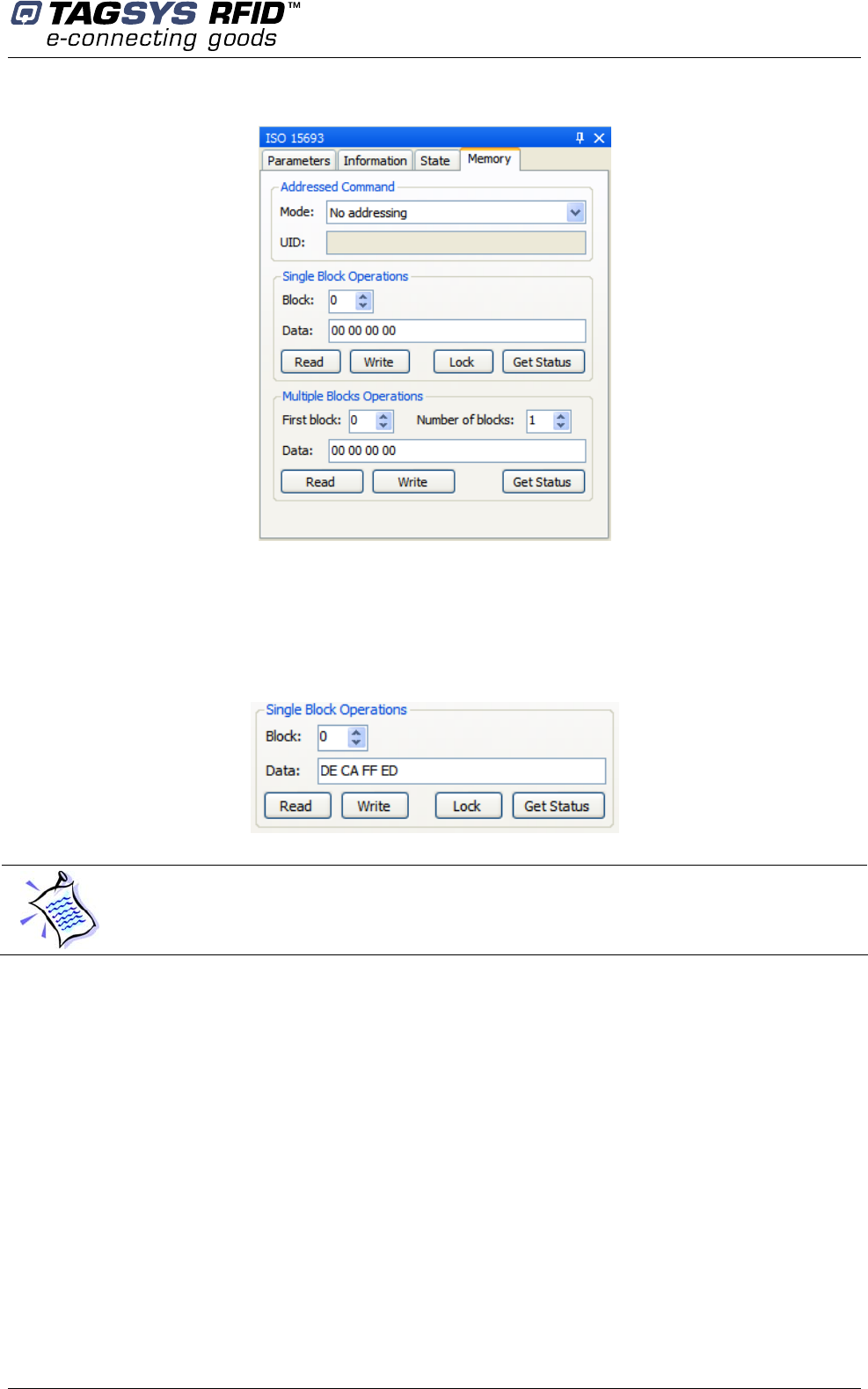
Installation
February 2008 Revision 1.3 33/50
Figure 13: Memory tab of ISO 15693 panel
3. In the “Single Block Operations” box, select the block and data you want to write (data is
hexadecimal). You can pad bytes with whitespaces if you wish, but this is not required.
Figure 14: Single Block Operations
The length in bytes of a single block depends on the tag manufacturer, but most ISO 15693
tags use four bytes blocks. See Tagsys Explorer User’s Guide for more information.
4. Place a single ISO15693 tag in the radio field of the channel 1 antenna.
5. Click “Write” to write data to the block. If writing is successful, no error message appears.
To check block data, clear the “Data” field and click “Read” to read data back from the
block.
4.7.5 Upgrading System or Radio Firmware
If you have not configured your device using Tagsys Explorer wizard as explained in section 4.7.2,
please do so before proceeding.
Two different firmware sets can be upgraded in your RFID reader:
• System firmware (The system is in charge of interfacing one or several radios to a host
through various interfaces and protocols)
• Radio firmware (The radio is in charge off all RFID operations).
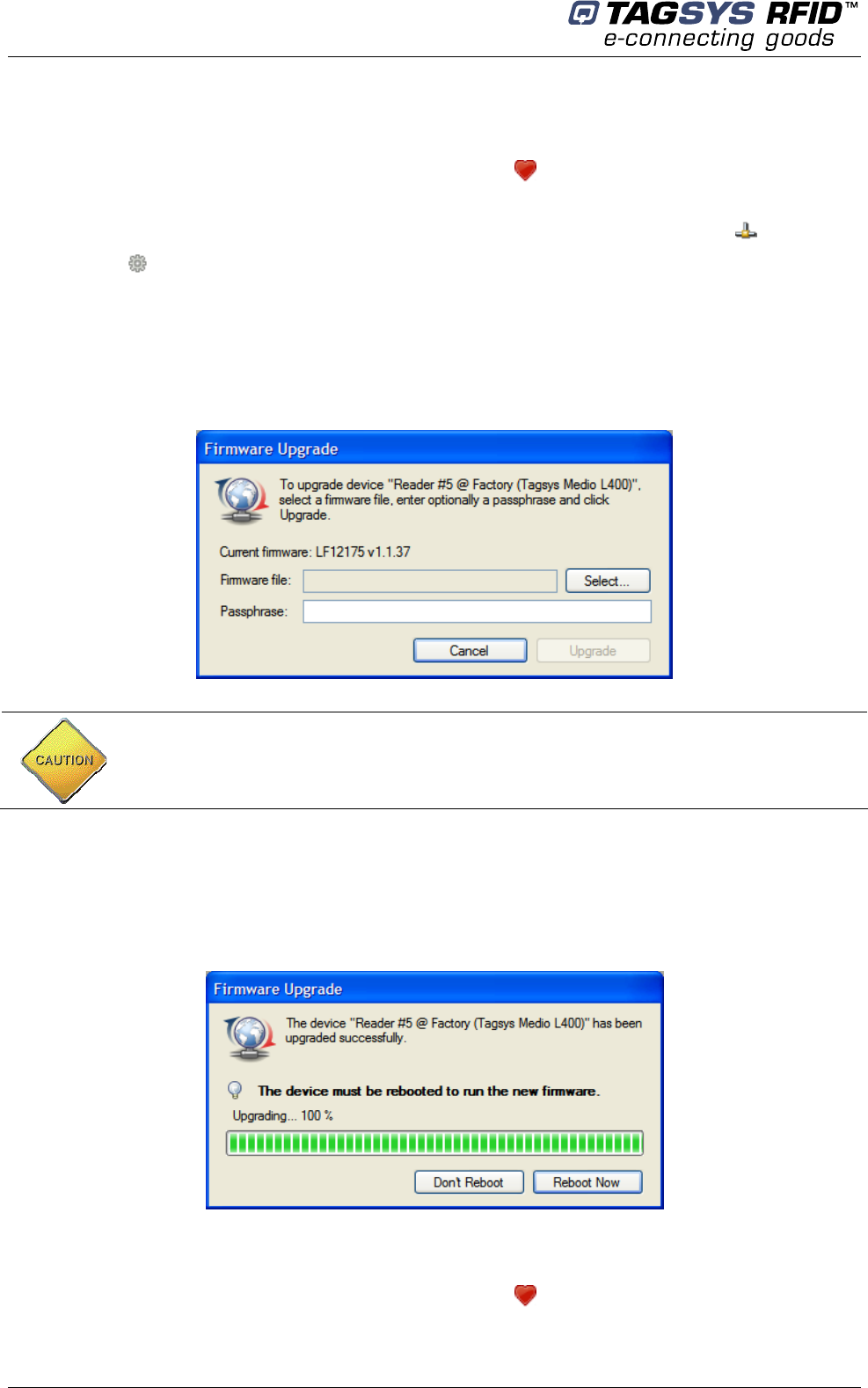
Medio L400
34/50 Revision 1.3 February 2008
To upgrade system firmware:
1. Open “Favorite Devices” panel by clicking on the icon in the tool bar or by choosing
“Favorite Devices” in the “Device” menu.
2. Connect to the device you want to upgrade by selecting it and clicking on the icon.
3. In the drop down menu, choose “Upgrade System Firmware…”
Alternatively, you may also right-click the device and choose “Upgrade System Firmware…”
4. In the “Firmware Upgrade” dialog box, select the firmware file, enter its associated
passphrase if necessary and click “Upgrade”.
Figure 15: System firmware upgrade
CAUTION: Do not turn off the device during the upgrade as this may permanently corrupt
the system firmware.
5. Once the upgrade is completed, click “Reboot” to reboot the device immediately.
If you need to upgrade another set of firmware of the device click “Don’t Reboot”.
Figure 16: System firmware upgrade completed
To upgrade radio firmware:
1. Open “Favorite Devices” panel by clicking on the icon in the tool bar or by choosing
“Favorite Devices” in the “Device” menu.
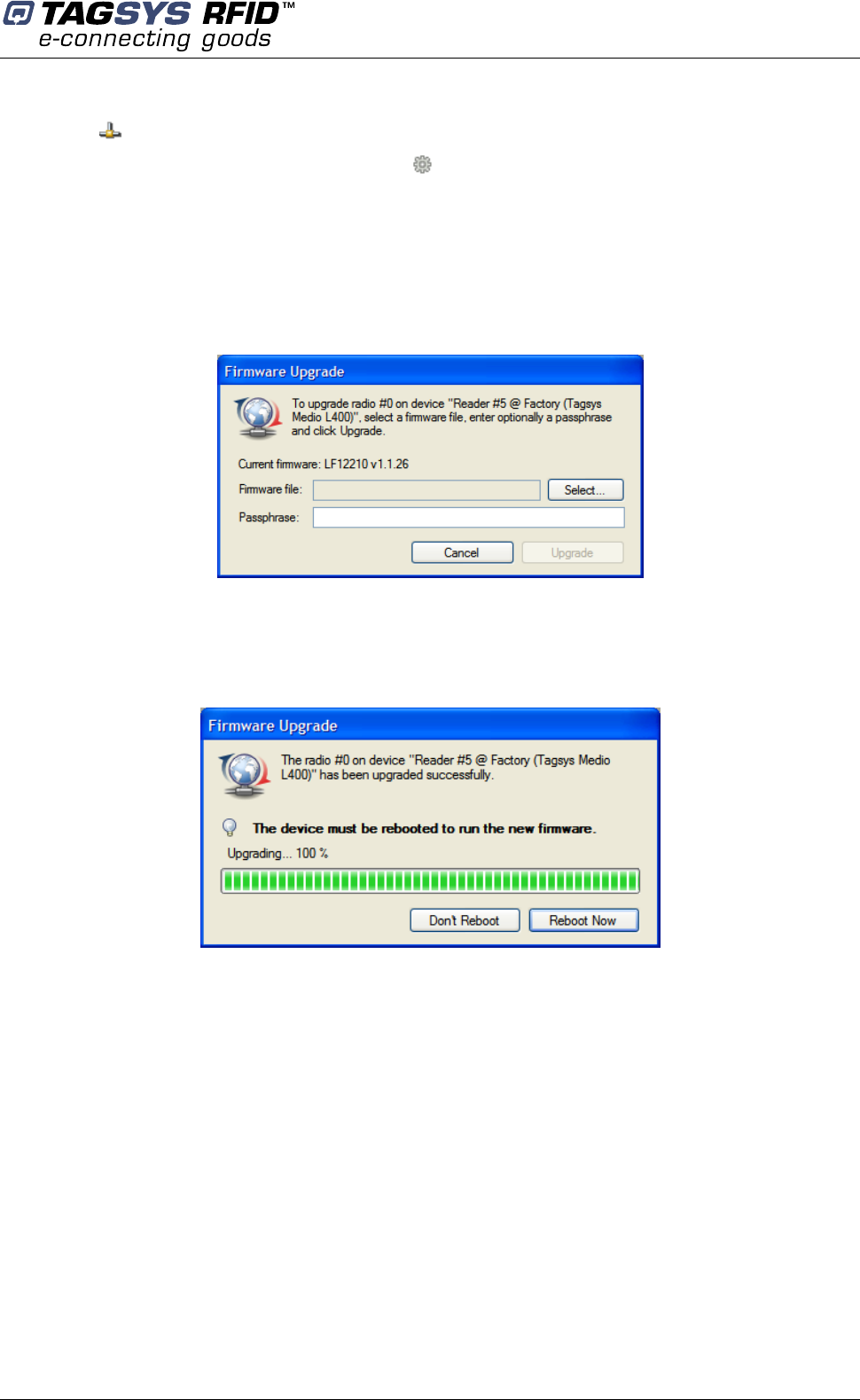
Installation
February 2008 Revision 1.3 35/50
2. Connect to the device that you want to upgrade the radio on by selecting it and clicking on
the icon.
3. Click on the radio to upgrade and in the drop down menu, choose “Upgrade Radio
Firmware…”
Alternatively, you may as also right-click the radio and choose “Upgrade Radio Firmware…”
4. In the “Firmware Upgrade” dialog, select the firmware file, enter its associated passphrase
if necessary and click “Upgrade”.
Figure 17: Radio firmware upgrade
6. Once the upgrade is completed, click “Reboot” to reboot the device immediately.
If you need to upgrade another set of firmware of the device first, click “Don’t Reboot”.
Figure 18: Radio firmware upgrade completed
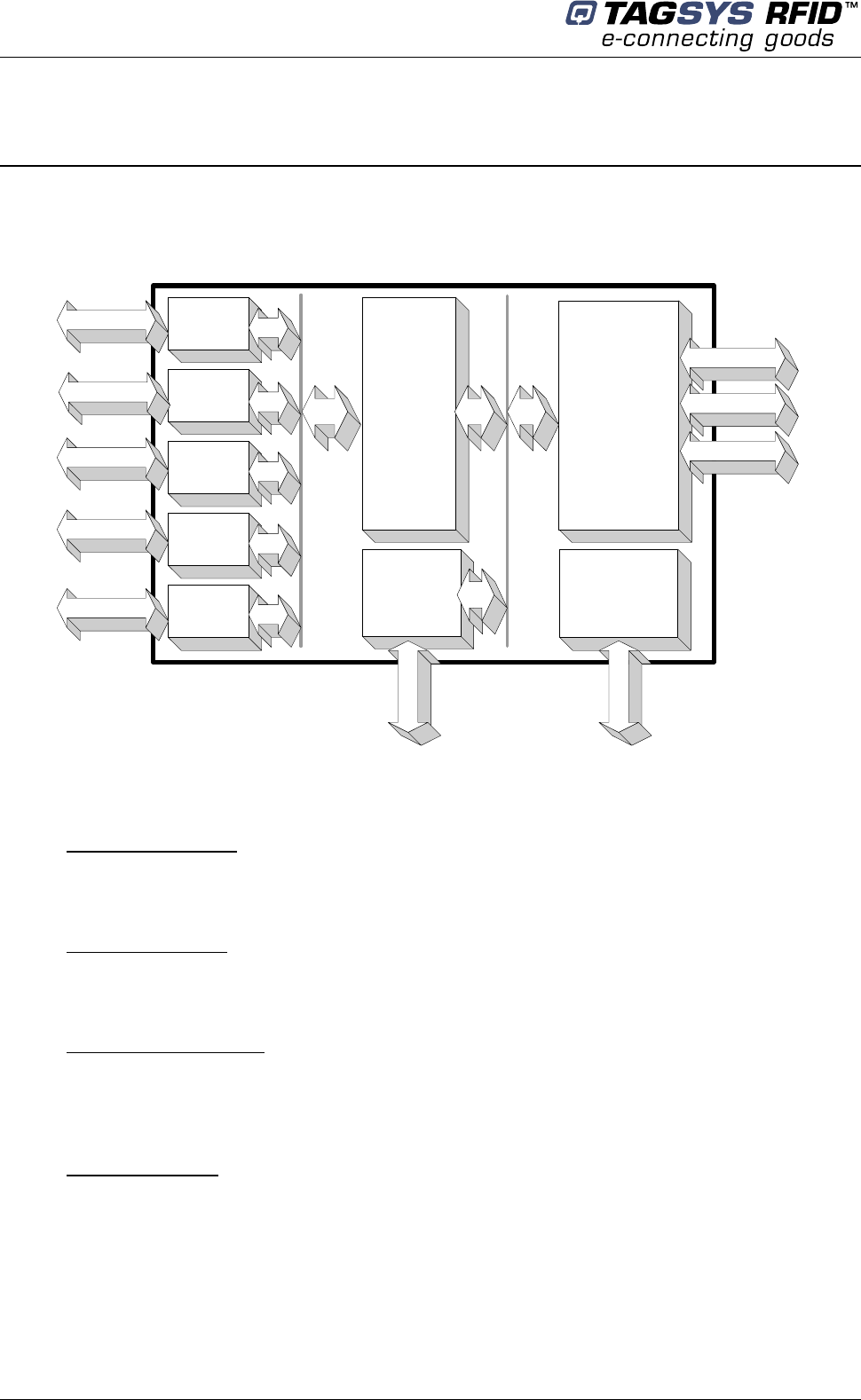
Medio L400
36/50 Revision 1.3 February 2008
5 Advanced Notions
5.1 Reader Architecture
Figure 19: Medio L400 Architecture
Radio Microsystem
RF
Front End
RF
Front End
RF
Front End
RF
Front End
IO
Front End
Channel 2
Channel 1
Channel 3
Channel 4
GPIO Set 1
USB Device
RS-232
10/100 Ethernet
Power Supply
24VDC/40W
LCD
&
Keypad
User Interface
Figure 19 above shows the Medio L400 functional blocks:
The RF Front Ends are analog subsystems responsible for generating and modulating the
RF field for uplink communication to the tags. They also demodulate signal from tags for
downlink communication and provide monitoring information such as operating temperature
and antenna tuning status. They are controlled by the Radio Subsystem.
The IO Front End is responsible for providing 4 protected digital inputs and 4 protected
digital outputs. It is controlled by the Radio Subsystem and can be used as general purpose
IOs directly accessed by the host system, or to automatically trigger readings and signal
reading activity (by light stacks for example) without intervention from the host system.
The Radio Subsystem is responsible for managing the RF and IO Front Ends, encoding
and decoding signals to/from tags, filtering tag data (for example removing duplicate reads)
and providing RFID-related primitives to the Microsystem (like “Activate channel 1”, “Set
output power to 1 Watt”, “Read UID from ISO15693 tag”, …). It is DSP based and is
controlled by the microsystem.
The Microsystem is responsible for interfacing the Radio Subsystem to the host system
through various physical interfaces (USB, RS-232, 10/100 Ethernet) and protocols (Tagsys
StxNG protocol, standalone mode, telnet server, serial console and heartbeat). It also
controls the LCD and keypad.
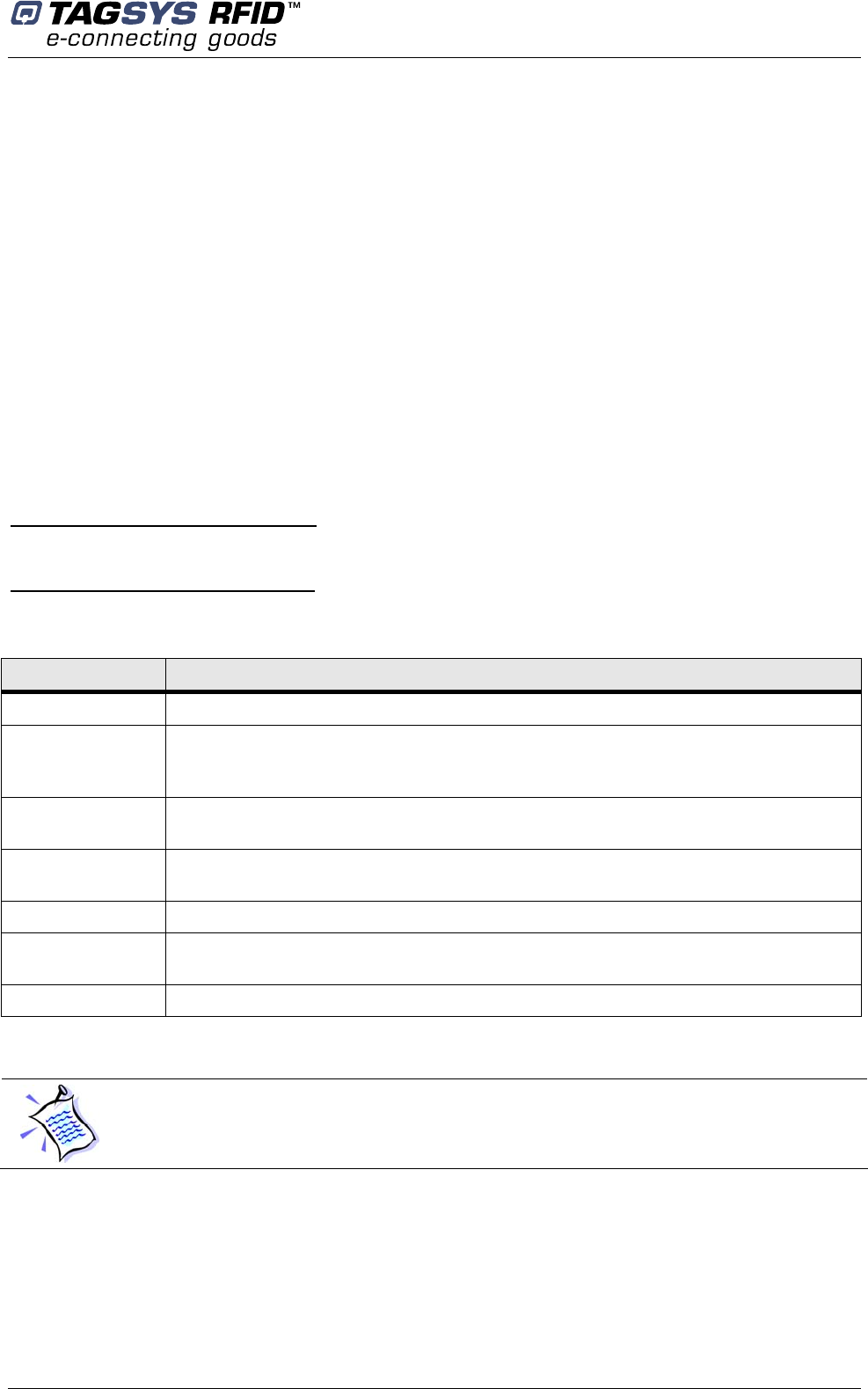
Advanced Notions
February 2008 Revision 1.3 37/50
5.2 Reader to Host Protocols
5.2.1 TAGSYS StxNG
TAGSYS StxNG is the protocol used by the Medio L400 reader to communicate with the host
system. Upon start up, the Medio L400 reader starts listening for incoming frames over all of its
interfaces:
USB (seen as a virtual COM port from the host side)
RS-232
Primary and Secondary TCP ports (default ports are ports 4000 and 4001. Only one
connection per port is accepted).
After a valid frame is received from one of the interfaces, the corresponding command is executed
and a reply is sent back to the host.
Below is a short description of the “command” and “response” frame format.
Host to reader frame (command):
<SOF> <Address> <Command ID> <Nb Data> <Data> <Checksum>
Reader to host frame (response):
<SOF> <Address> <Error Code> <Nb Data> <Data> <Checksum>
Field Description
<SOF> Start Of Frame (01h)
<Address> When RS422 or RS485 communication modes are supported, only the reader whose
StxNG address matches this field executes the command and replies. This field is
ignored by Medio L400.
<Command ID> In a command frame, the ID of the command that should be executed. Command IDs
are in the range 0000h-7FFFh
<Error Code> In a response frame, the error code if an error occurred during execution. Error codes
are in the range 8000h-FFFFh. If no error occurred, the command ID is repeated.
<Nb Data> The Data field length in number of bytes.
<Data> In a command frame, the parameters for the command. In a response frame, the
return values associated to the command.
<Checksum> A checksum. This is the arithmetic sum off all previous bytes.
The reader is never allowed to send data over its interfaces without having received a command
from the host.
For more information about StxNG protocol and a complete command set description, please refer
to Medio L400 Designer’s guide.
5.2.2 Heartbeat
The heartbeat service applies to the 10/100 Ethernet interface only. When activated, the heartbeat
service periodically broadcasts Ethernet packets containing product name, description, location, IP
A simple password-based security mechanism can be activated to prevent unauthorized
access to the reader. In such a case, the host system must first execute a specific command
to identify itself before being allowed to send any other command.
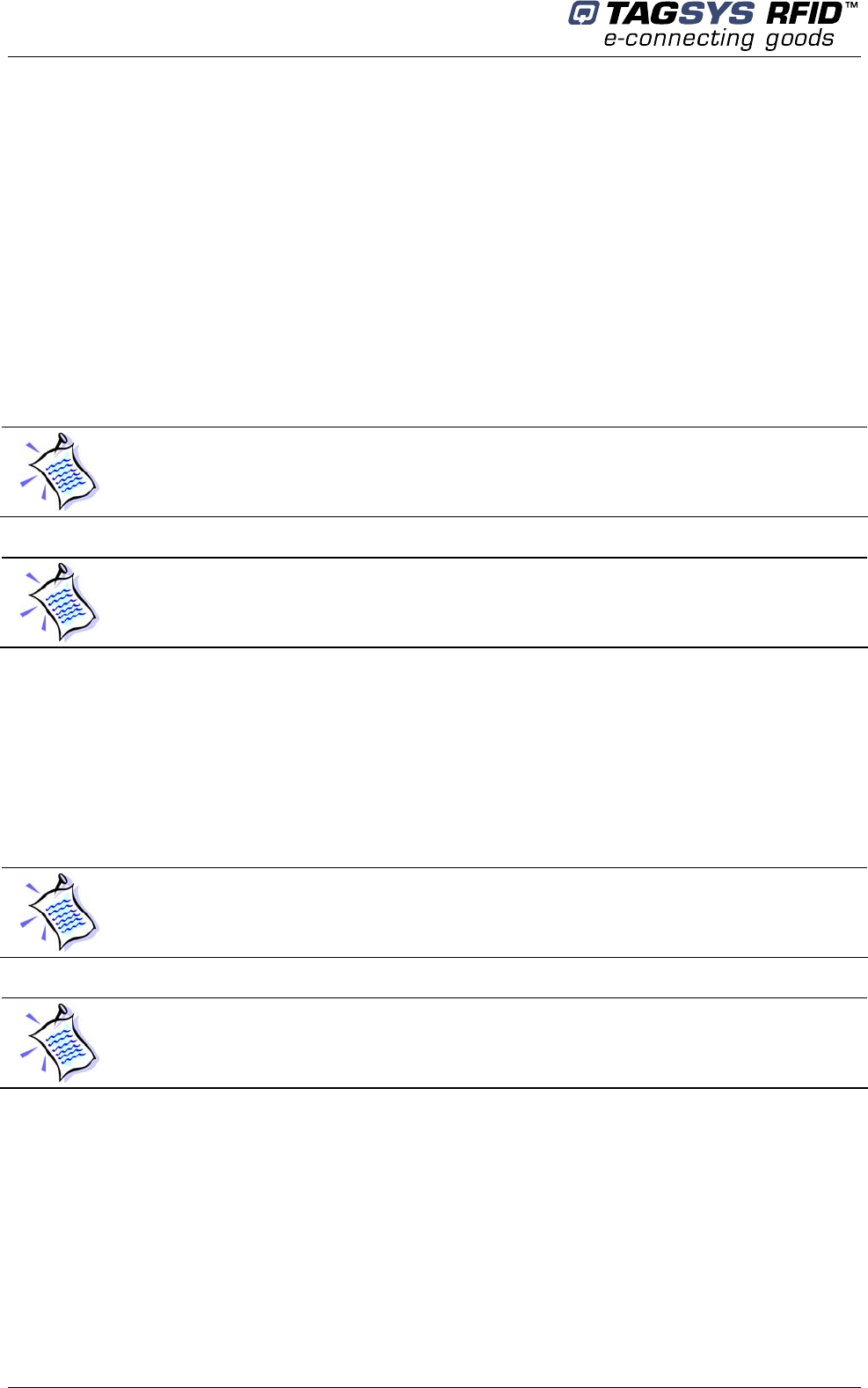
Medio L400
38/50 Revision 1.3 February 2008
address and TCP ports on which reader is listening for incoming connections (see StxNG
protocol).
This heartbeat is useful to:
• Show Medio L400 readers connected to the same physical network as the host.
• Check that a Medio L400 reader is operating properly (in this case, the heartbeat acts as a
watchdog).
For more information about heartbeat please refer to Medio L400 Designer’s guide.
5.2.3 Telnet
The telnet server applies to 10/100 Ethernet interface only. A host can connect to the reader using
any standard telnet client. The Telnet server makes it possible to configure the microsystem only
(serial port configuration, TCP/IP stack configuration, date/time configuration, version query…).
For more information about telnet server please refer to Medio L400 Designer’s guide.
5.2.4 Serial console
The serial console applies to RS-232 and USB interfaces only. A host can connect to the reader
using any standard terminal application. The serial console makes it possible to configure the
microsystem only (serial port configuration, TCP/IP stack configuration, date/time configuration,
version query…).
The reader automatically detects if current data exchanges over its serial and USB ports are
StxNG protocol frames or console frames and reacts accordingly. Consequently, there’s no need
to configure those interfaces for console or StxNG protocol operation: both are simultaneously
available.
For more information about serial console please refer to Medio L400 Designer’s guide.
RFID configuration and control (for example activating a channel and reading a tag) is not
allowed with telnet server.
A simple password-based security mechanism can be activated to prevent unauthorized
access to the reader.
RFID configuration and control (for example activating a channel and reading a tag) is not
allowed with serial console.
A simple password-based security mechanism can be activated to prevent unauthorized
access to the reader.
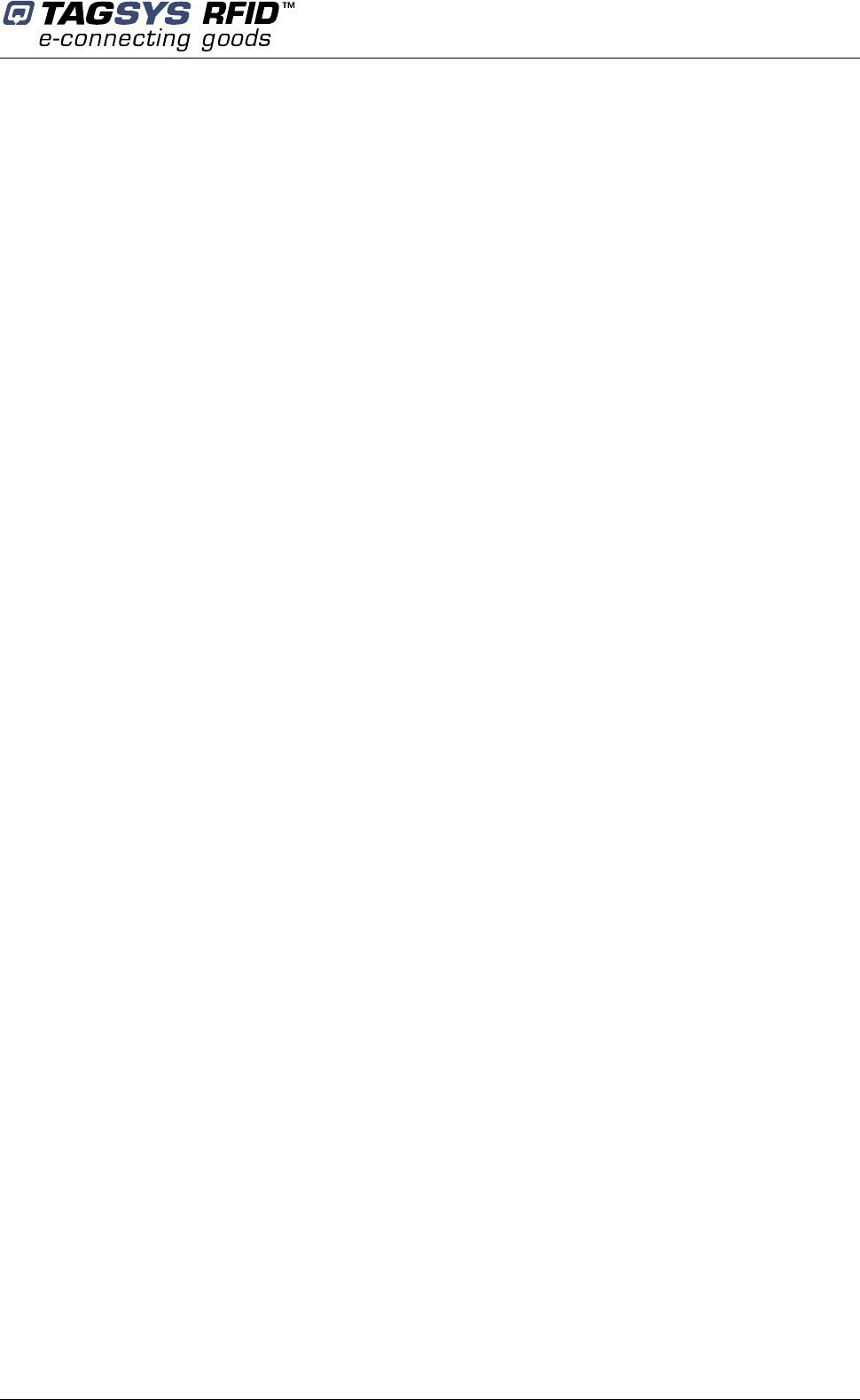
Advanced Notions
February 2008 Revision 1.3 39/50
5.2.5 Standalone mode
Standalone mode makes it possible to use the reader without the need for a host to control it. In
this case, only the tag reading operation is available.
When standalone mode is activated, the reader automatically loads its last saved configuration
upon start-up and initiates a read session. Each time a read event occurs, the reader sends a
frame over its serial port. Frame format is as the following (all fields are ASCII, optional and
customizable):
<Header><Timestamp><Radio ID><Event Type><Channel><Tag Type><Tag Data><Footer>
A watchdog can also be activated. In this case, a customizable frame is sent periodically over the
serial port to indicate the reader is operating properly.
For more information about standalone mode operation and configuration, please refer to Medio
L400 Designer’s guide.
5.3 Reader operation principles
Most of the reader commands are executed in a synchronous manner. This means that the reader
waits for an incoming request from the host, executes the associated operation then sends a reply
containing operation execution status back to the host. Between the reception of two consecutive
commands, the reader does nothing but wait for the next command.
The following commands are examples of commands executed in a synchronous manner :
• Configuration commands (configuring the TCP/IP stack, for example).
• Tag writing commands (writing an ISO15693 tag memory block, for example).
• Most tag reading commands (reading the locking status of an ISO15693 tag memory block,
for example).
Synchronous commands that actually perform an operation on tags in the RF field (such as a
writing operation, opposed to a configuration command) can only use a single channel (multiplexer
can not be used). The channel and RF power that should be used for any subsequent synchronous
tag operation is called the default RF configuration (specific commands exist to get/set this
configuration).
An exception to the mechanism described above exists: the asynchronous read (or default read).
Asynchronous read (or default read) can be activated or deactivated using the appropriate
commands in the command set. During asynchronous read, the reader continuously tries to read
all tags in the field. When a tag is detected, one or several read events are asynchronously pushed
into an internal buffer (the event buffer). The host system then needs to poll the event buffer
periodically to retrieve the latest events.
One can specify the kind of read events that should be reported during asynchronous read, as well
as several options (called read modes) that should be applied during asynchronous read. The
following sections provide more details about the different read events, as well as the different read
modes.
5.3.1 Notion of read modes
During asynchronous read (or default read), the reader continuously tries to read all tags in the RF
field. Several options can be applied that modify the reader’s behavior during asynchronous read:
• “Multiplexer” : If this mode is active, the reader uses the multiplexer instead of the default
RF configuration for reading. The multiplexer makes it possible to define a sequence of

Medio L400
40/50 Revision 1.3 February 2008
antennas, tag types and RF output powers that will be automatically used during the
reading process. For example, a user can configure the multiplexer so that reader tries to
read ISO15693 tags for 100ms on channel 1 at 1Watt, then ICode UID tags for 50ms on
channel 1 at 2Watts, then ISO15693 tags for 100ms on channel 2 at 1Watt, then ICode UID
tags for 50ms on channel 2 at 2Watts.
• “Input triggered” : If this mode is active, the reader waits for GPIO Input #1 to become
active in order to activate the RF field and start reading. When GPIO Input #1 gets back to
inactive state, RF field is turned off and the reader stops reading until input is active again.
Active input level (low or high) is software configurable.
• “Output feedback” : If this mode is active, the reader uses GPIO Outputs #1, #2 and #3 to
signal reading activity. GPIO Output #1 is activated when the reader is attempting to read
tags, GPIO Output #2 is activated when the reader “sees” tags in the RF field. In input
triggered read mode GPIO Output #3 is activated when the trigger condition ends and no
tag was detected in the RF field. When Input triggered read mode is inactive, GPIO Output
#3 remains inactive. The time an output remains active after the corresponding event has
occurred is software configurable.
A user can activate one or several read modes at once, depending on the application
requirements.
5.3.2 Notion of events
During asynchronous read (or default read), the reader continuously tries to read all tags in the RF
field. When a tag is detected, one or several events are pushed into an internal event buffer. Those
events contain information such as the kind of event (see below), a timestamp, the channel on
which the event occurred, the tag type and the associated tag data (UID, memory…). The following
events are supported :
• “Tag Read” : This event is pushed each time a valid tag frame is decoded, without further
processing. When activated, this event may be triggered several hundreds of times per
second and is consequently bandwidth consuming. It is often used for testing purpose only.
• “Tag New” : This event is pushed each time a new tag is detected. If the same tag is
detected several times, it will be reported only once.
• “Tag In” : This event is pushed each time a tag enters the RF field.
• “Tag Out” : This event is pushed each time a tag leaves the RF field.
• “Tag No Read” : When Input triggered read mode is active, this event is pushed when the
trigger condition ends and no tag was detected in the RF field. When Input triggered read
mode is inactive, this event is never pushed.
A user can register for one or several events at once, depending on the application requirements.
For example, if a user registers for all events and a tag enters the RF field, stays in the field for
some time, then leaves the field, the sequence of events pushed into the event buffer will be:
• “Tag Read”
• “Tag New”
• “Tag In”
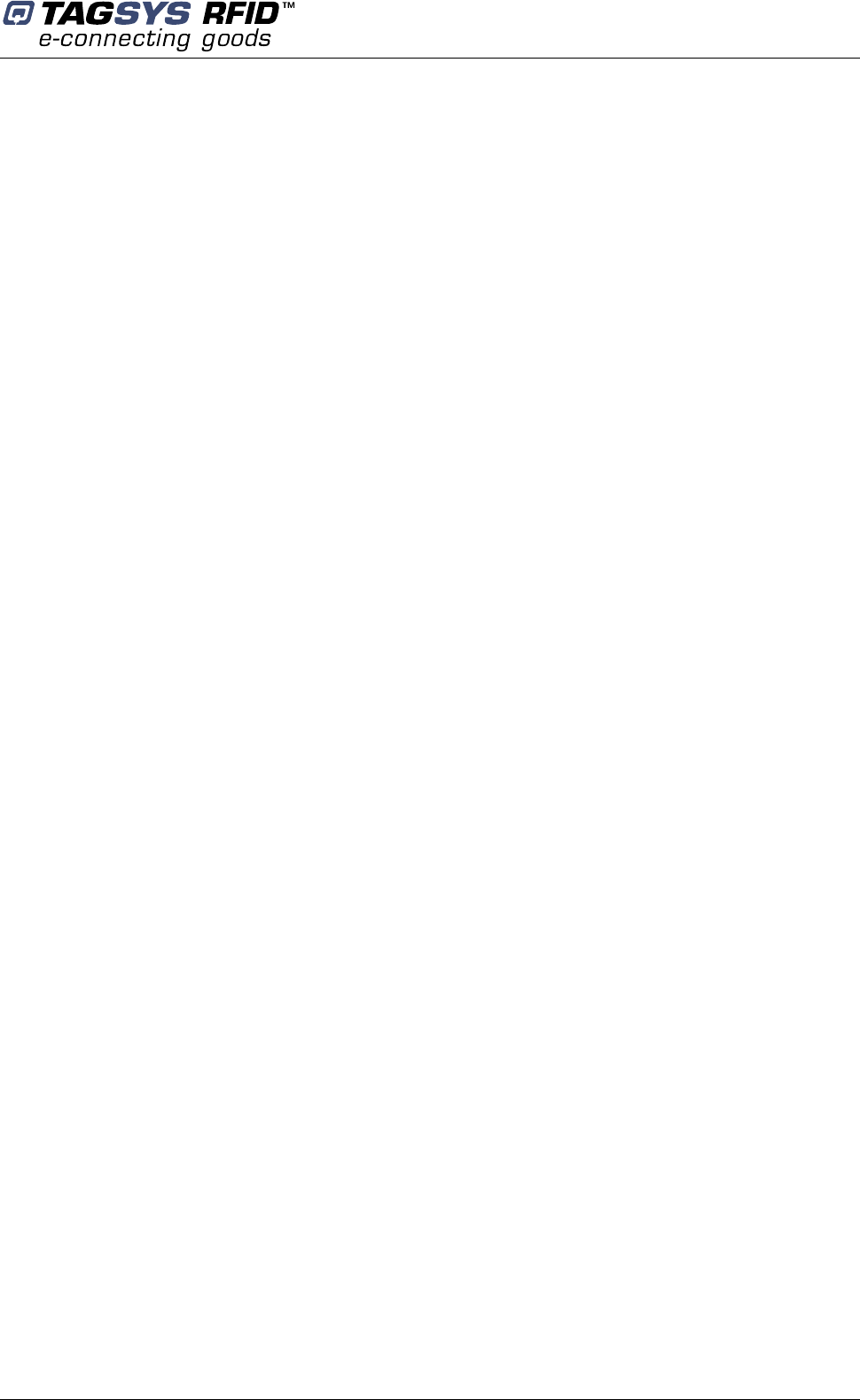
Advanced Notions
February 2008 Revision 1.3 41/50
• “Tag Read” (repeated as long as the tag remains in the field)
• “Tag Out”
If the same tag re-enters the RF field at a later time, stays in the field for a period of time, then
leaves the field, the sequence of events pushed into the event buffer will be :
• “Tag Read”
• “Tag In”
• “Tag Read” (repeated as long as the tag remains in the field)
• “Tag Out”
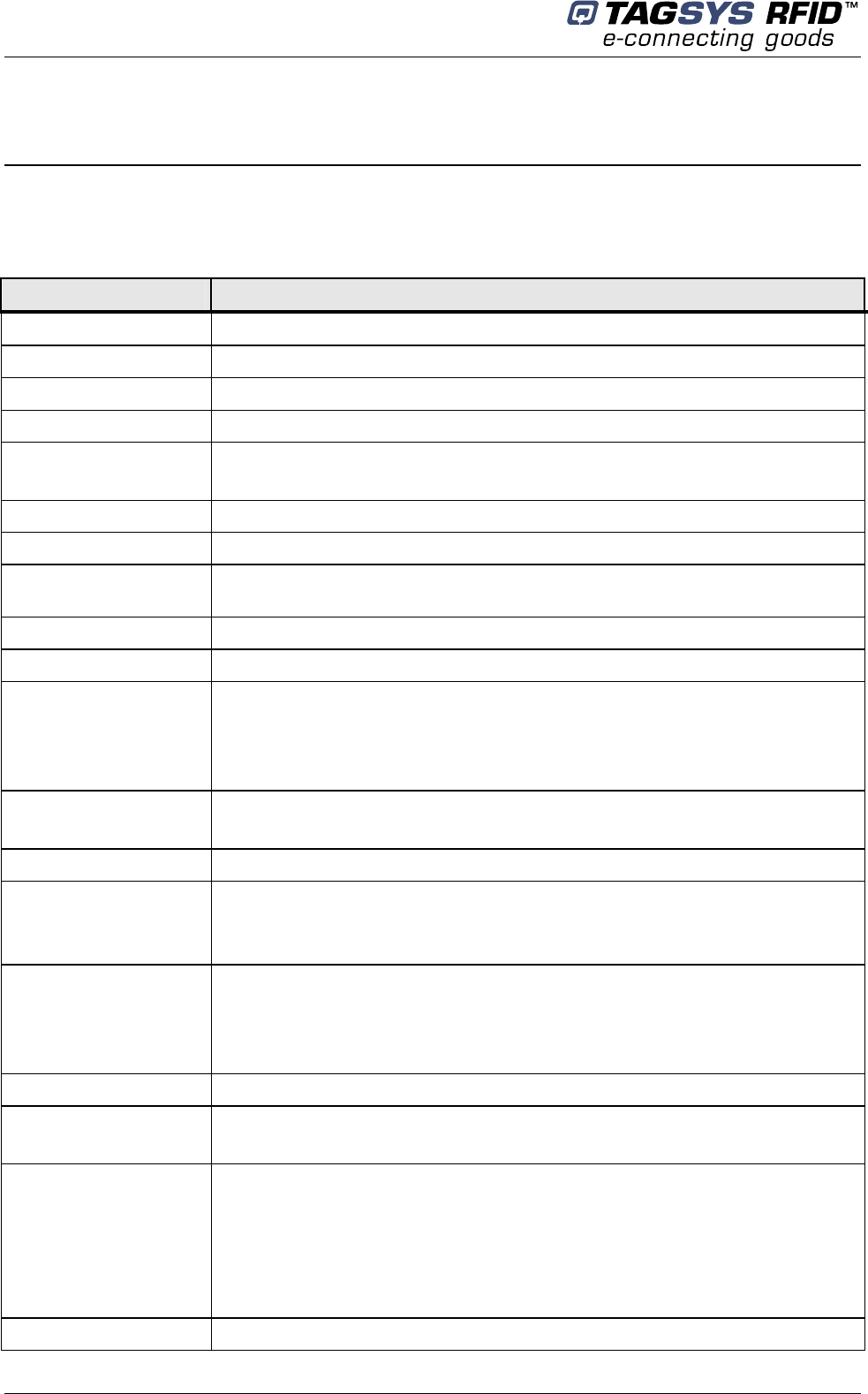
Medio L400
42/50 Revision 1.3 February 2008
6 Technical Specifications
6.1 Technical Data
Table 8: Medio L400 Technical Specifications
Description Medio L400
Size (L x W x H) 285 x 195 x 90 mm (11.3 x 7.7 x 3.6 in.)
Weight 3.4 kg (7.5 lbs.)
DC power 24 VDC +/- 10% Typical
Power consumption Up to 40 W
Operating temperature Reader : 0°C to +55°C (32°F to 131°F)
Power Supply : 0°C to +40°C (32°F to 104°F)
Storage temperature -20° to +70°C (–4°F to 158°F)
Mechanical fixation Rubber pads or screw cutting hole for vertical installation
Certification ETSI EN 300-330, ETS 300-683, FCC Part 15 (for typical configurations), UL
60950, CAN/CSA 22.2 No 60950, IEC 60950-1, CB Report with certificate.
Antenna Compatibility 50-Ohms antenna
Operating Frequency 13.56 MHz
Chip Compatibility ISO15693 ISO18000-3 Mode 1
C370 (I-Code SLI) C270 (I-Code 1)
I-Code ePC I-Code UID
Upgradable to EPCglobal HF Gen2 protocol
Number of channels 2 (Medio L400-2)
4 (Medio L400-4)
RF Output Power 500mW to 5W (+/-10%)
Communication
Interfaces
RS232 (up to 115200 bauds)
USB 1.1
10/100 Ethernet
Communication
Protocols
Tagsys StxNG
Telnet & Serial Console
Standalone Mode
Heartbeat
I/O Ports (GPIO) 4 Inputs, 4 Outputs
User Interface LCD Screen With Backlight (2x16 Characters)
Keypad (Up, Down, Select)
Remote Monitoring System uptime // Current number of connections per interface // Date of last
connection per interface // Total number of connections per interface since power-
up // Total amount of bytes sent/received per interface since power-up // Internal
operating temperature // Digital Output overload status // Read/Write count per
channel // RF power amplifiers consumption // RF power amplifiers operating
temperature // Antennas tuning status // Noise Level on I&Q receivers // Real
Time raw signal capture
Firmware Remotely upgradeable
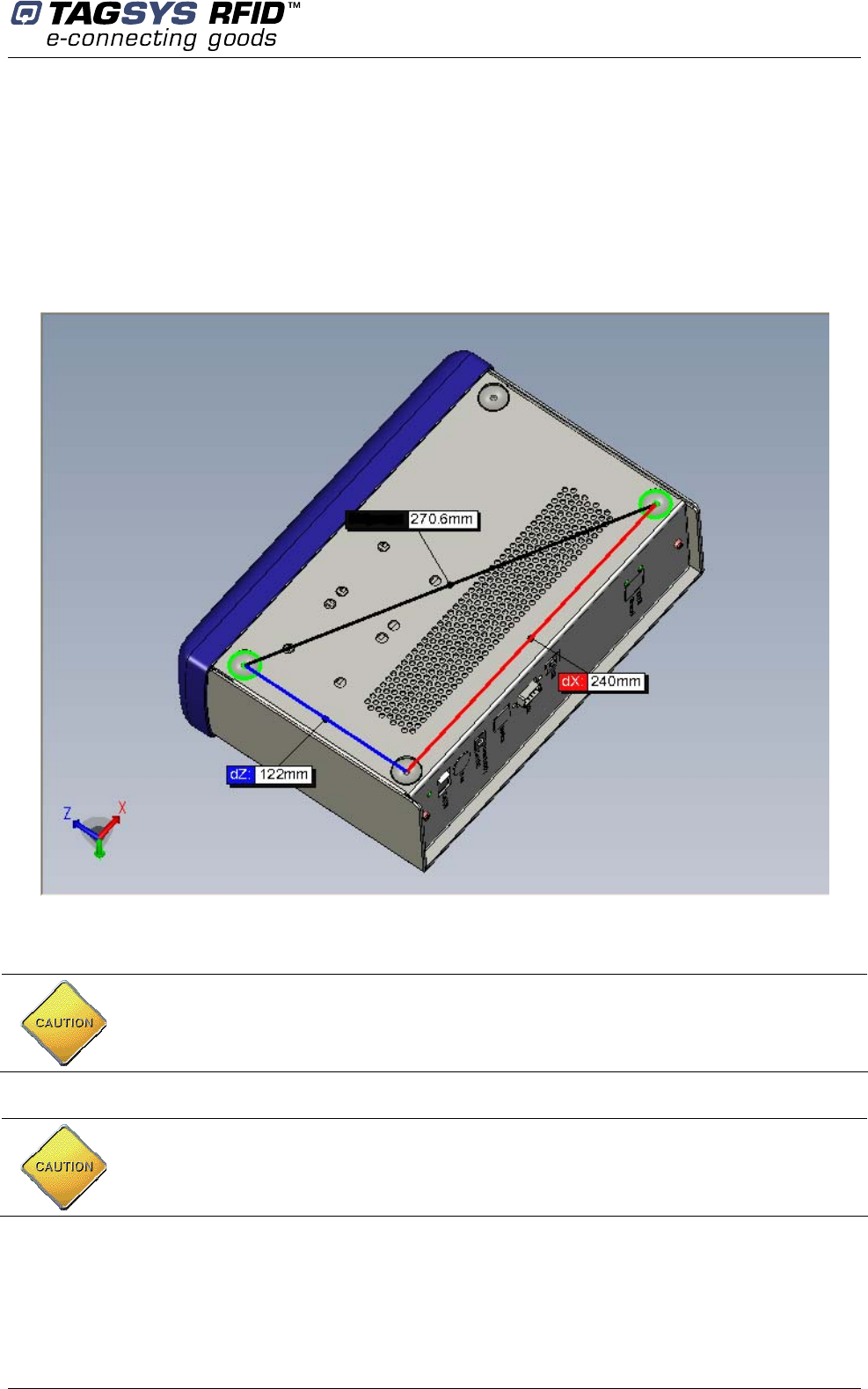
Technical Specifications
February 2008 Revision 1.3 43/50
6.2 Mechanical Data
The Medio L400 reader is delivered with four rubber pads on the bottom of the case for installation
on a table or desktop. The rubber pads can be removed to access the M4 screw cutting holes that
can be used to mount the unit in various positions. The figure below gives details about the screw
cutting hole positioning.
Figure 20: Screw-cutting hole Positioning
The top and bottom ventilation grids must never be blocked and must be kept clean and free
of dust. Clean with a dry cloth if required.
Be advised of the thickness of the plastic front frame when mounting it.
Please see Figure 21
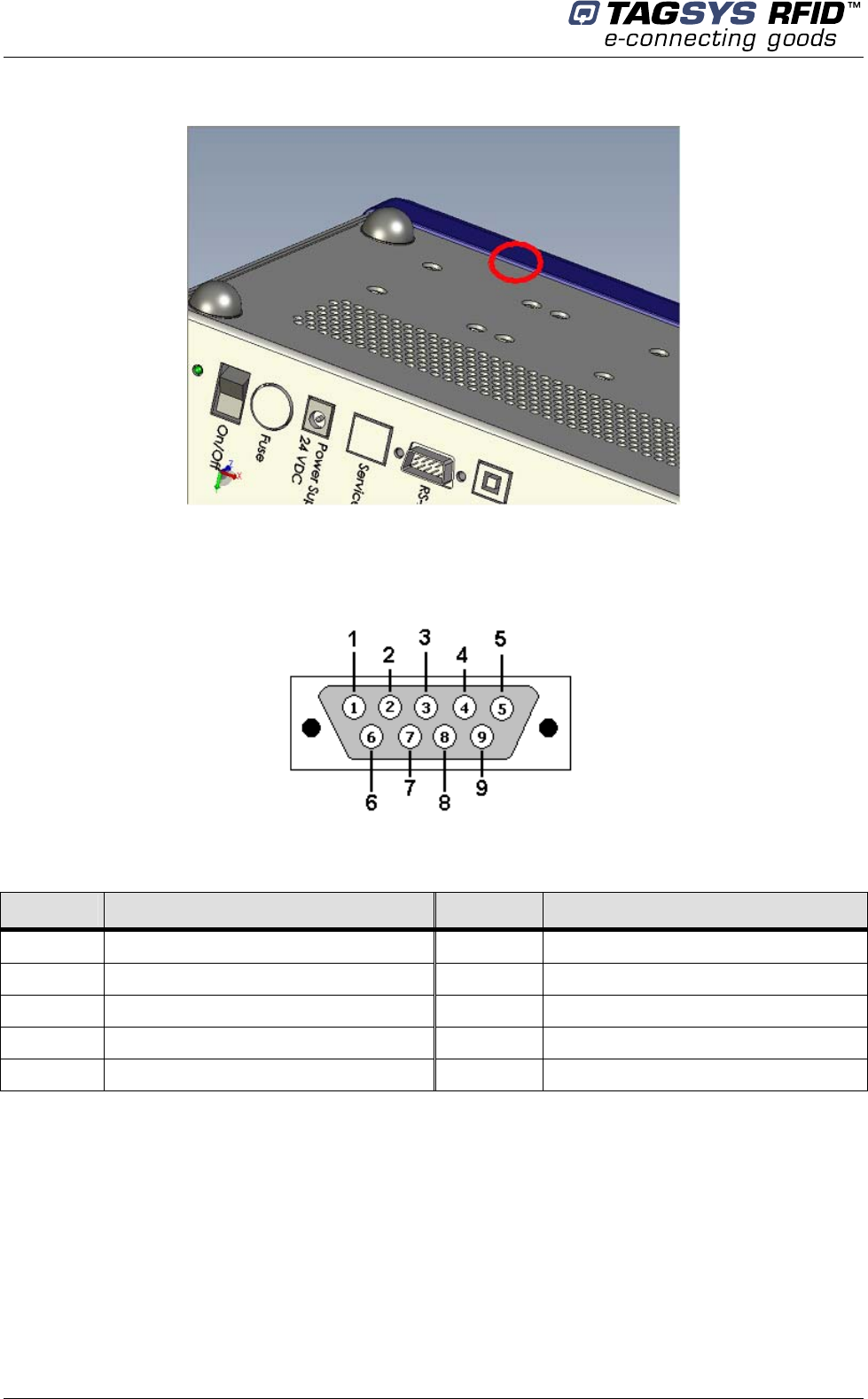
Medio L400
44/50 Revision 1.3 February 2008
Figure 21: Back view of the Medio L400
6.3 RS232 Connector
Figure 22: RS-232 Connector (Male DB-9)
Table 9: RS-232 Connector Pin Assignment
Pin Description Pin Description
1 Not connected 6 Not connected
2 RXD 7 RTS (internally connected to CTS)
3 TXD 8 CTS (internally connected to RTS)
4 Not connected 9 Not connected
5 GND
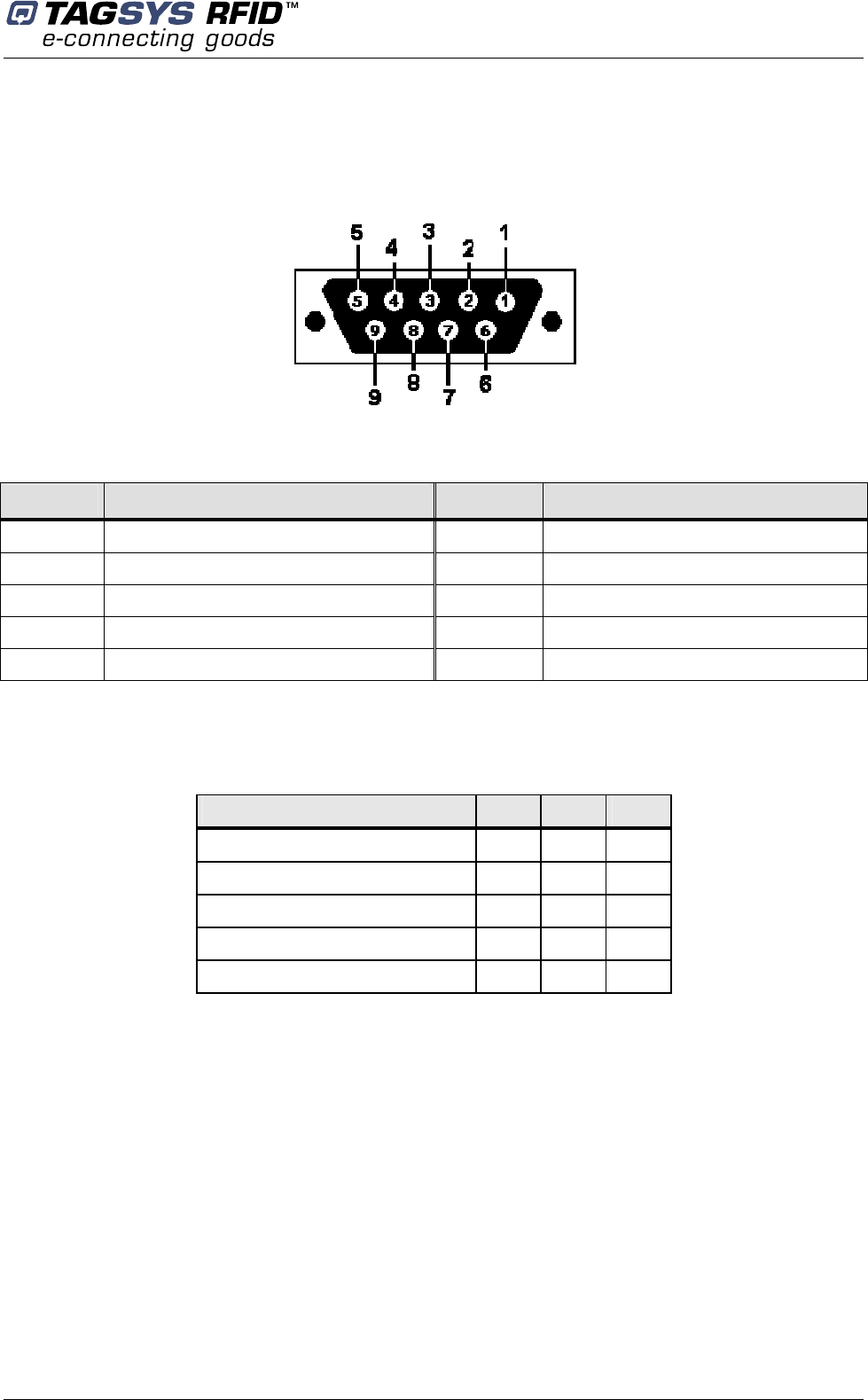
Technical Specifications
February 2008 Revision 1.3 45/50
6.4 GPIO Connector
6.4.1 Pin Assignment
Figure 23: GPIO Connector (Female DB-9)
Table 10: GPIO Connector - Pin Assignment
Pin Description Pin Description
1 Input #1 6 Output #1
2 Input #2 7 Output #2
3 Input #3 8 Output #3
4 Input #4 9 Output #4
5 Gnd
6.4.2 Electrical Characteristics
Table 11: GPIO Pins - Electrical Characteristics
Parameters Min. Max. Unit
Maximum Input Voltage 28 V
Input Voltage (Low) 0 0.9 V
Input Voltage (High) 1.5 28 V
Maximum Output Current 2.8 A
Maximum Output Voltage 28 V
6.4.3 Using Inputs
Reader inputs can be driven by a voltage source from 0V up to 28V referring to the ground.
Voltages under 0.9V are considered as “logical low state”, voltages above 1.5V are considered as
“logical high state”. Inputs are internally pulled-up to 3.3V with 1KOhms resistors. Applying
negative voltage to inputs (polarity inversion) may destroy them.
Figure 24 below demonstrates how to connect an external sensor (a simple switch or a totem pole
output sensor) to an input.
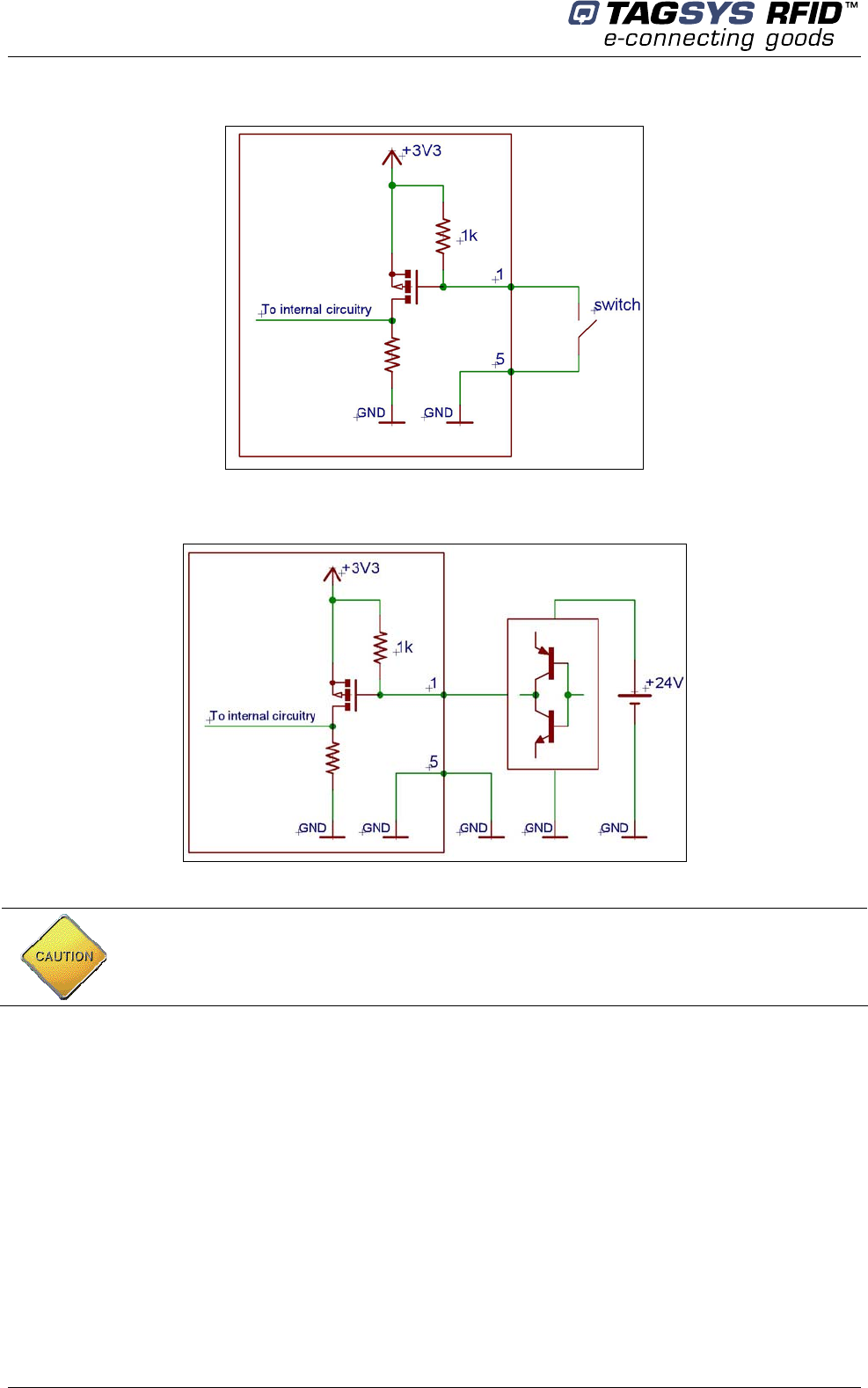
Medio L400
46/50 Revision 1.3 February 2008
Figure 24: Connecting a simple switch to input #1
Figure 25: Connecting a totem-pole output sensor to input #1
External devices must be connected to GPIOs in compliance with Table 10 and SELV
requirements.
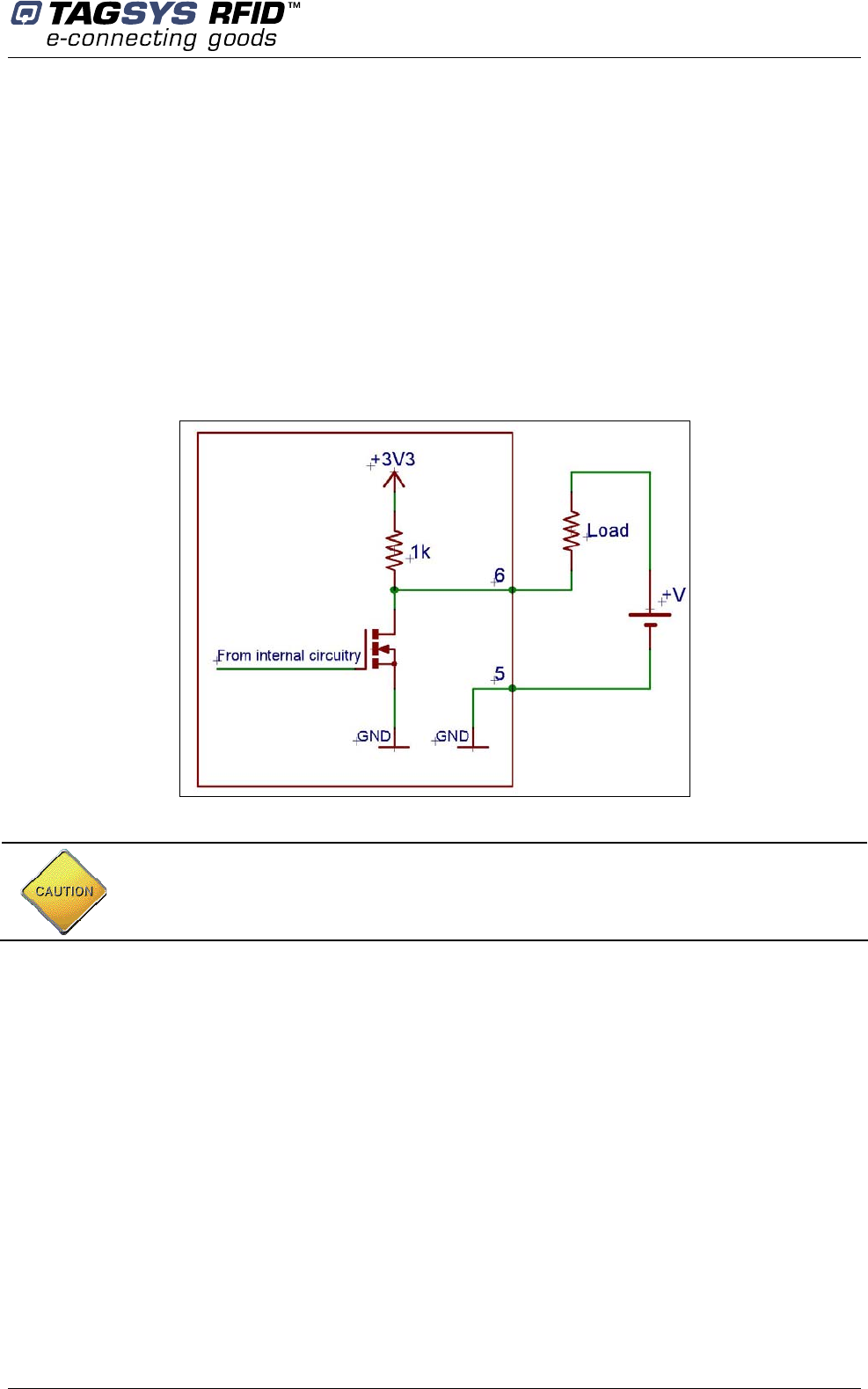
Technical Specifications
February 2008 Revision 1.3 47/50
6.4.4 Using Outputs
The reader outputs are Open Drain, N-Channel (when activated, an output is tied to the ground).
They can drive a current up to 2.8A, and accept voltages up to 28V. Outputs are internally pulled-
up to 3.3V with 1KOhms resistors and are protected against overload and overheat. Applying
negative voltage to outputs (polarity inversion) may destroy them.
Figure 26 below demonstrates how to connect an external load to an output.
Figure 26: Connecting an external load to output #1
External devices must be connected to GPIOs in compliance with Table 10 and SELV
requirements.
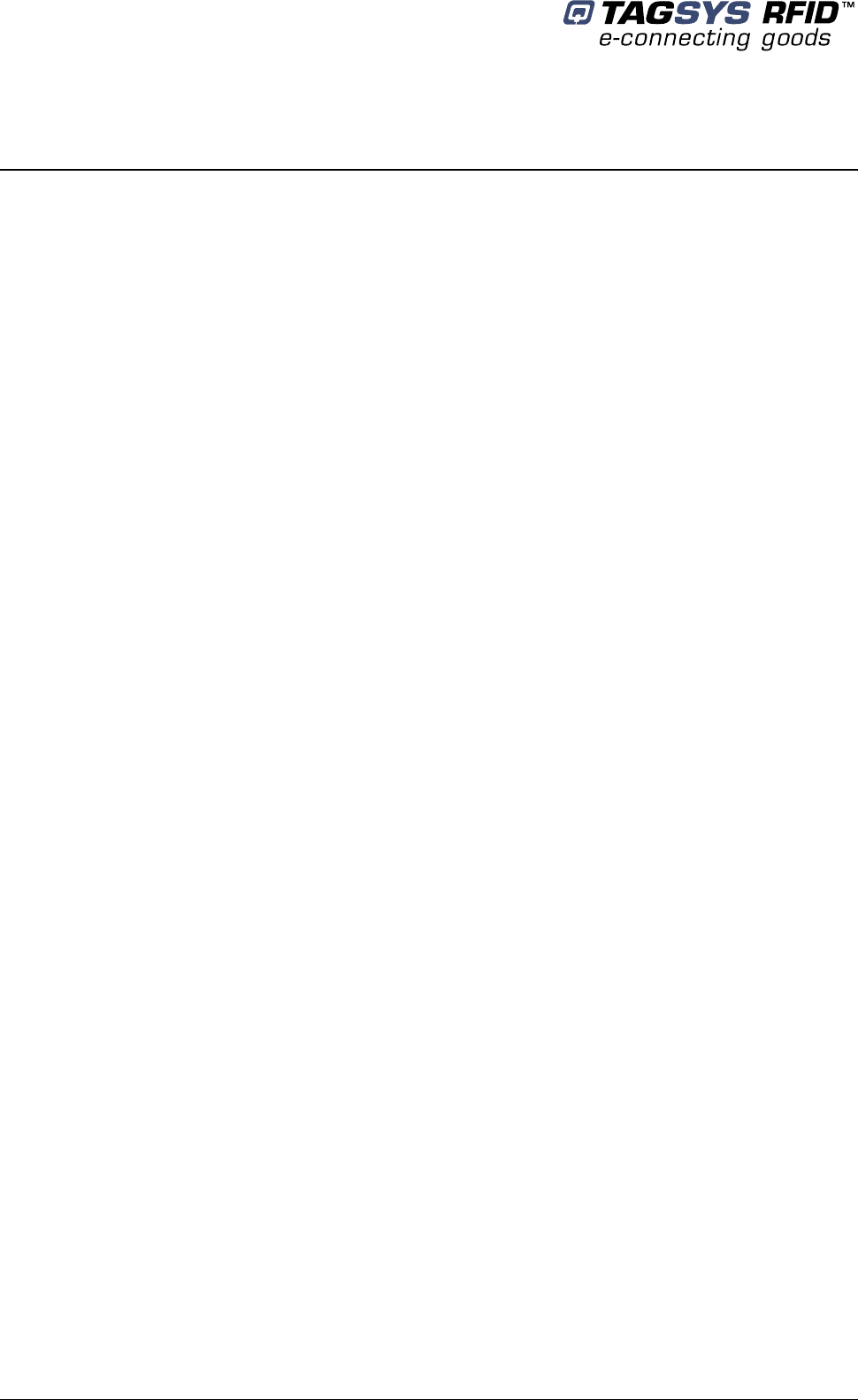
Medio L400
48/50 Revision 1.3 February 2008
7 Warranty Conditions
7.1 Warranty
TAGSYS warrants that this Product shall comply with the functional specifications set forth herein
for a period of one year from the date of delivery to the Buyer.
This warranty is valid for the original Buyer of the Product and is not assignable or transferable to
any other party.
TAGSYS cannot be responsible in any way for, and disclaims any liability in connection with the
operation or performance of:
any product in which the Product is incorporated;
any equipment not supplied by TAGSYS which is attached to or used in connection with the
Product; or
the Product with any equipment
This warranty does only cover the Product to the exclusion of any such other equipment.
Optimal operation and performance of the Product are obtained by using TAGSYS’ readers, by
applying TAGSYS installation guidelines and by having your installation reviewed by a TAGSYS’
technical consultant.
TAGSYS warranty does not cover the installation, maintenance or service of the Product and is
strictly limited to the replacement of Products considered as defective by TAGSYS and returned
according to the return procedure defined below; in such case, TAGSYS will, at TAGSYS’ option,
either replace every defective Product by one new Product or refund the purchase price paid by
Buyer to TAGSYS for the defective Product.
7.2 Warranty Exclusions
Defects or damages resulting from storage of the Product under conditions which do not
comply with TAGSYS specifications or normal usage
Defects or damages resulting from use of the Product in abnormal conditions (abnormal
conditions being defined as any conditions exceeding the ones stated in the product
specifications).
Defects or damages from misuse, accident or neglect.
Defects from improper testing, operation, maintenance or installation.
Defects from alteration, modification except modifications or adjustments specifically described
in this Product reference guide, adjustment or repair, or any attempt to do any of the foregoing,
by anyone other than TAGSYS.
Any action on Product that prevents TAGSYS from performing an inspection and test of the
Product in case of a warranty claim.
Tampering with or abuse of the Product.
Any use or incorporation by the Buyer or a third party of TAGSYS' Product into life saving or life
support devices or systems, or any related products; TAGSYS expressly excludes any liability
for such use.
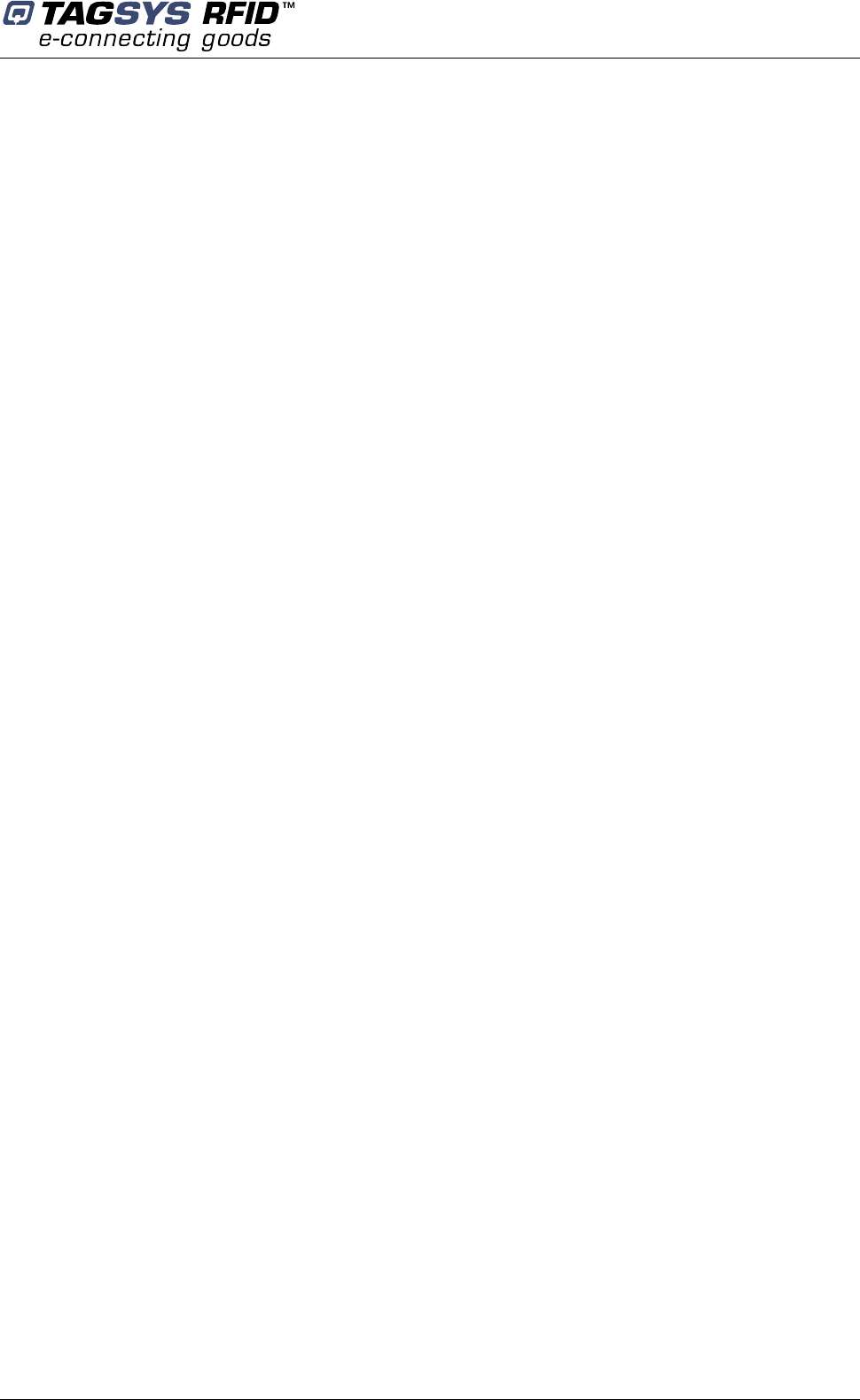
Warranty Conditions
February 2008 Revision 1.3 49/50
7.2.1 General Provisions
This warranty sets forth the full extent of TAGSYS responsibility regarding the Product.
In any event, TAGSYS warranty is strictly limited to (at TAGSYS’ sole option) the replacement or
refund of the Products purchase price to TAGSYS, of Products considered as defective by
TAGSYS.
The remedy provided above is in lieu and to the exclusion of all other remedies, obligations or
liabilities on the part of TAGSYS for damages, whether in contract, tort or otherwise, and including
but not limited to, damages for any defects in the Products or for any injury, damage, or loss
resulting from such defects or from any work done in connection therewith or for consequential
loss, whether based upon lost goodwill, lost resale profits, impairment of other goods or arising
from claims by third parties or otherwise.
TAGSYS disclaims any explicit warranty not provided herein and any implied warranty, guaranty or
representation as to performance, quality and absence of hidden defects, and any remedy for
breach of contract, which but for this provision, might arise by implication, operation of law, custom
of trade or course of dealing, including implied warranties of merchantability and fitness for a
particular purpose.
7.2.2 How to Return Defective Products
The Buyer shall notify TAGSYS of the defects within 15 working days after the defects are
discovered.
Defective Products must be returned to TAGSYS after assignment by a TAGSYS Quality
Department representative of an RMA (Return Material Authorization) number. No Products shall
be returned without their proof of purchase and without the acceptance number relating to the
return procedure.
All Products shall be returned with a report from the Buyer stating the complete details of the
alleged defect.
Call +33 4 91 27 57 36 for return authorization and shipping address.
If returned Products prove to be non-defective, a charge will be applied to cover TAGSYS’ analysis
cost and shipping costs.
If the warranty does not apply for returned Products (due to age, or application of a warranty
exclusion clause), a quote for replacement will be issued, and no replacement will be granted until
a valid purchase order is received. If no purchase order is received within 30 days after the date of
TAGSYS quote, TAGSYS will return the products and charge the analysis cost and shipping costs.
All replaced Products shall become the property of TAGSYS.
The Product Return Form is included on the following page. This form should accompany any
product you need to return to TAGSYS for analysis in the event of a problem.
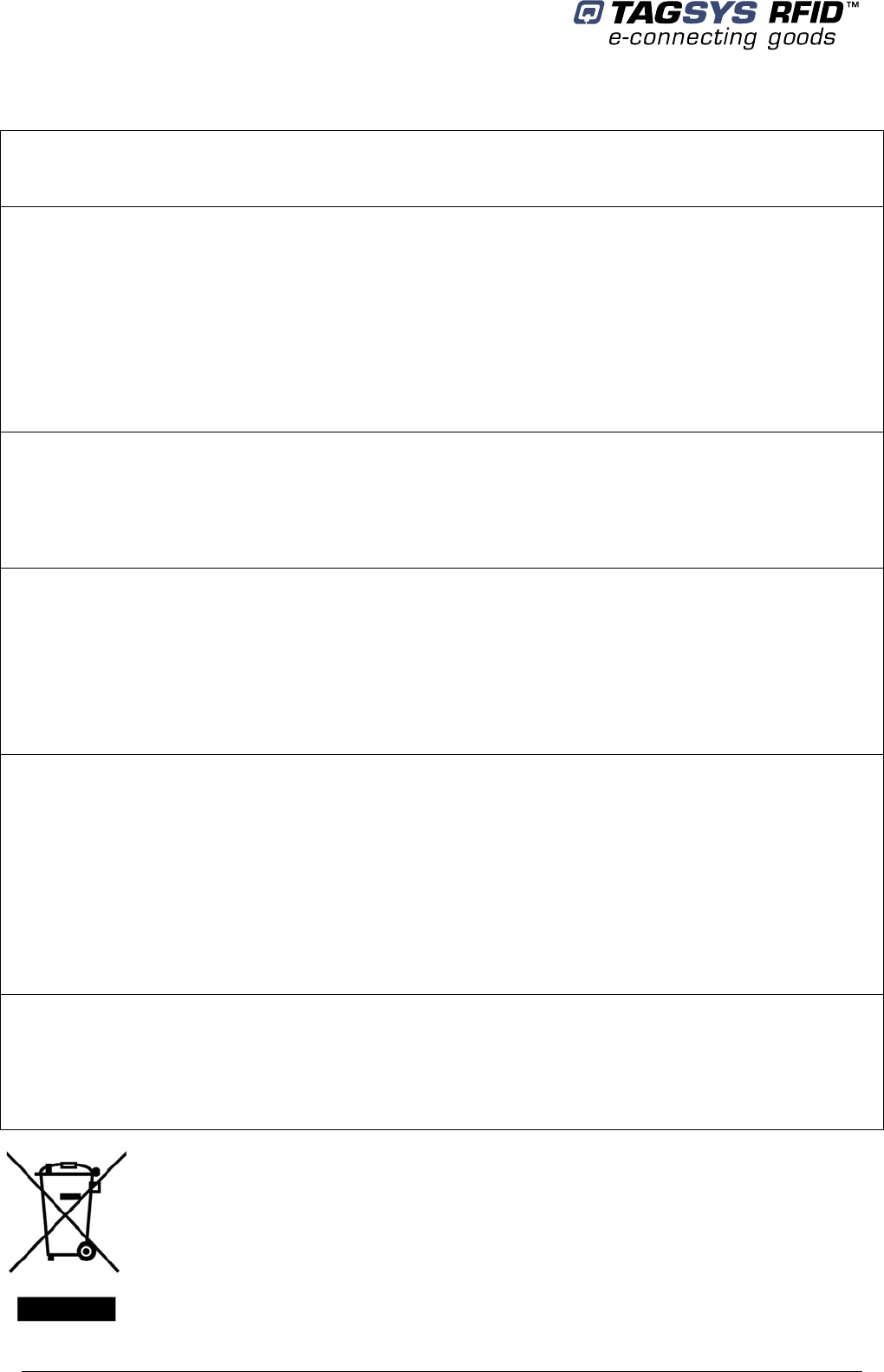
Medio L400
50/50 Revision 1.3 February 2008
Product Return Form
Customer Profile:
Company: ................................................................
Address: ..................................................................
.................................................................................
.................................................................................
City & State:.............................................................
Zip Code: .................................................................
Country: ...................................................................
Contact Name: .......................................................
Contact e-mail: ......................................................
Contact Phone: ......................................................
Contact Fax:...........................................................
Order identification:
Product Name:.........................................................
Order Number (OEF):..............................................
Invoice Number: .....................................................
Return Quantity: ....................................................
Reason for return:
.........................................................................................................................................................................
.........................................................................................................................................................................
.........................................................................................................................................................................
.........................................................................................................................................................................
.........................................................................................................................................................................
To inform TAGSYS of this return, please email it to
RMA@tagsysrfid.com
Address to ship the product with this document attached:
TAGSYS
QUALITY DEPARTMENT
180, Chemin de Saint Lambert
13821 La Penne sur Huveaune France
To inform TAGSYS of this return, please also fax it to your Customer Service Representative
+33 491-275-701
Return Procedure:
The product returned will go through stringent quality controls.
A final analysis report will be sent to you as soon as possible.
Please contact your Quality Service representative for further details.
+33 491-275-736
This product bears the selective sorting symbol for waste electrical and electronic equipment
(WEEE)
This means that this product must be handled pursuant to European Directive 2002/96/EC in
order to be recycled or dismantled to minimize its impact on the environment.
For further information, please contact your local or regional authorities.